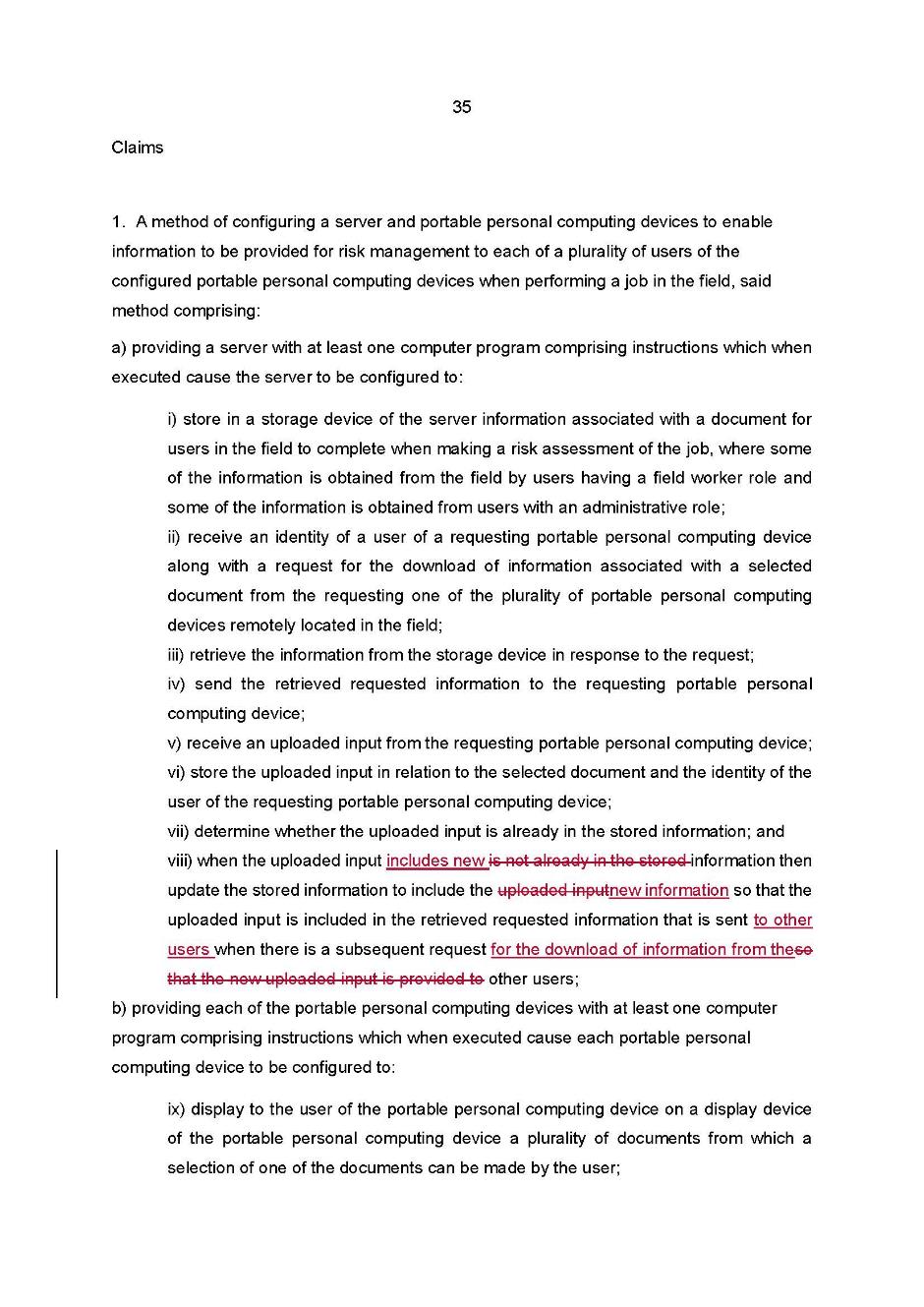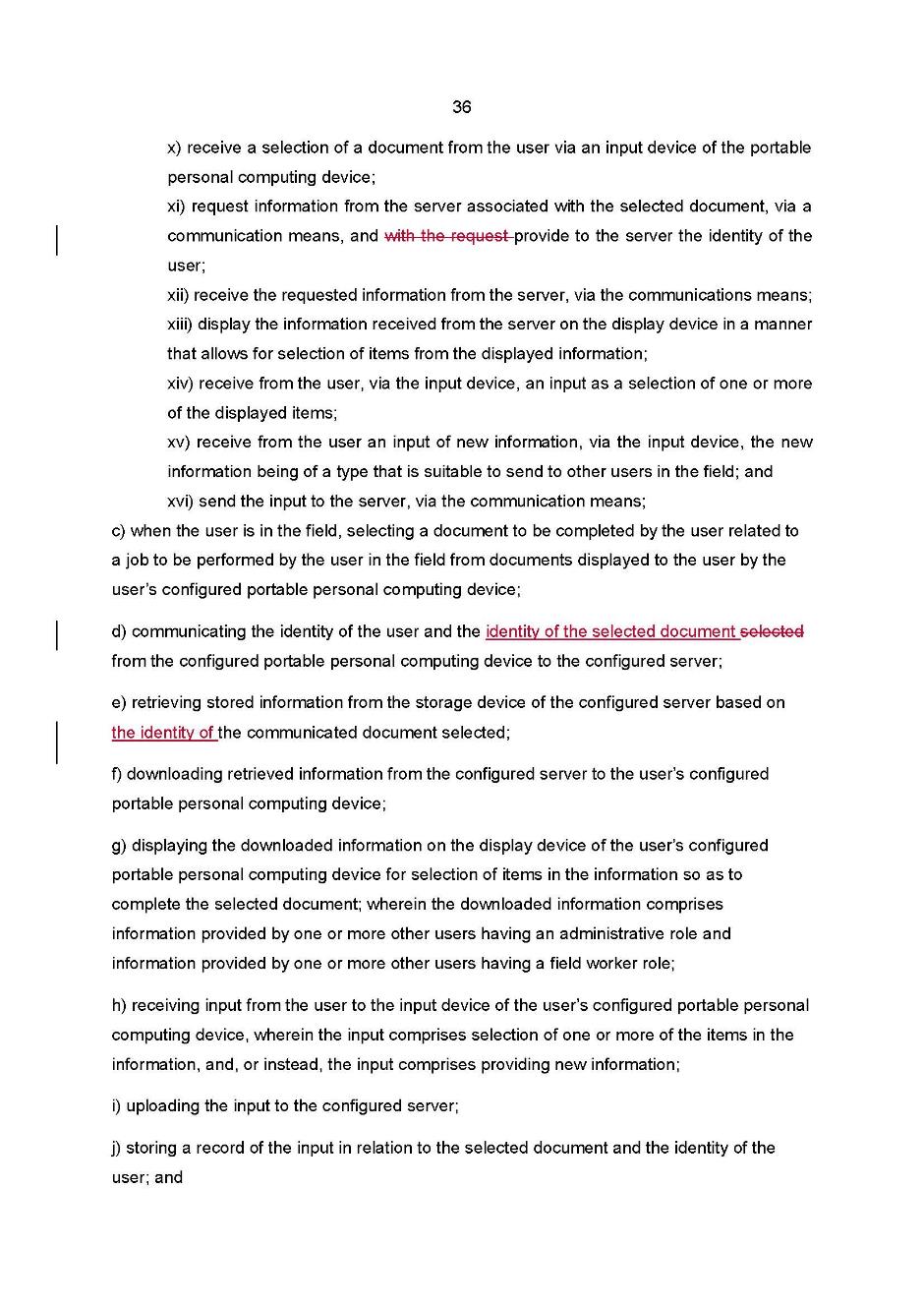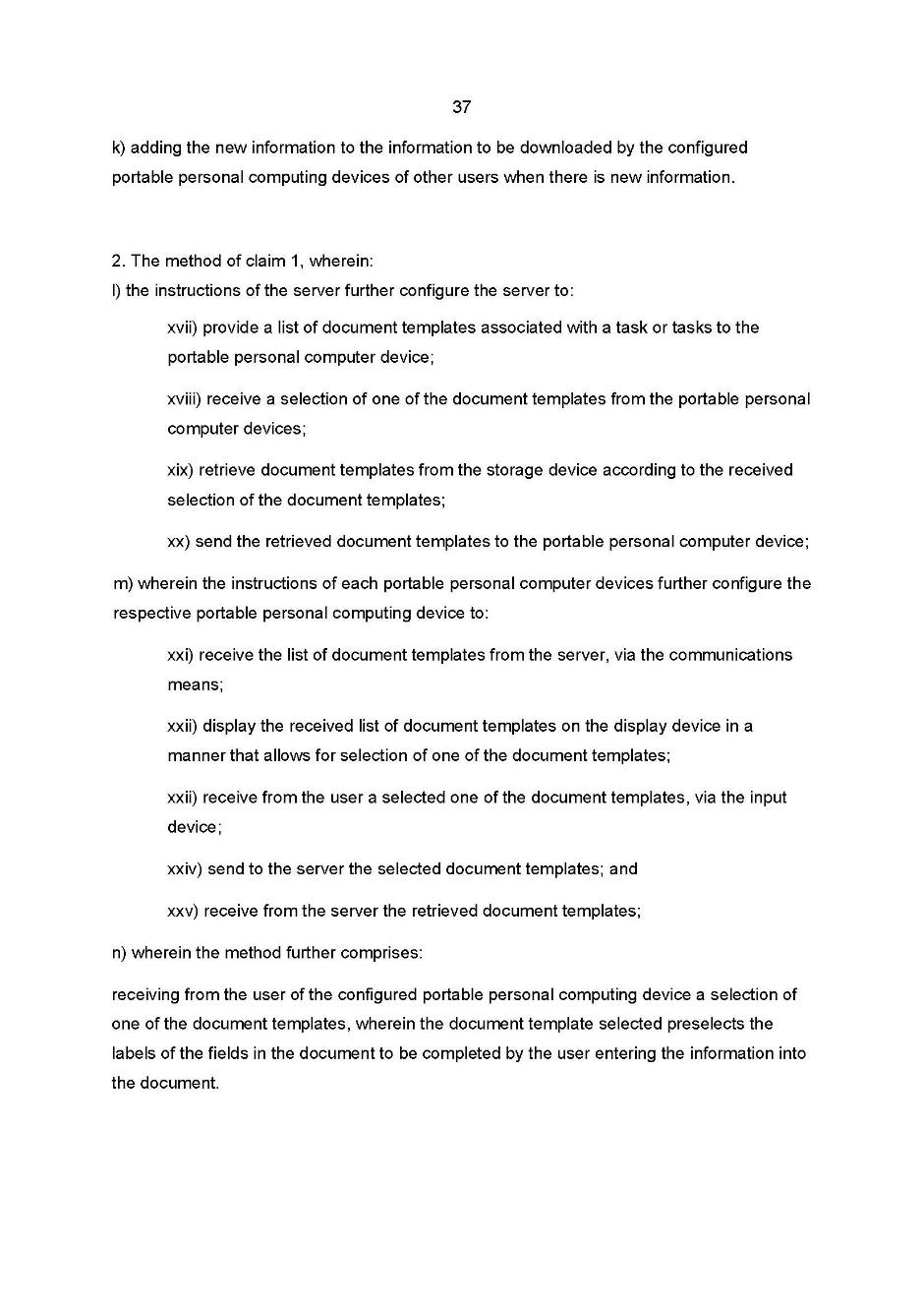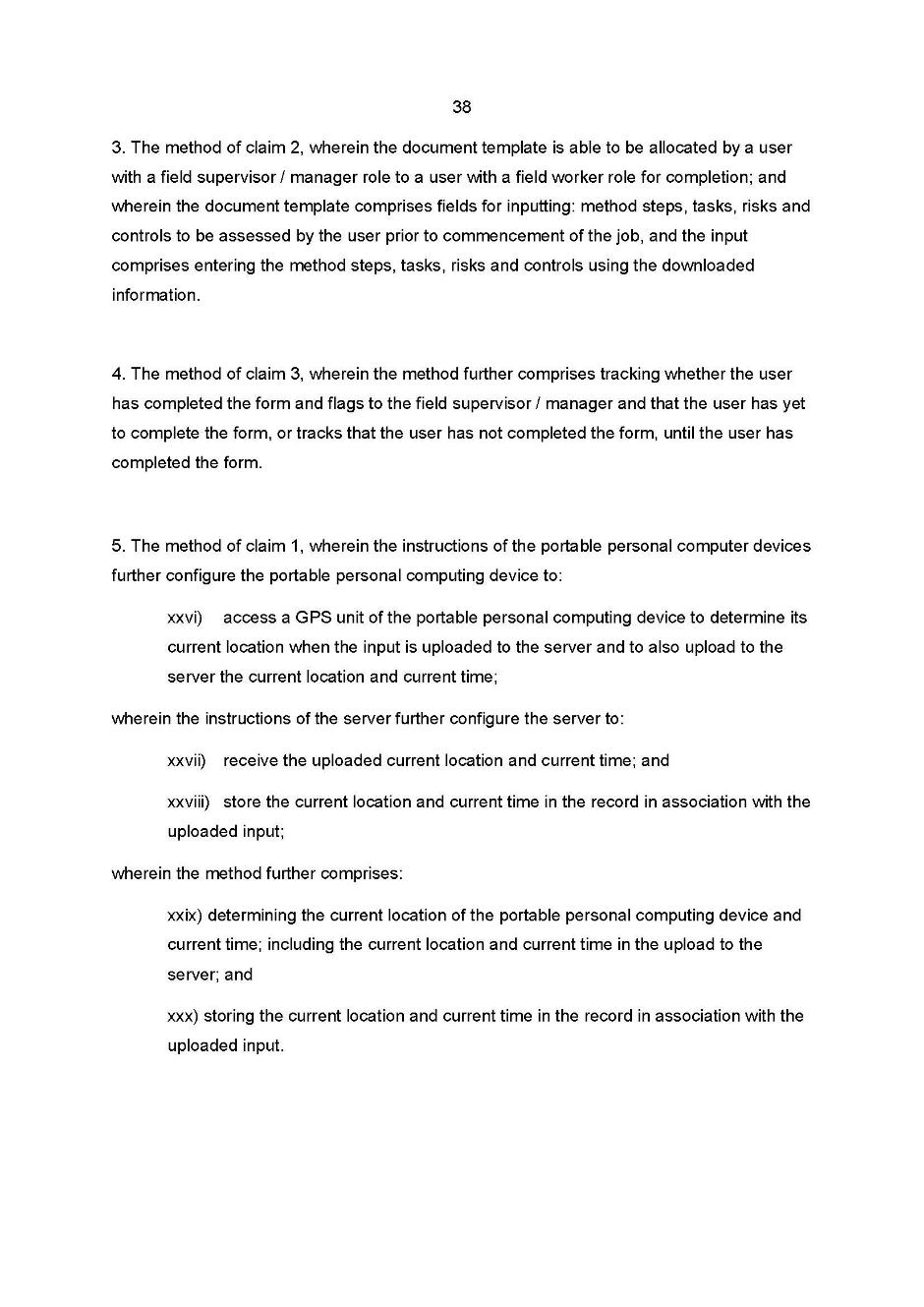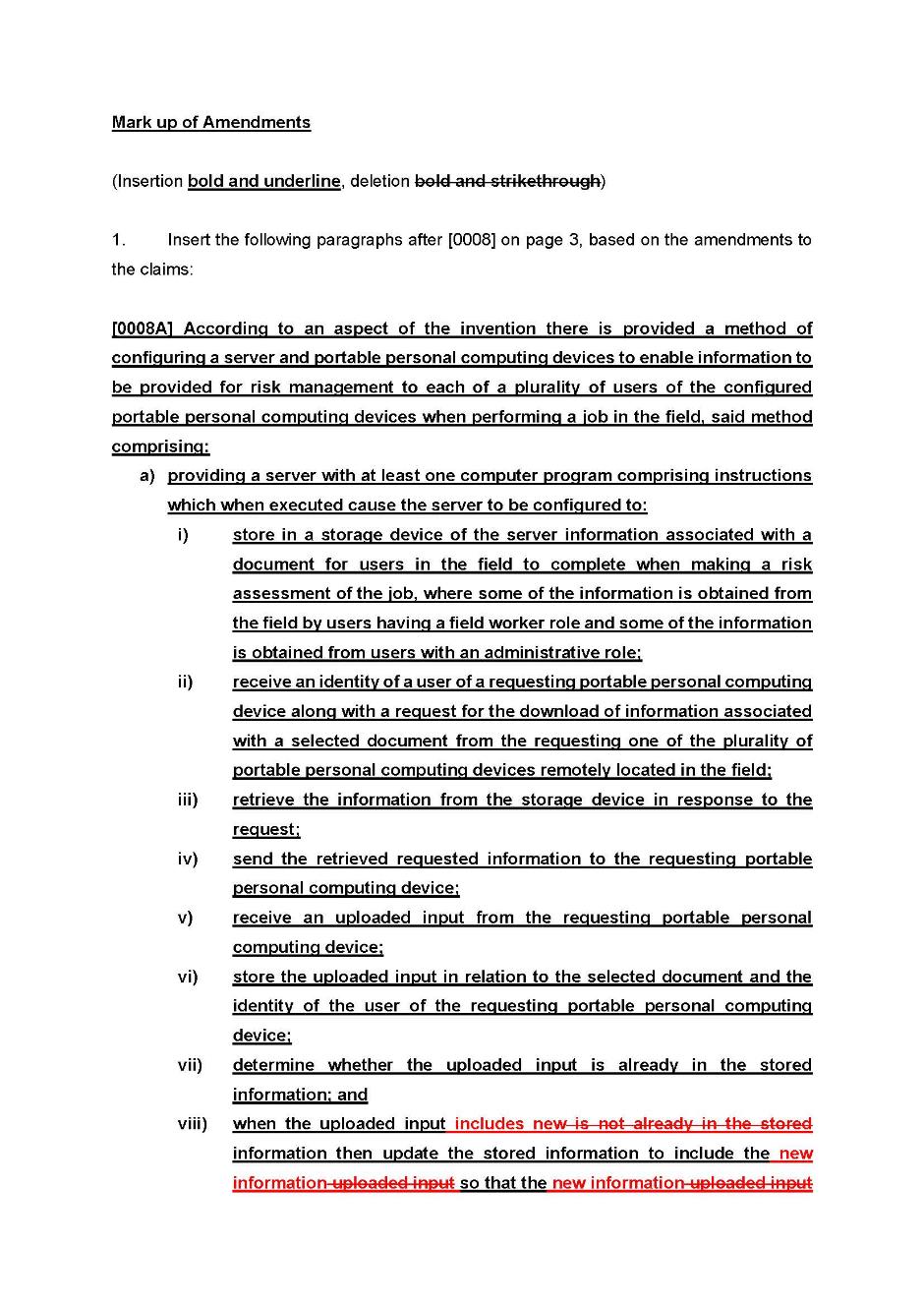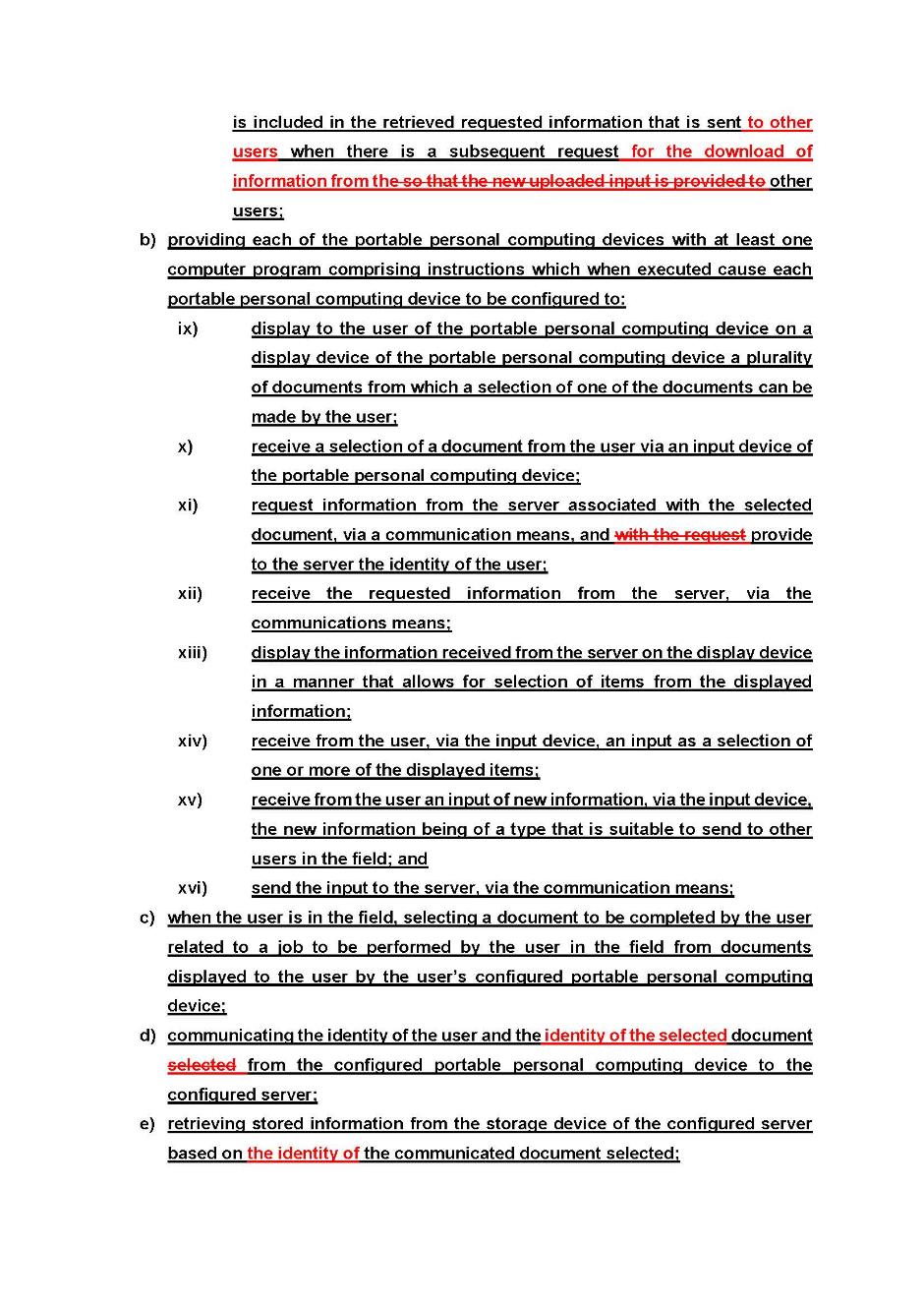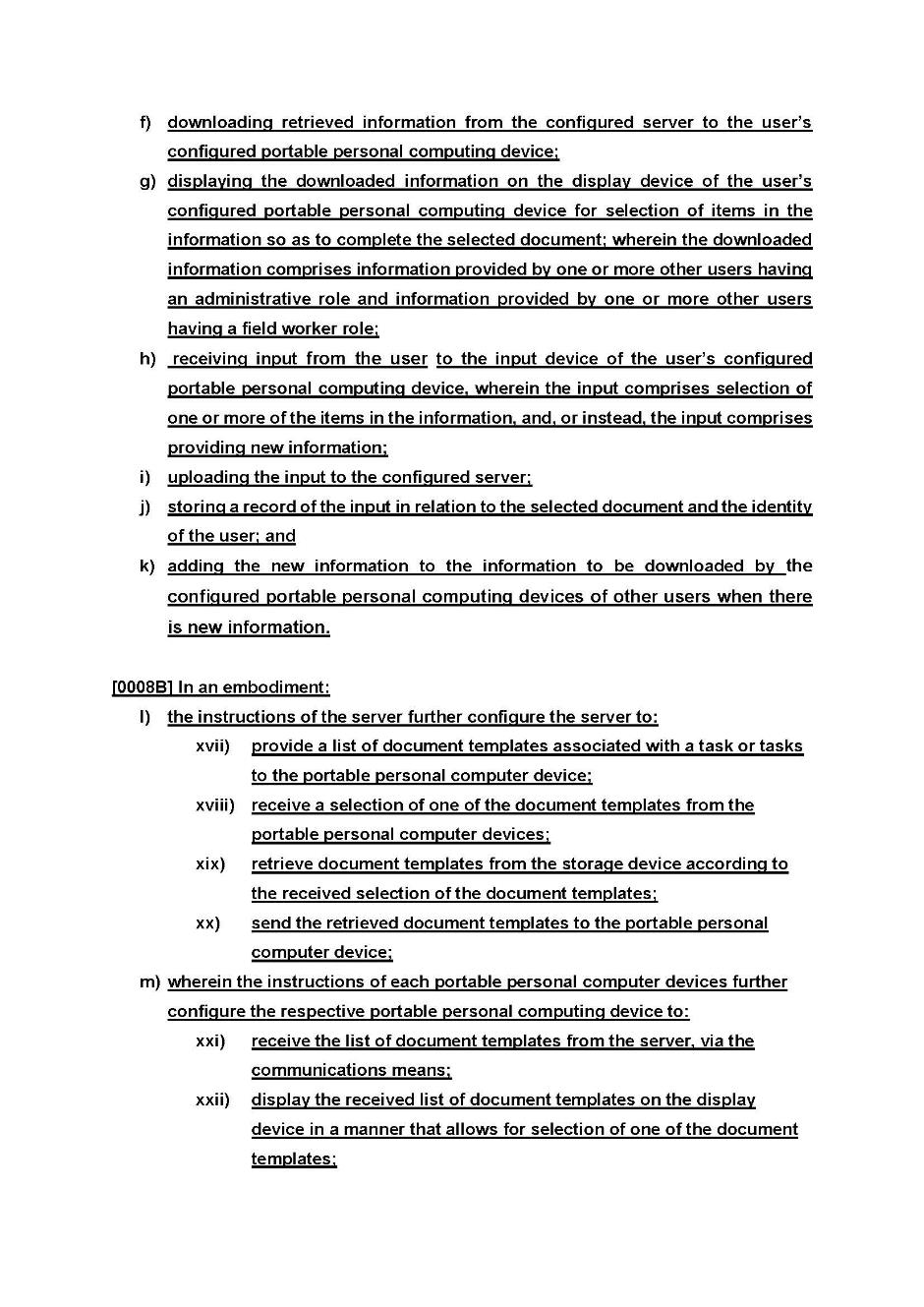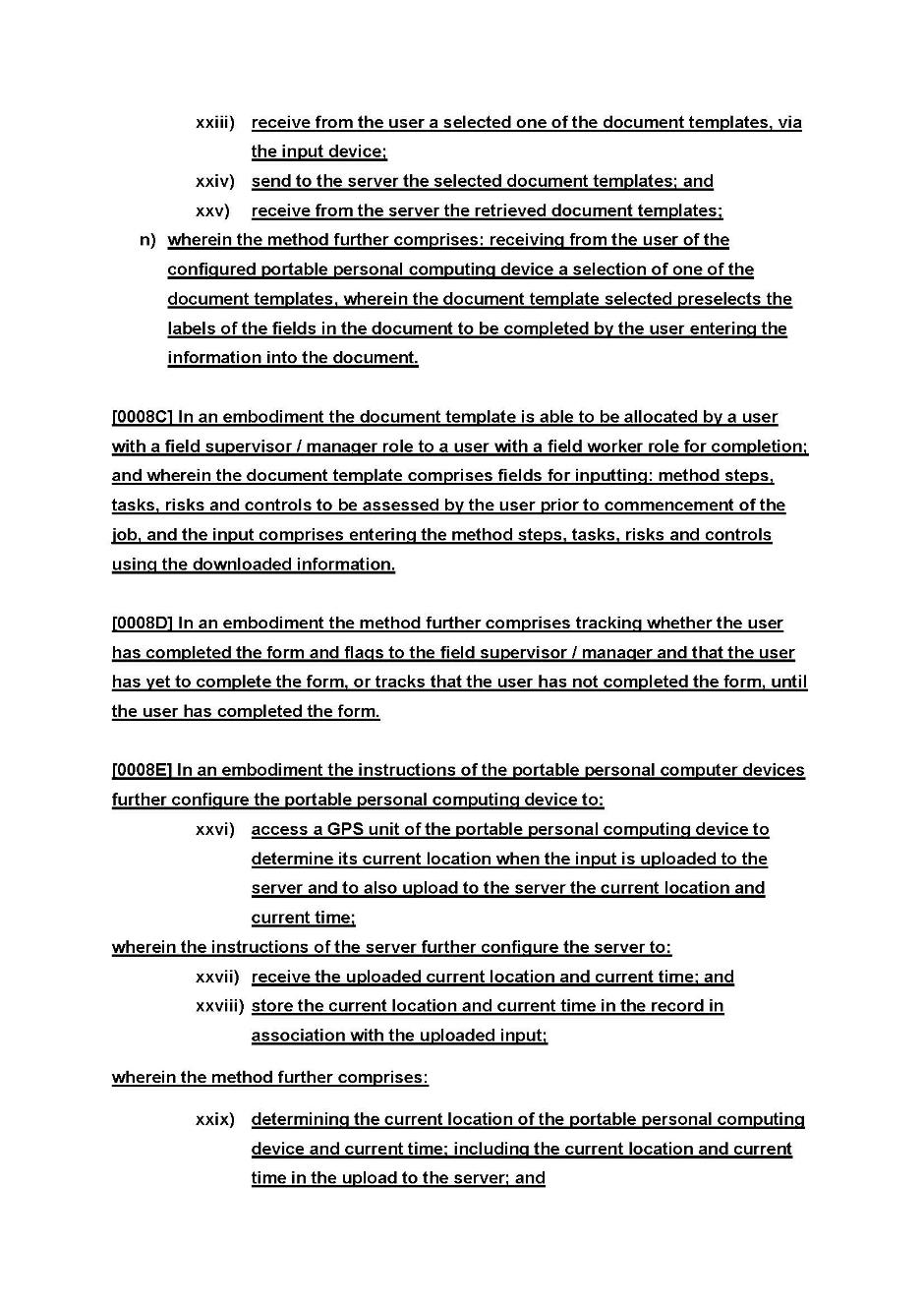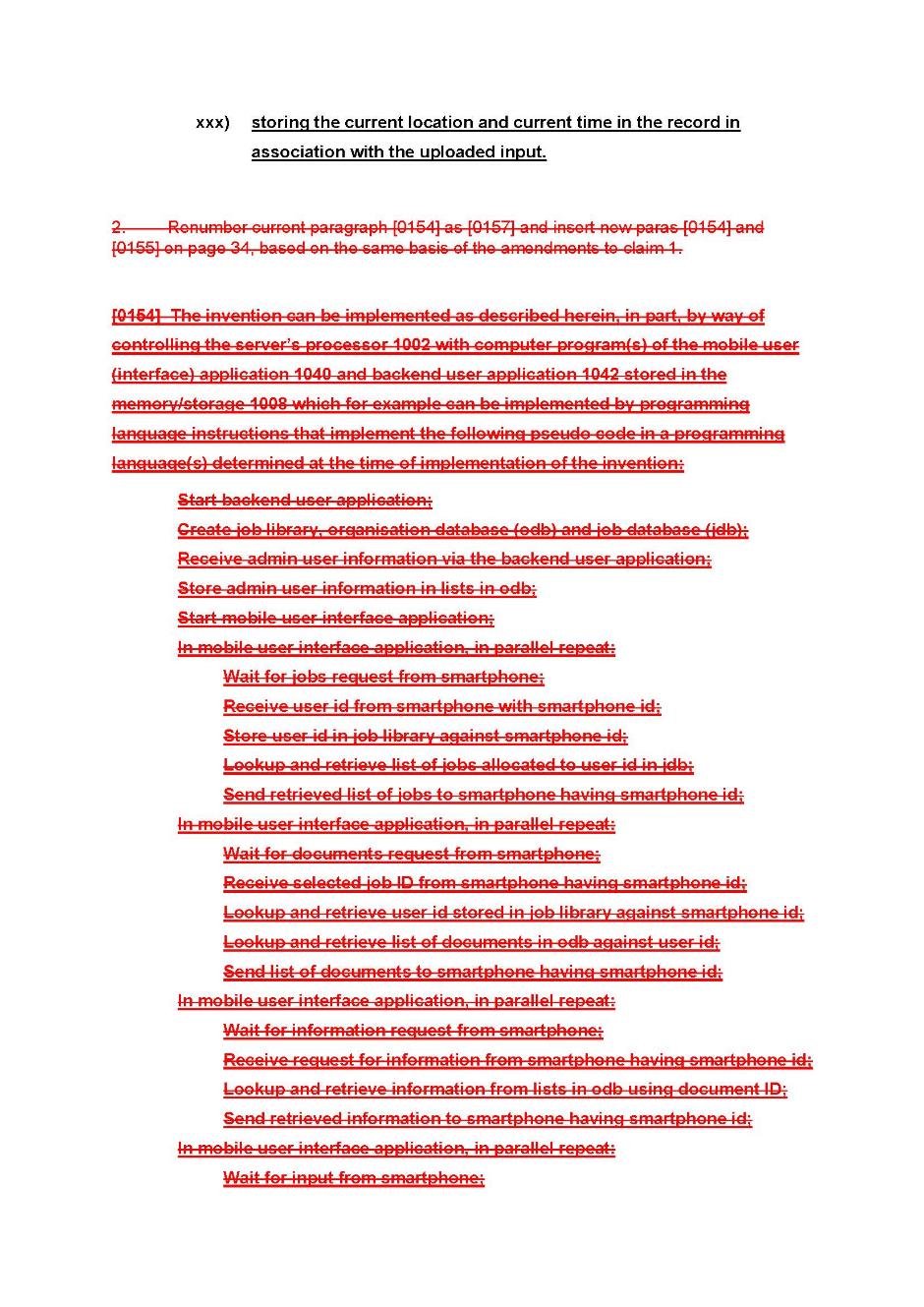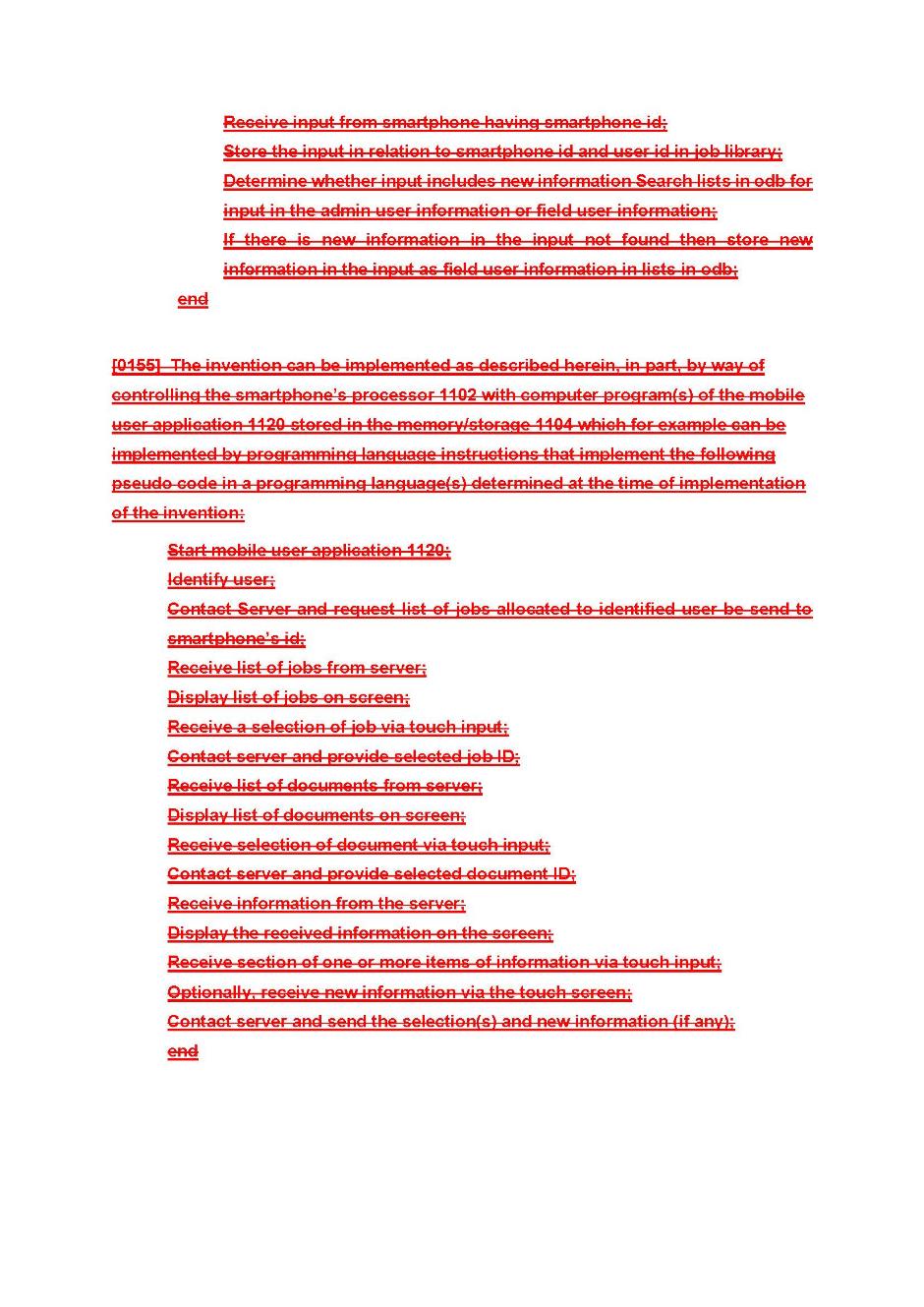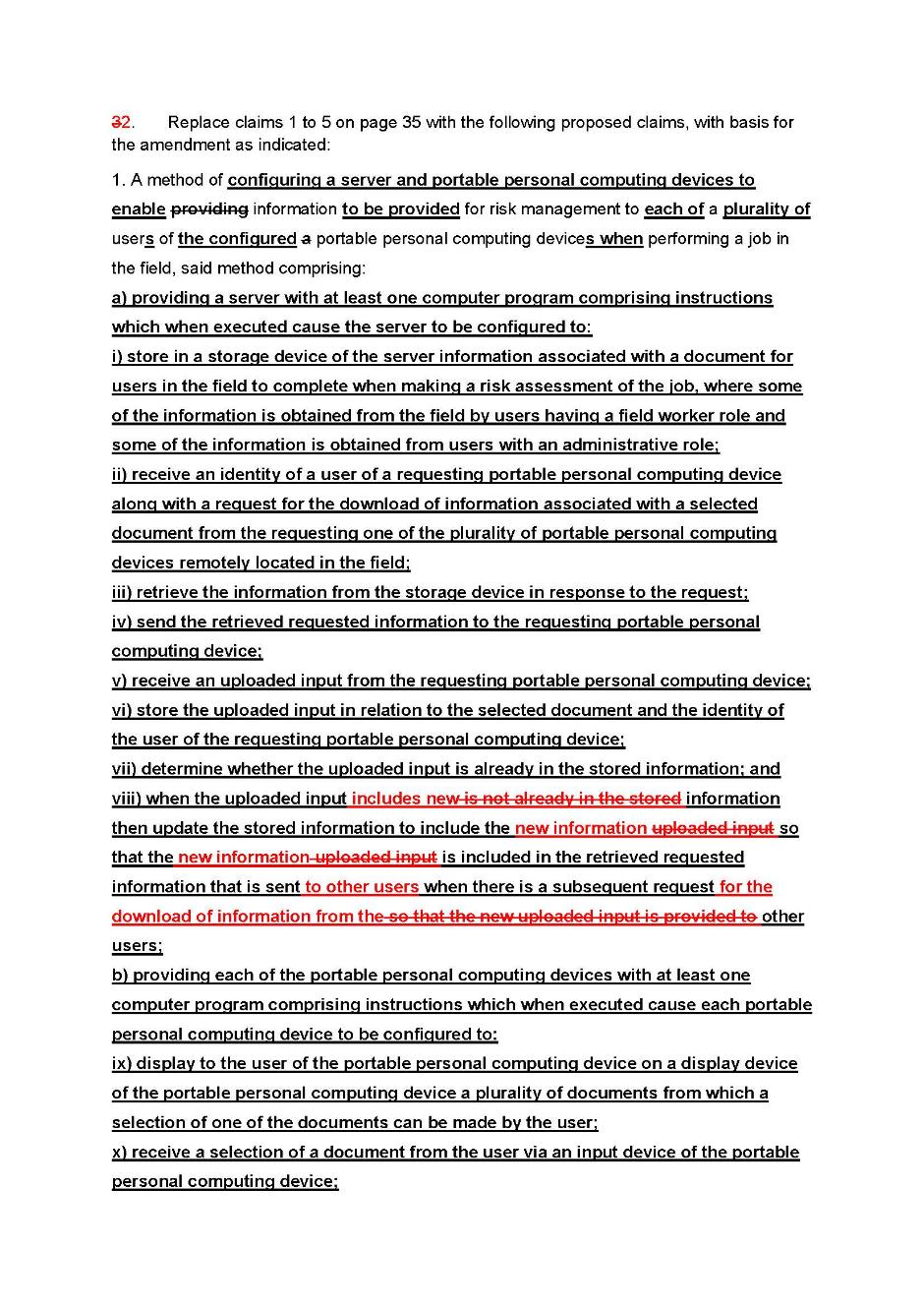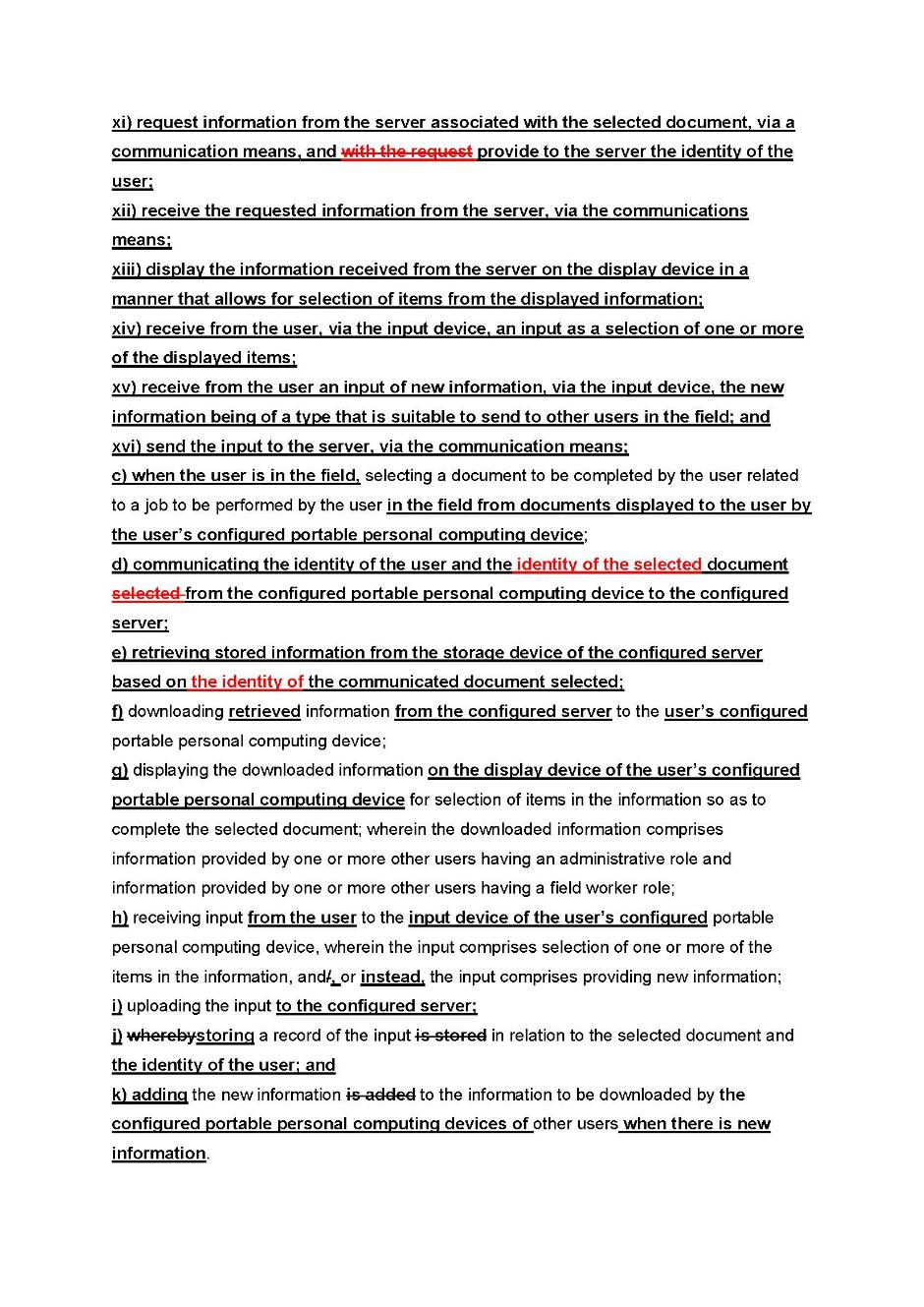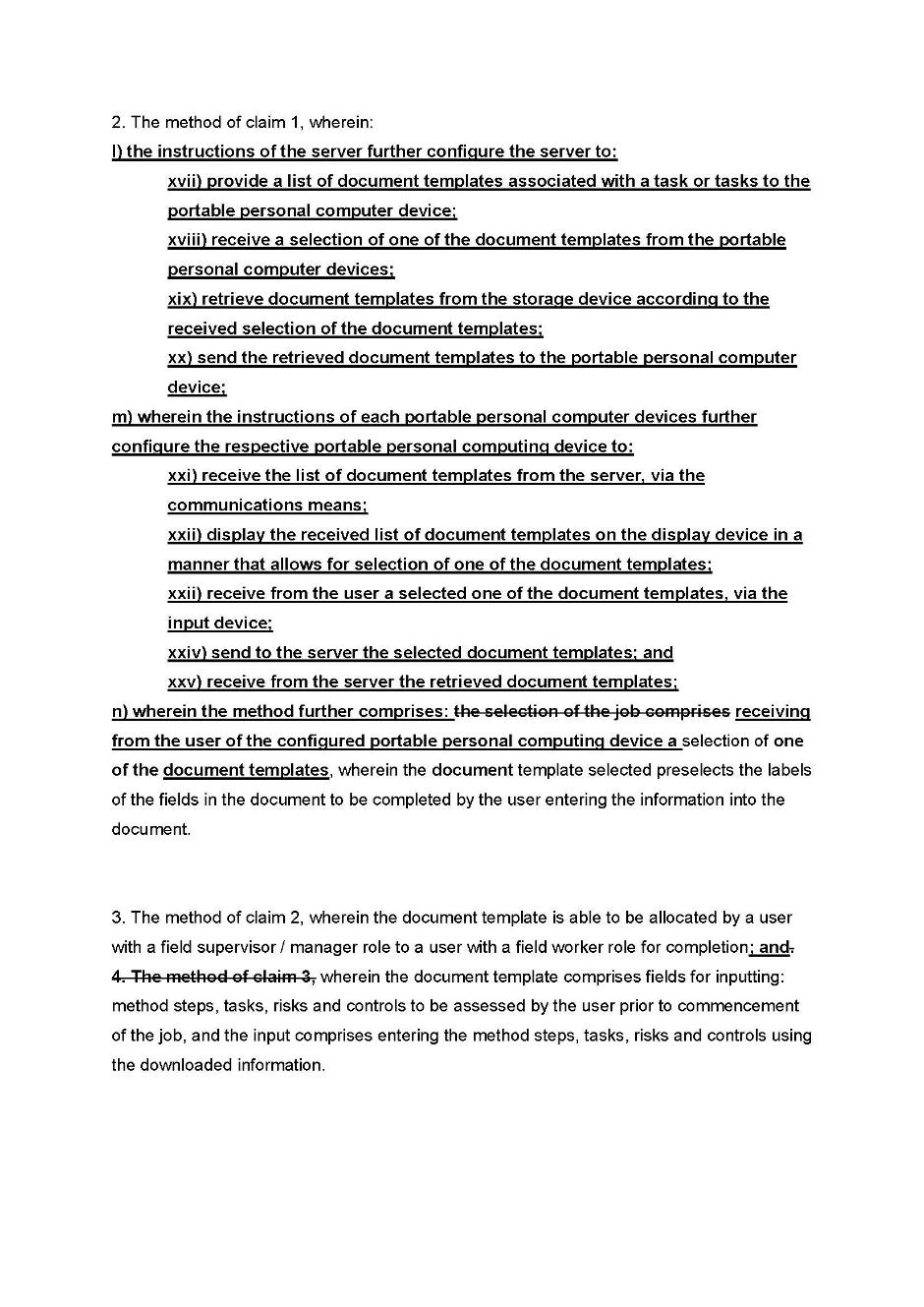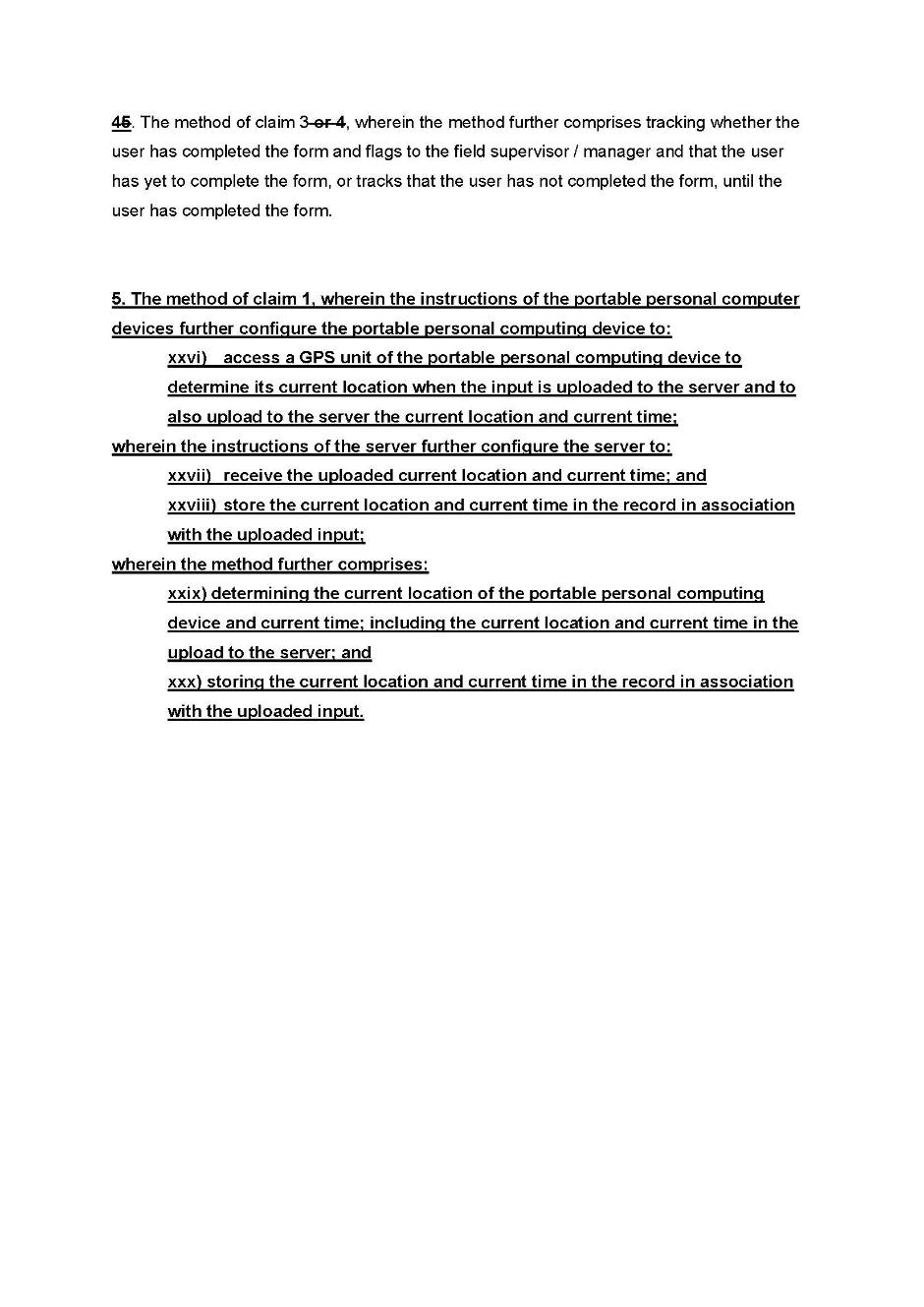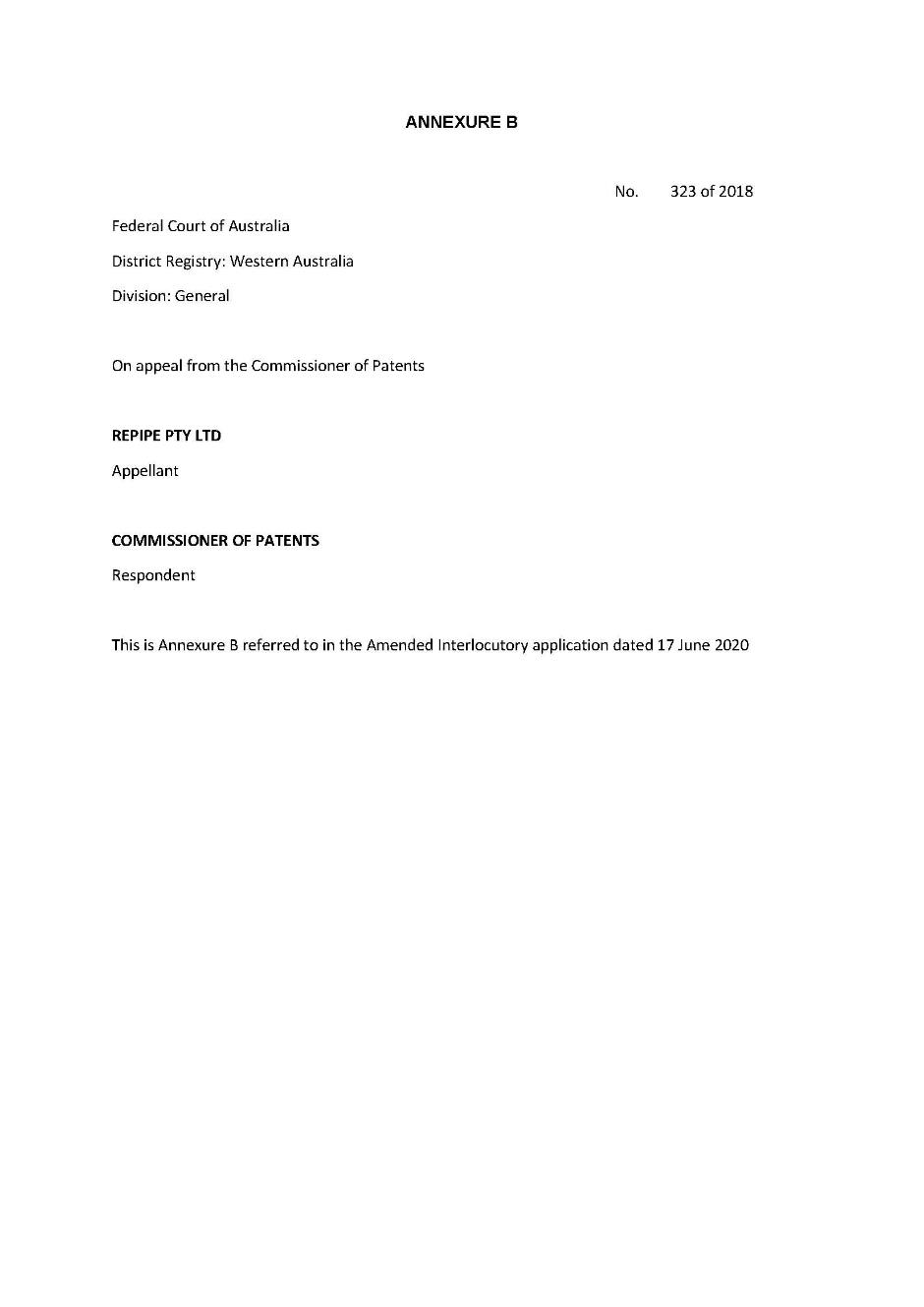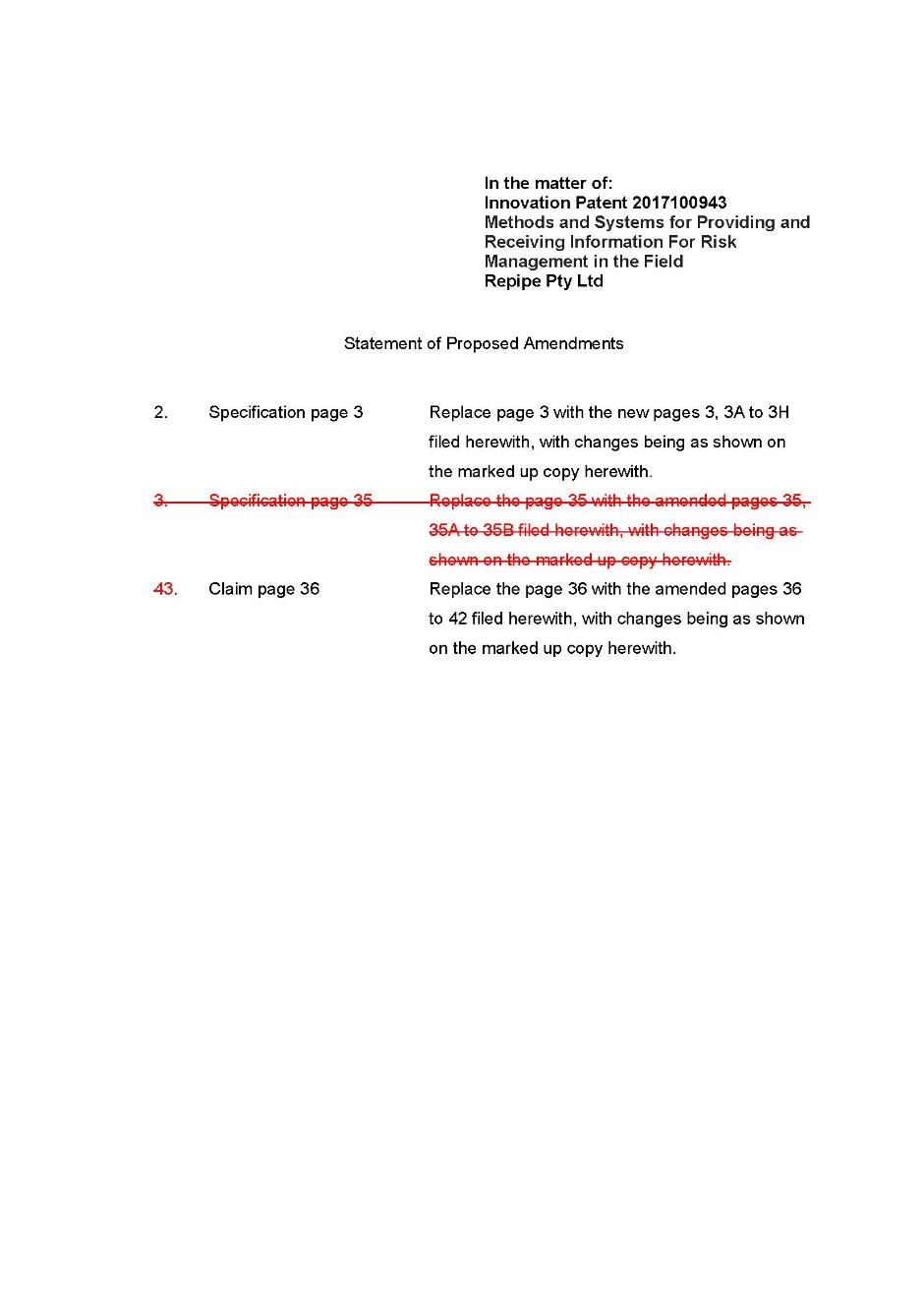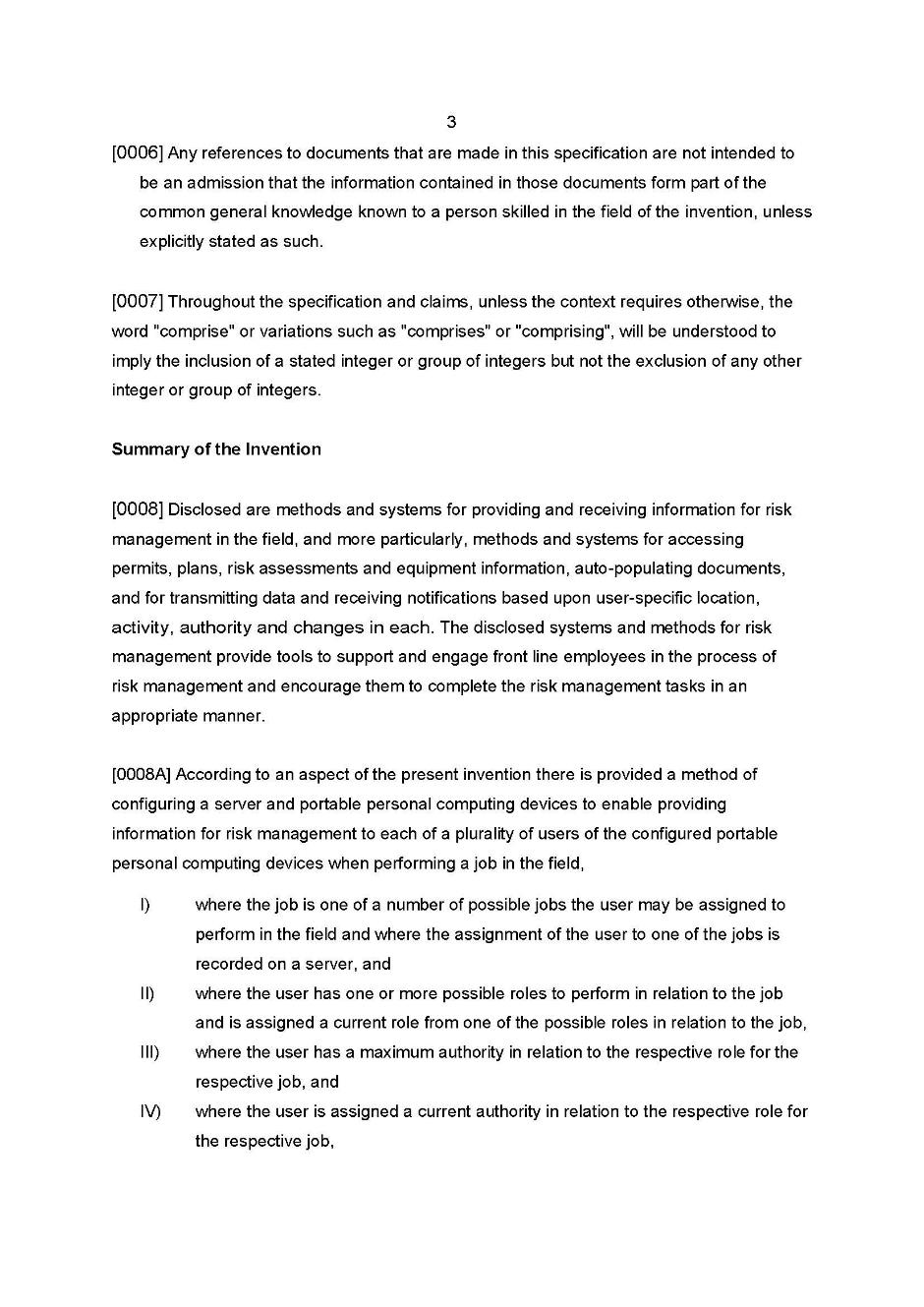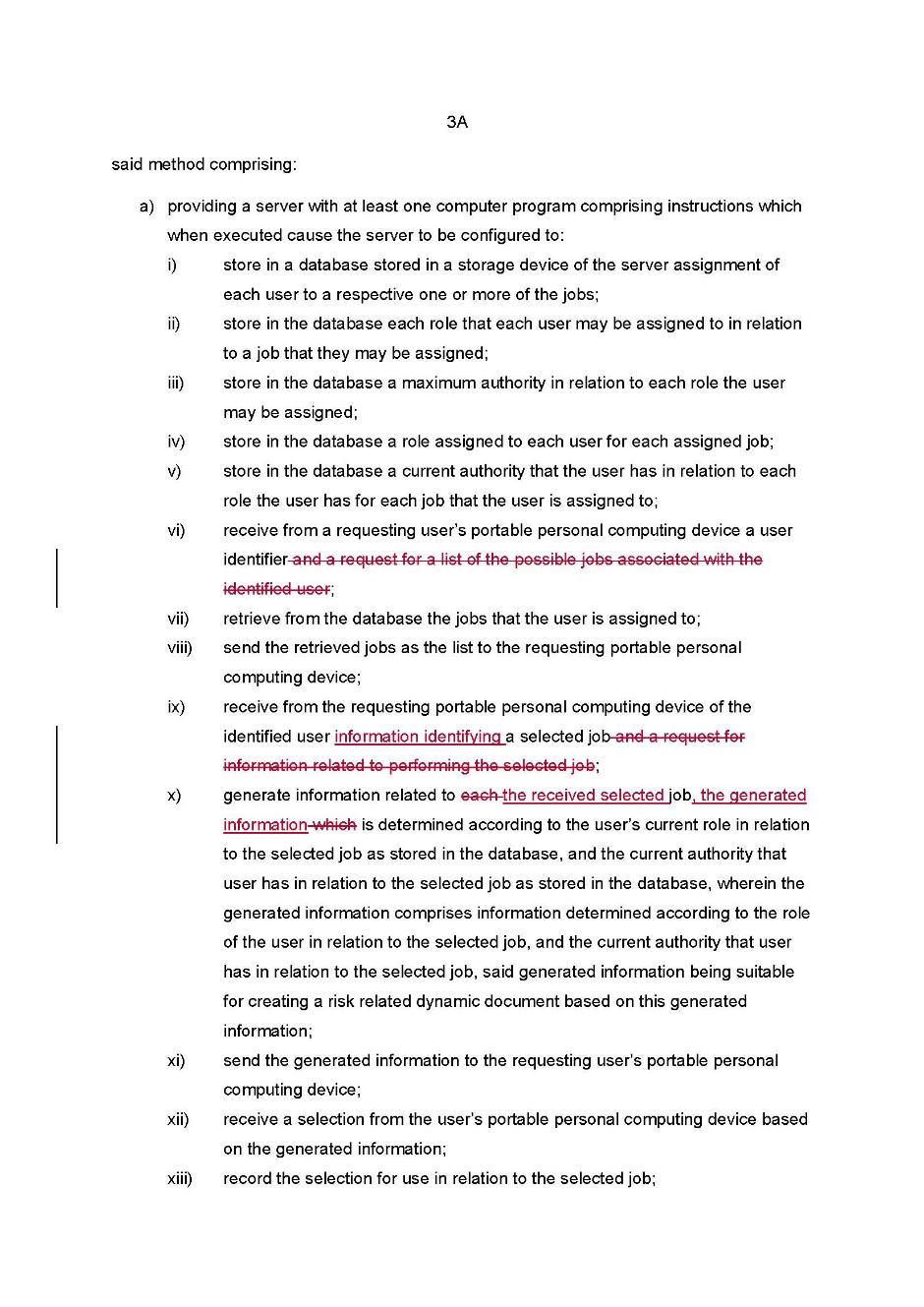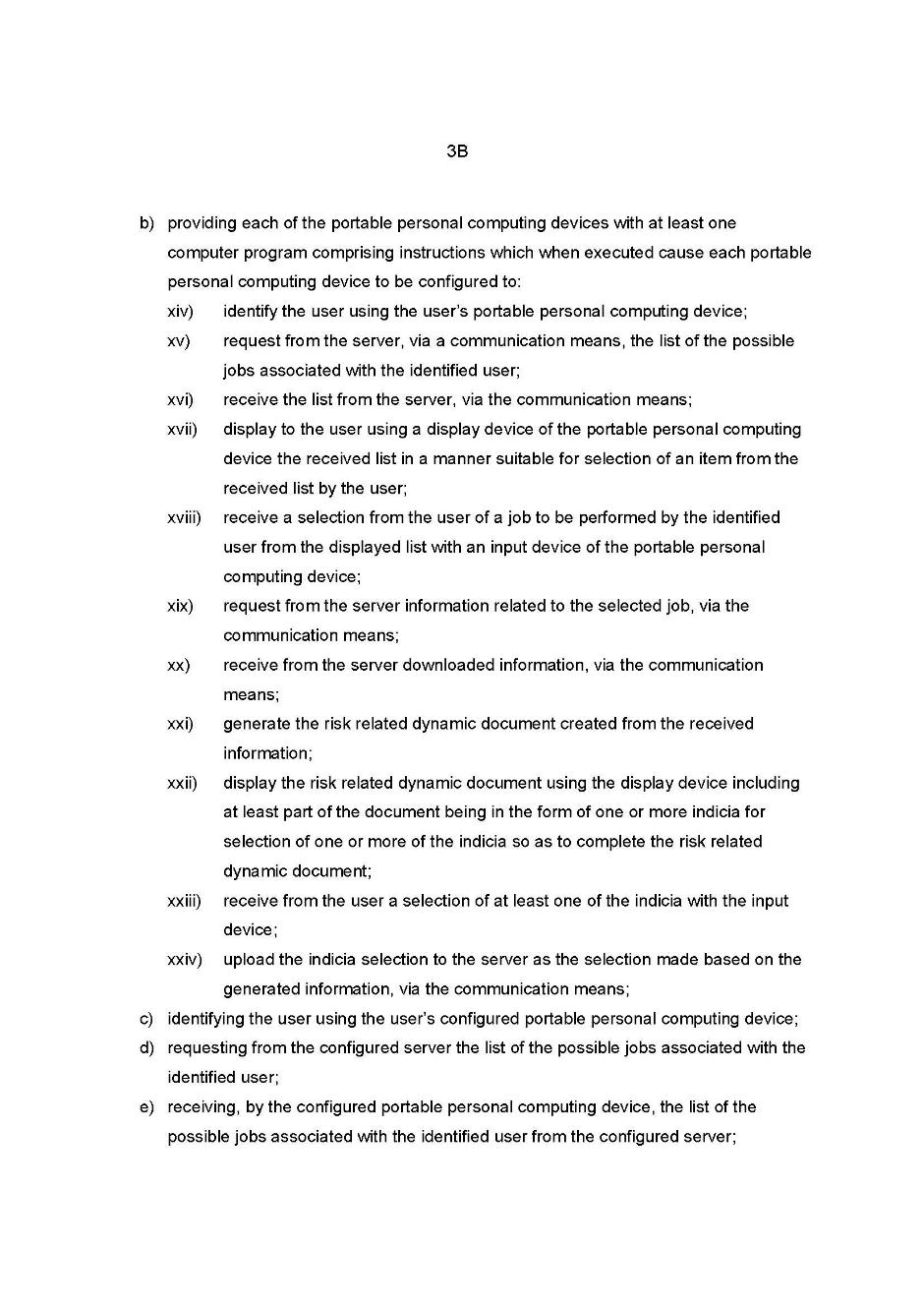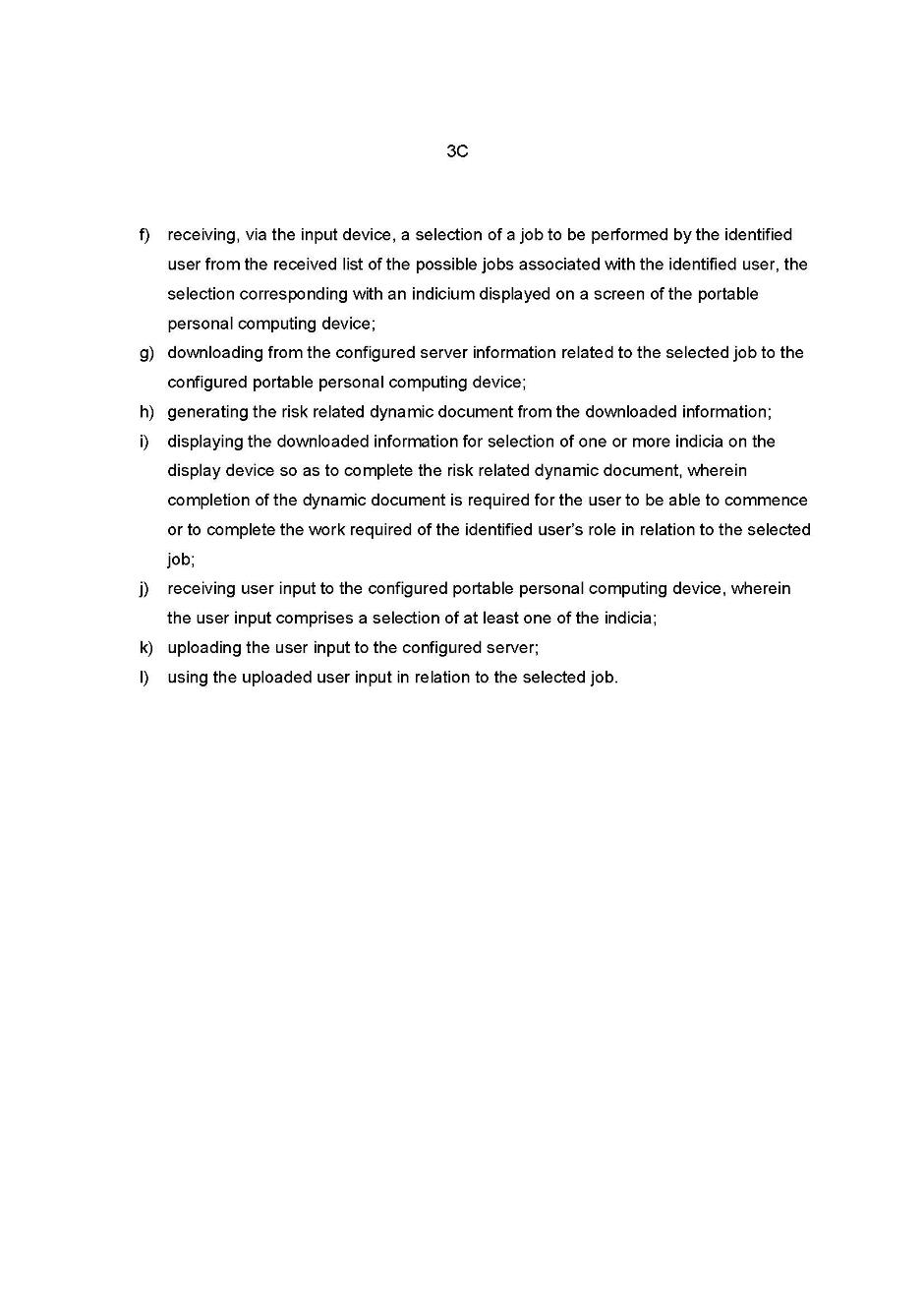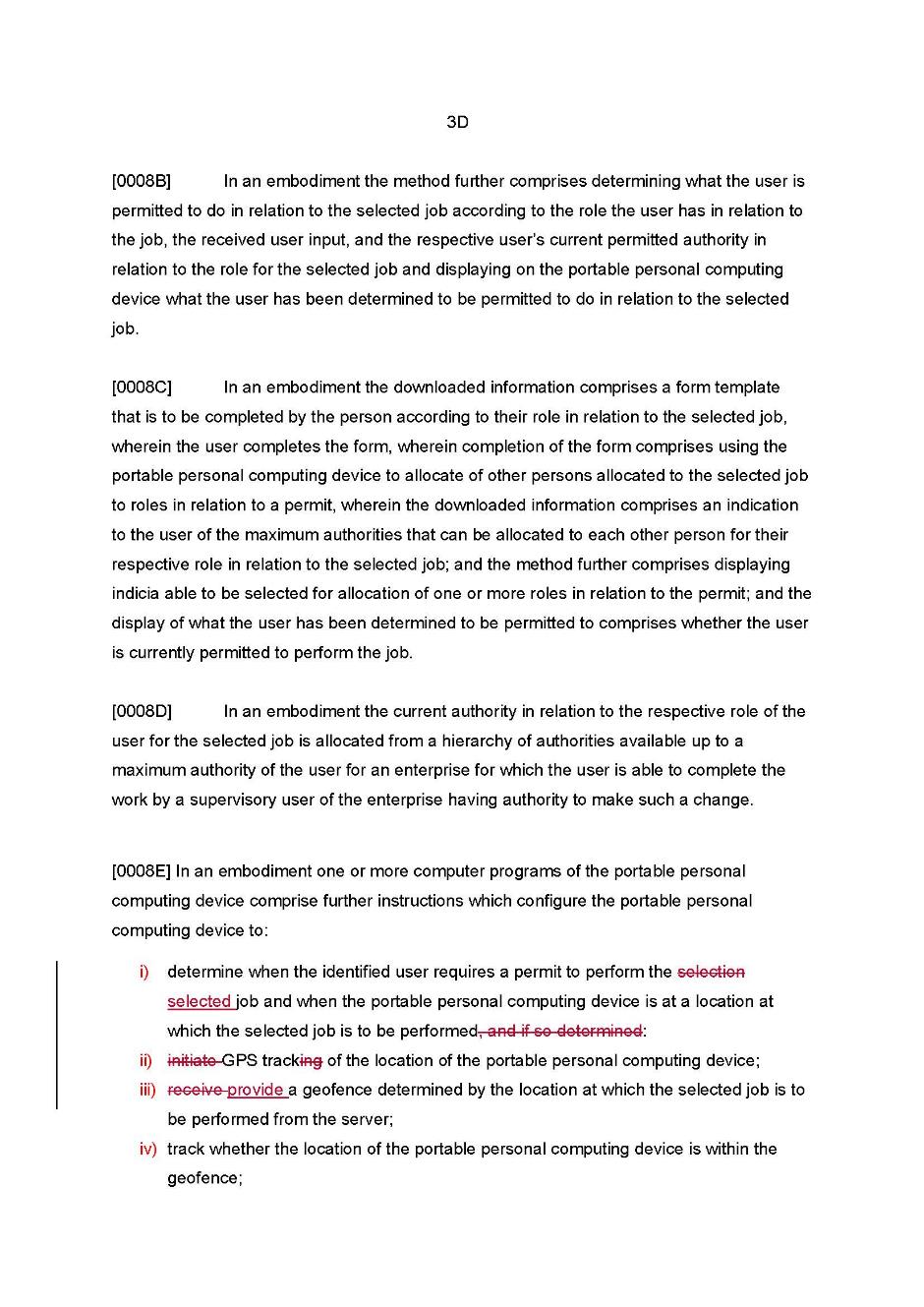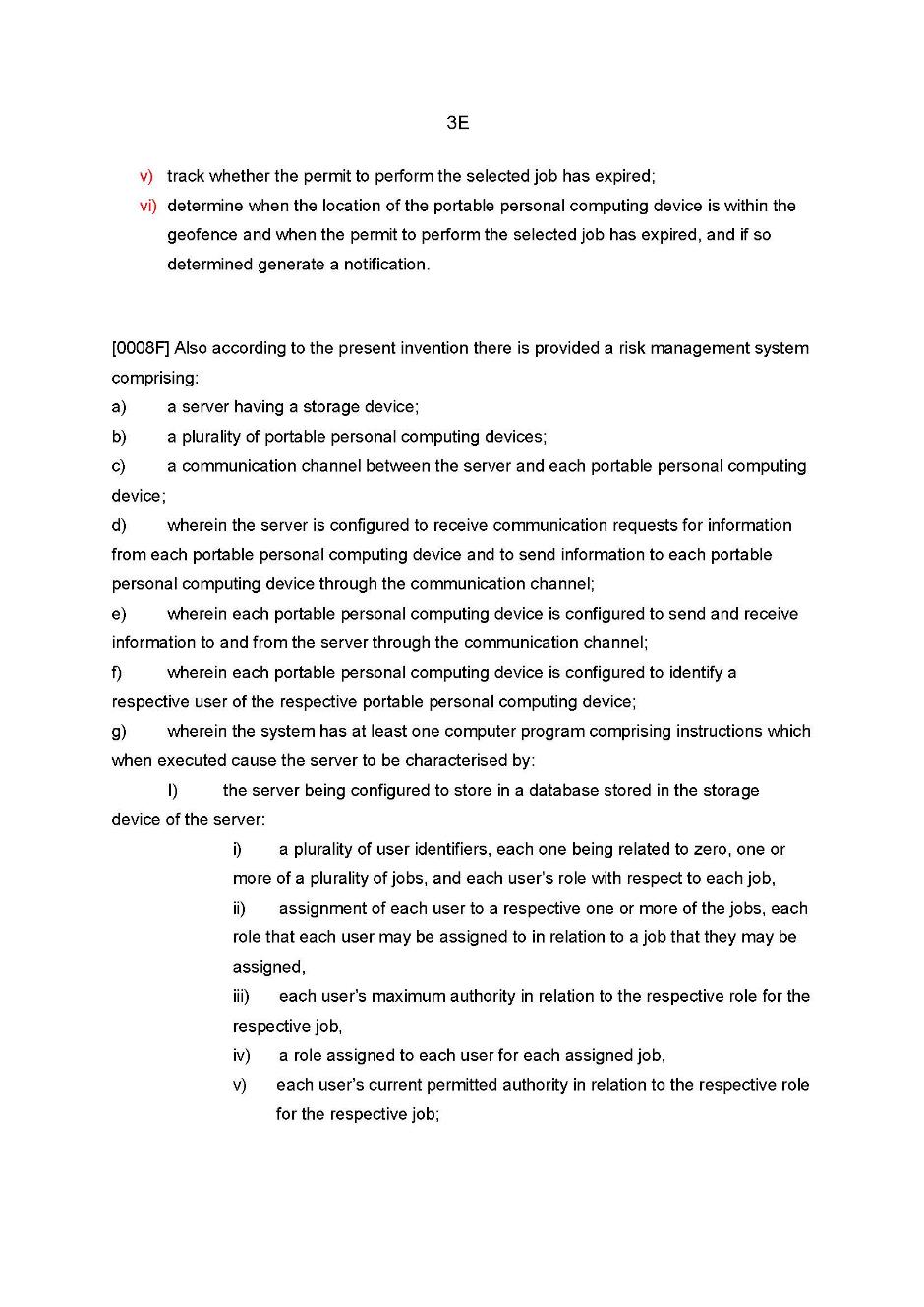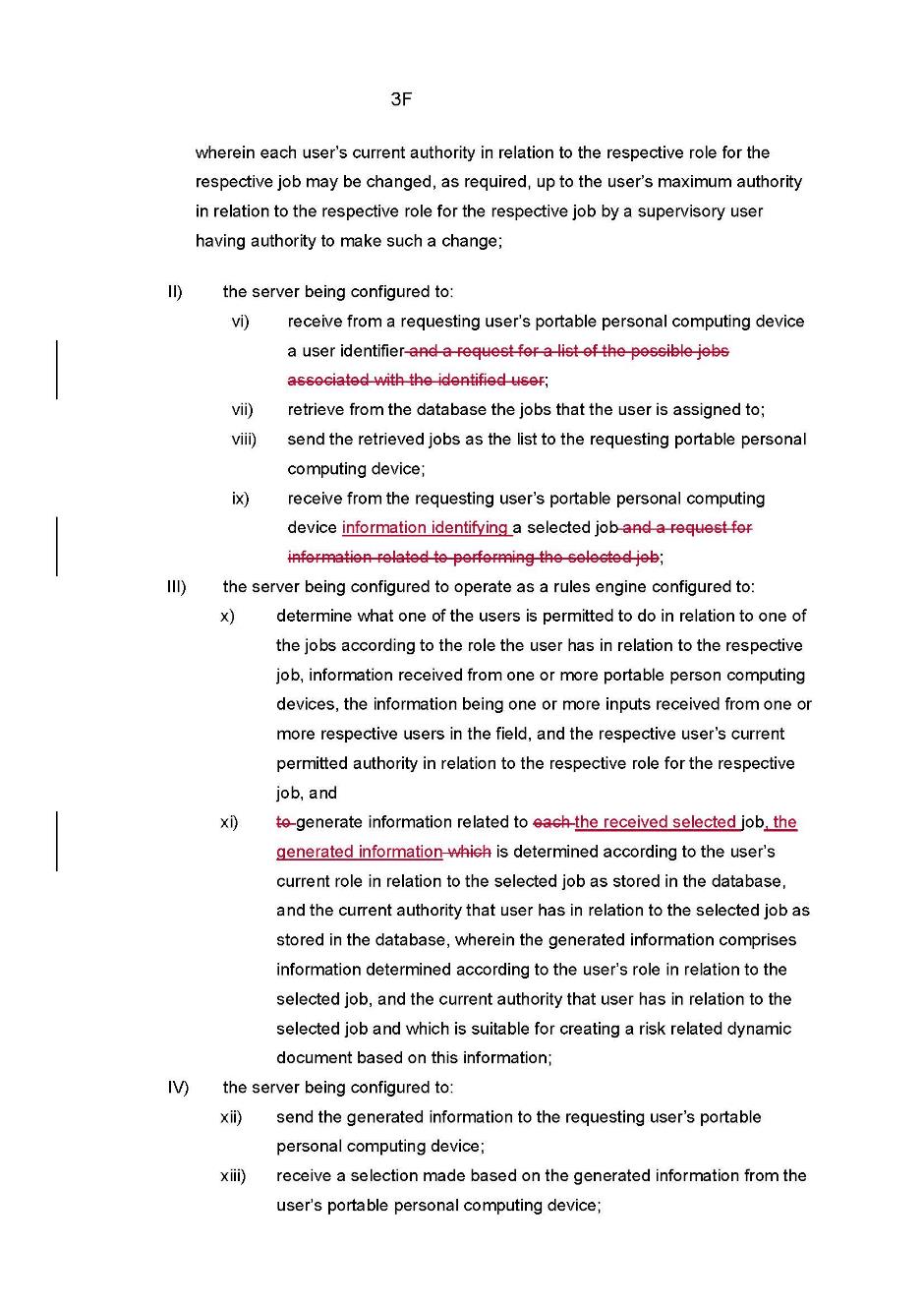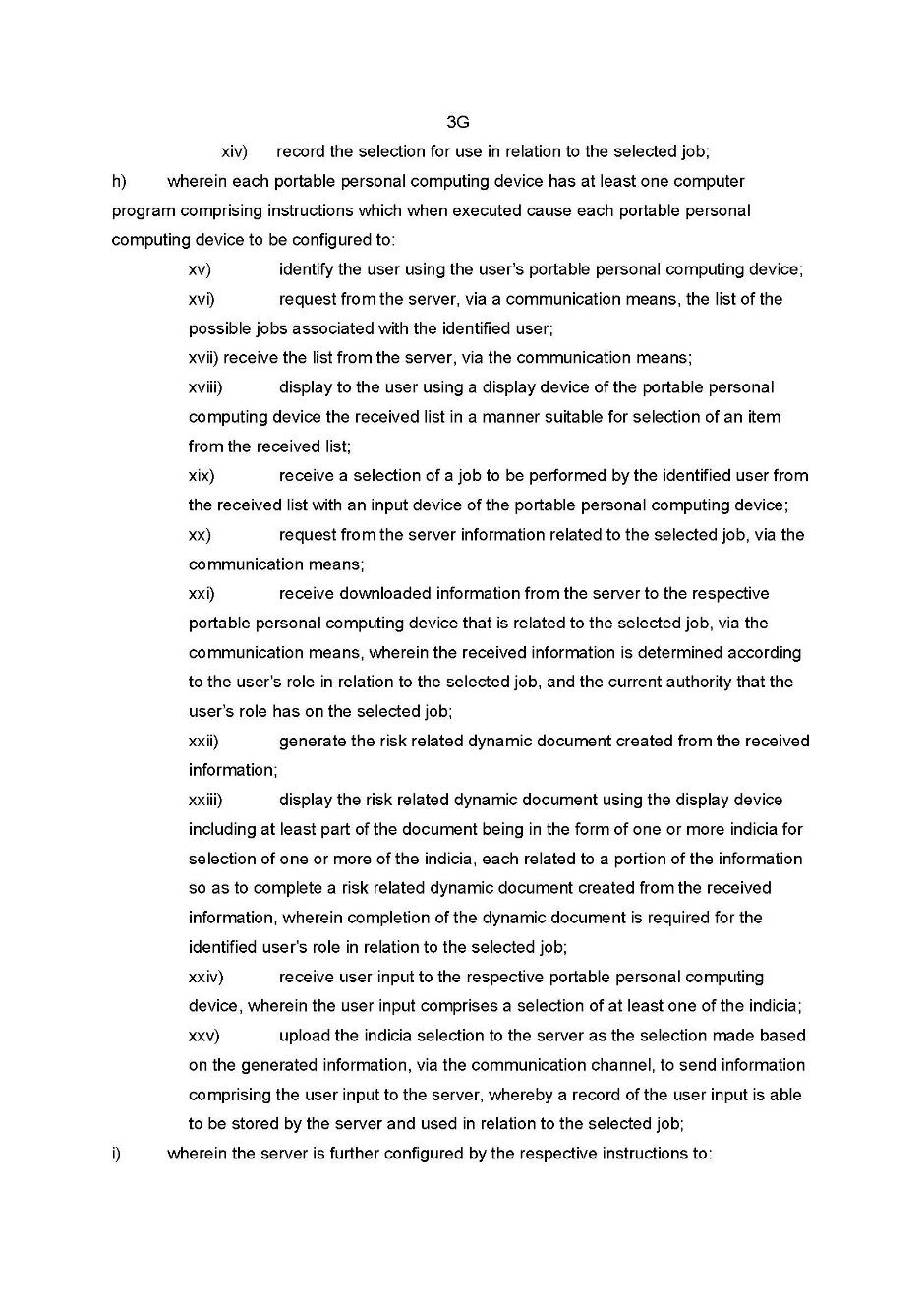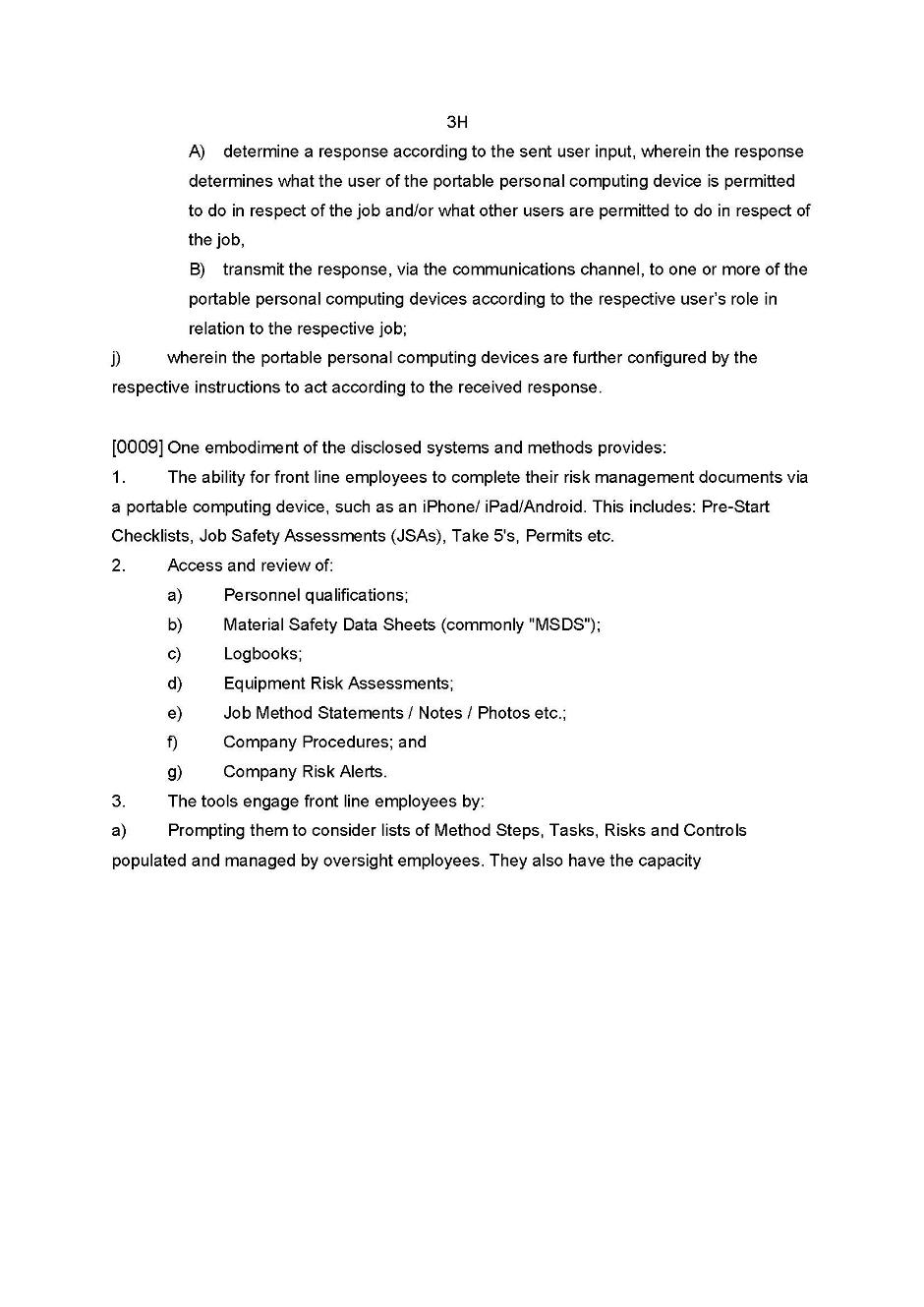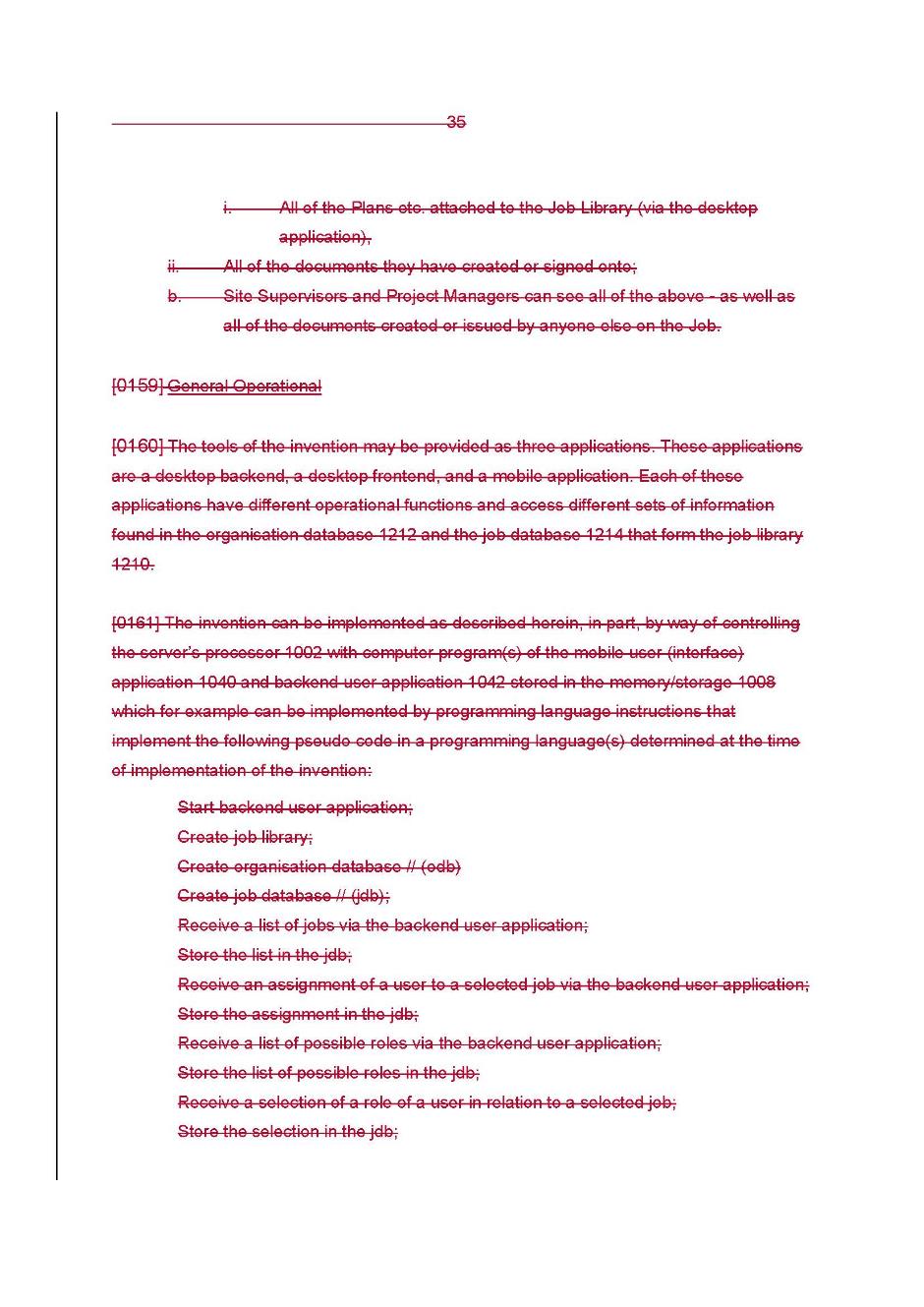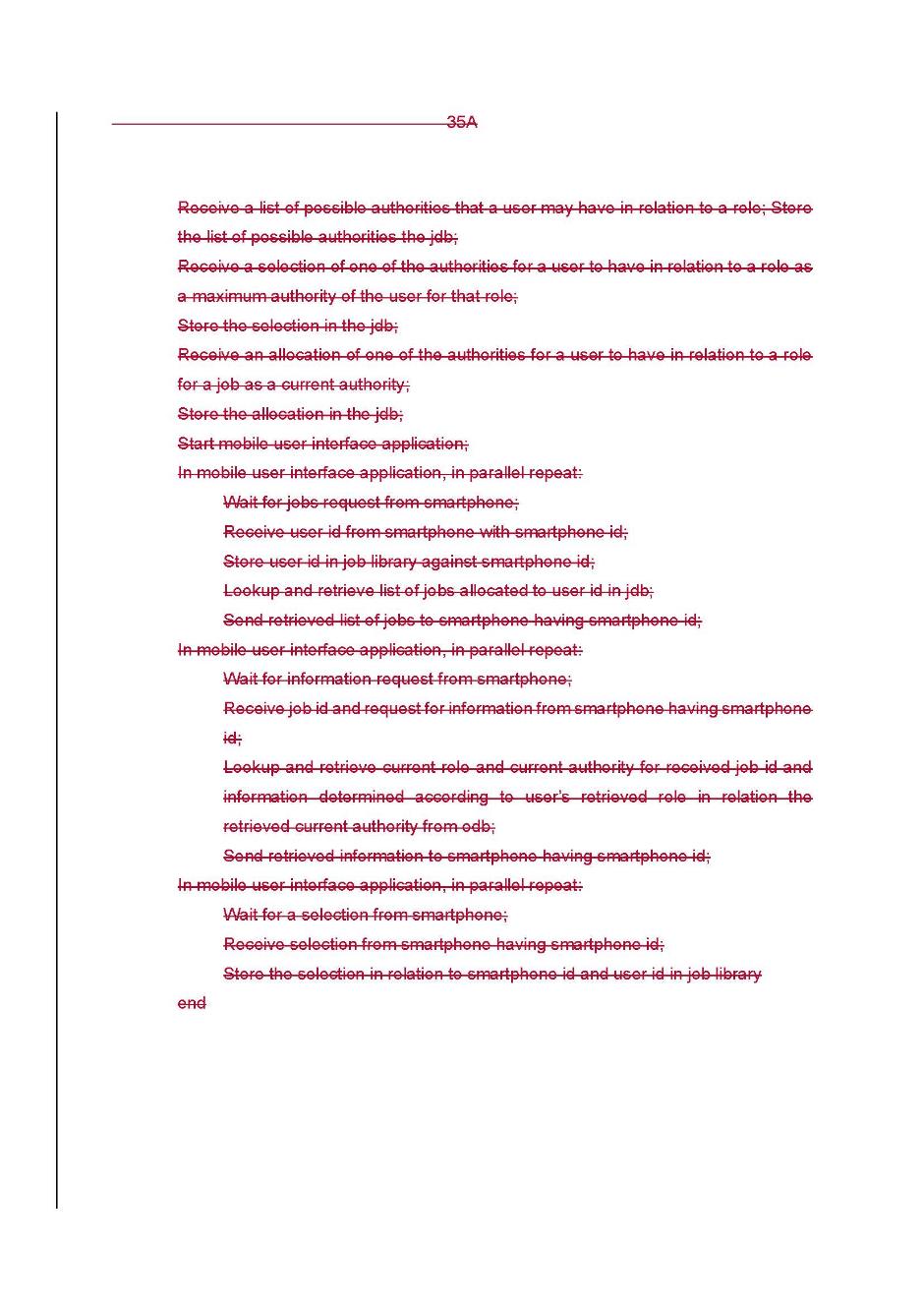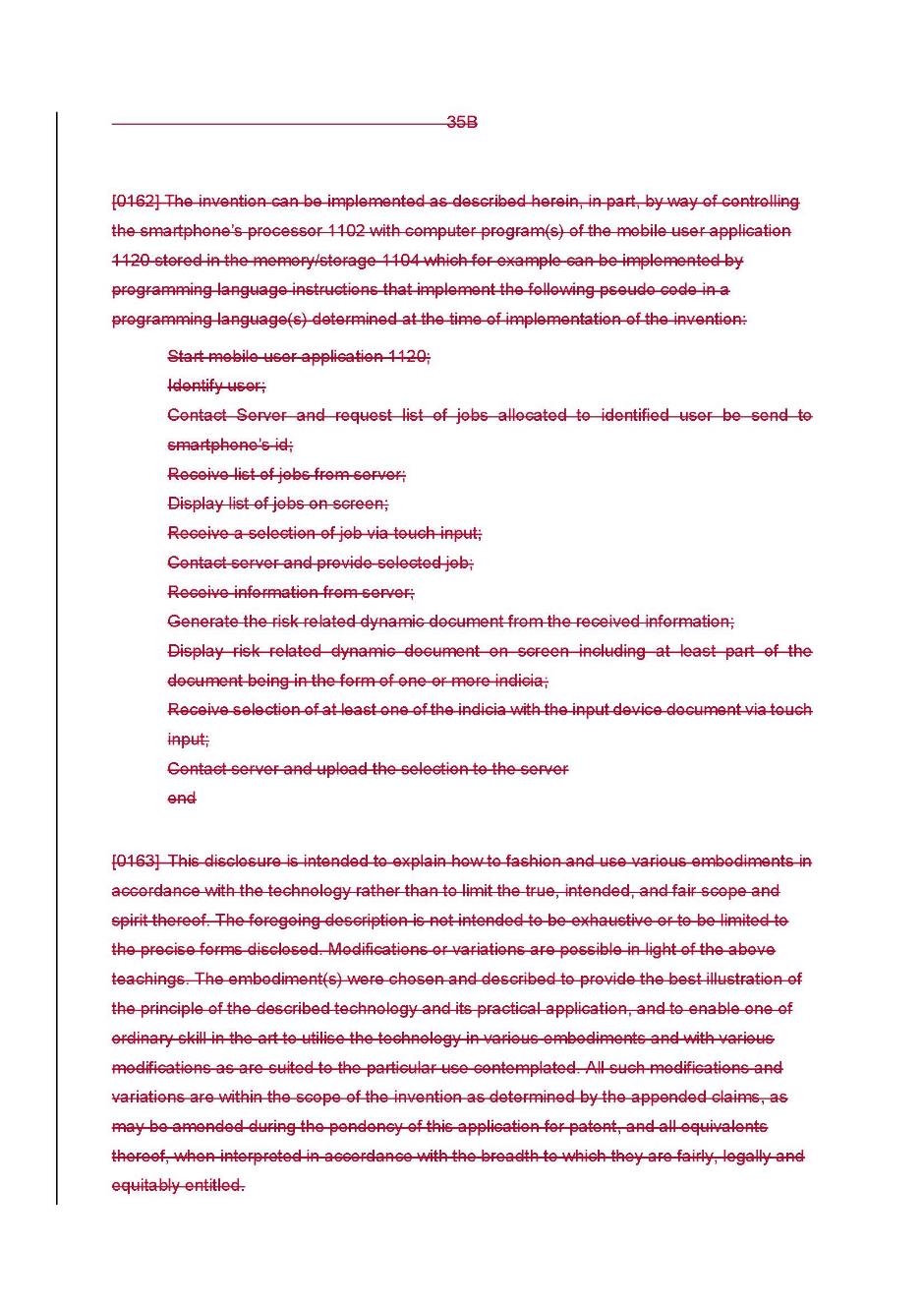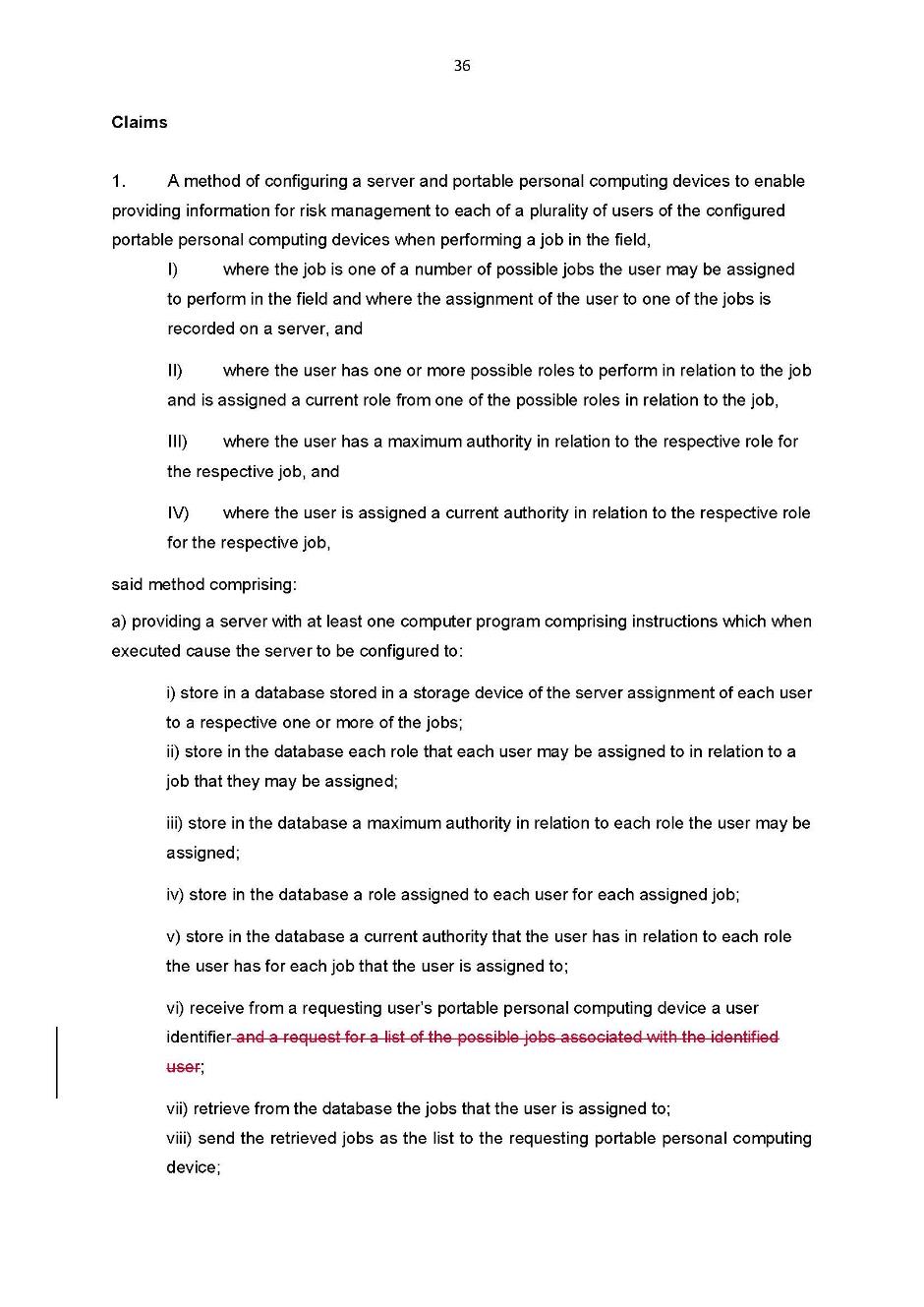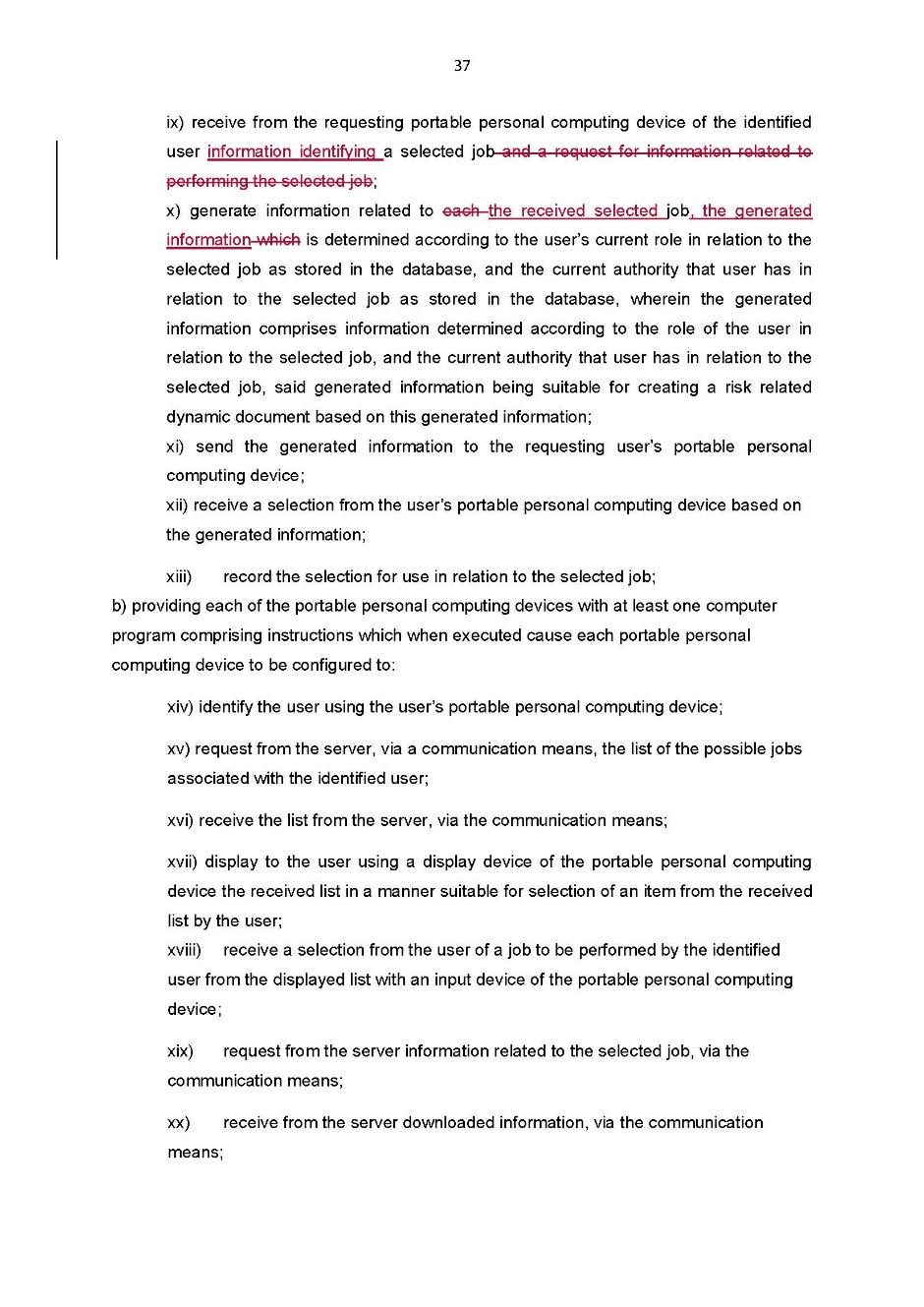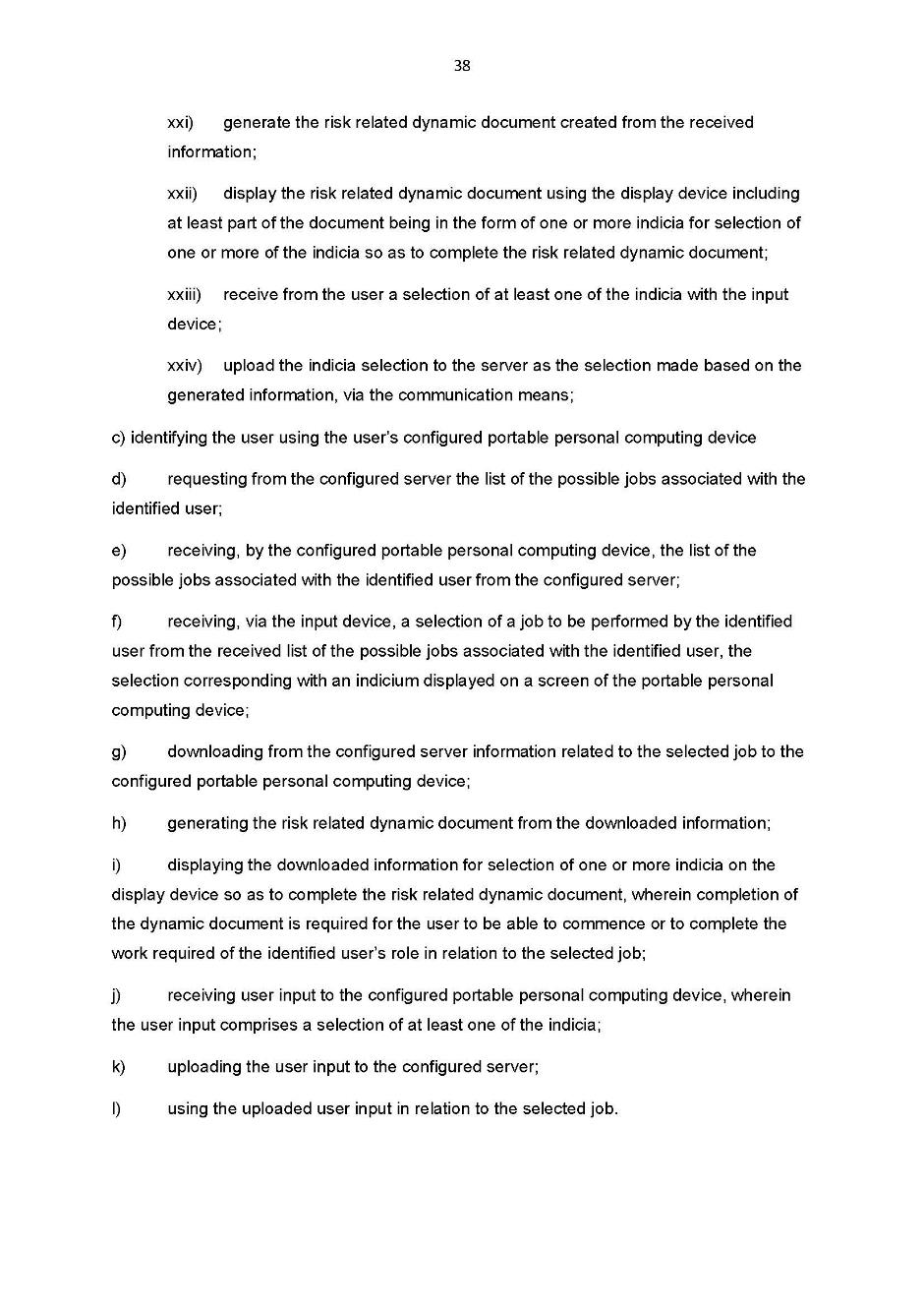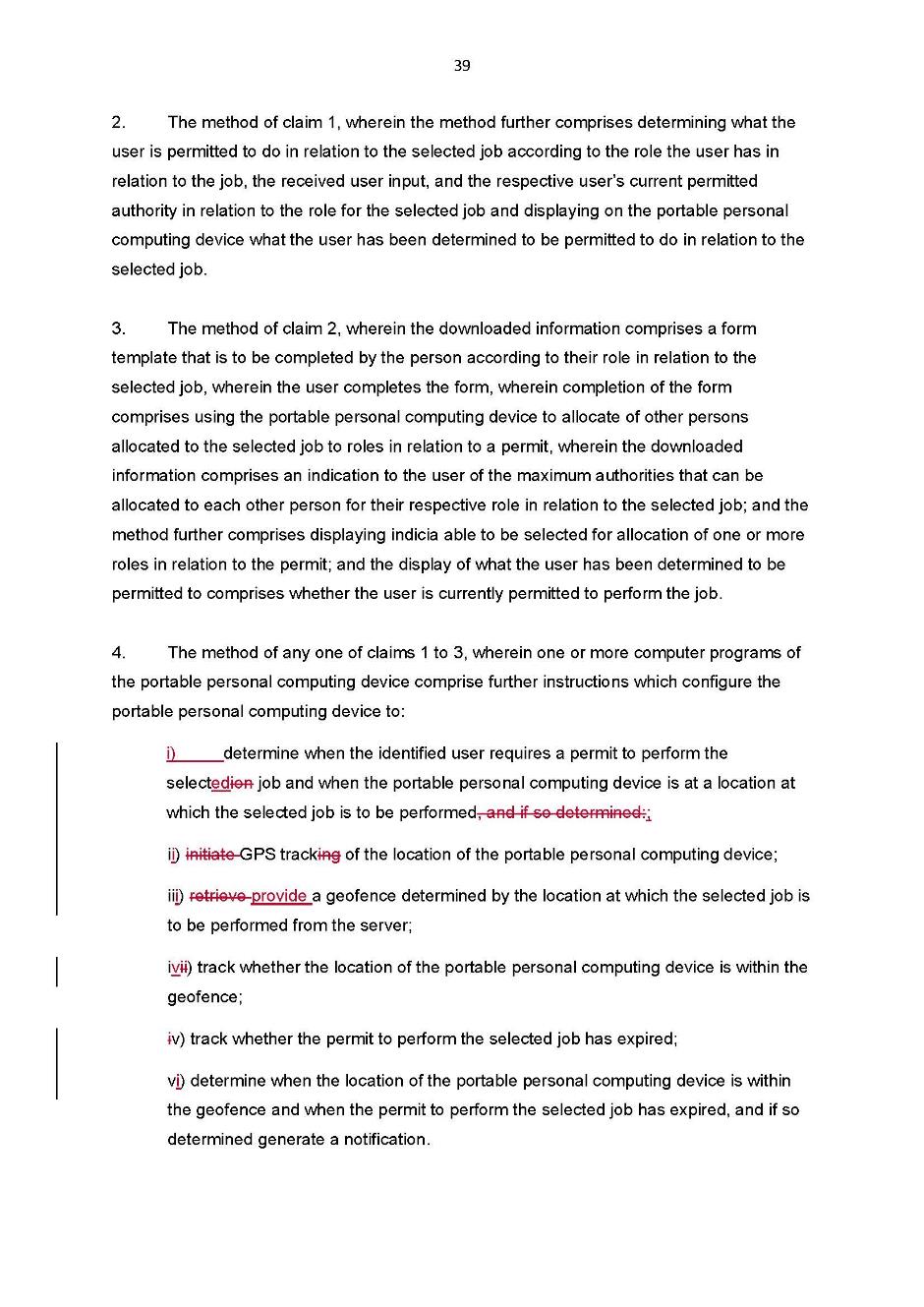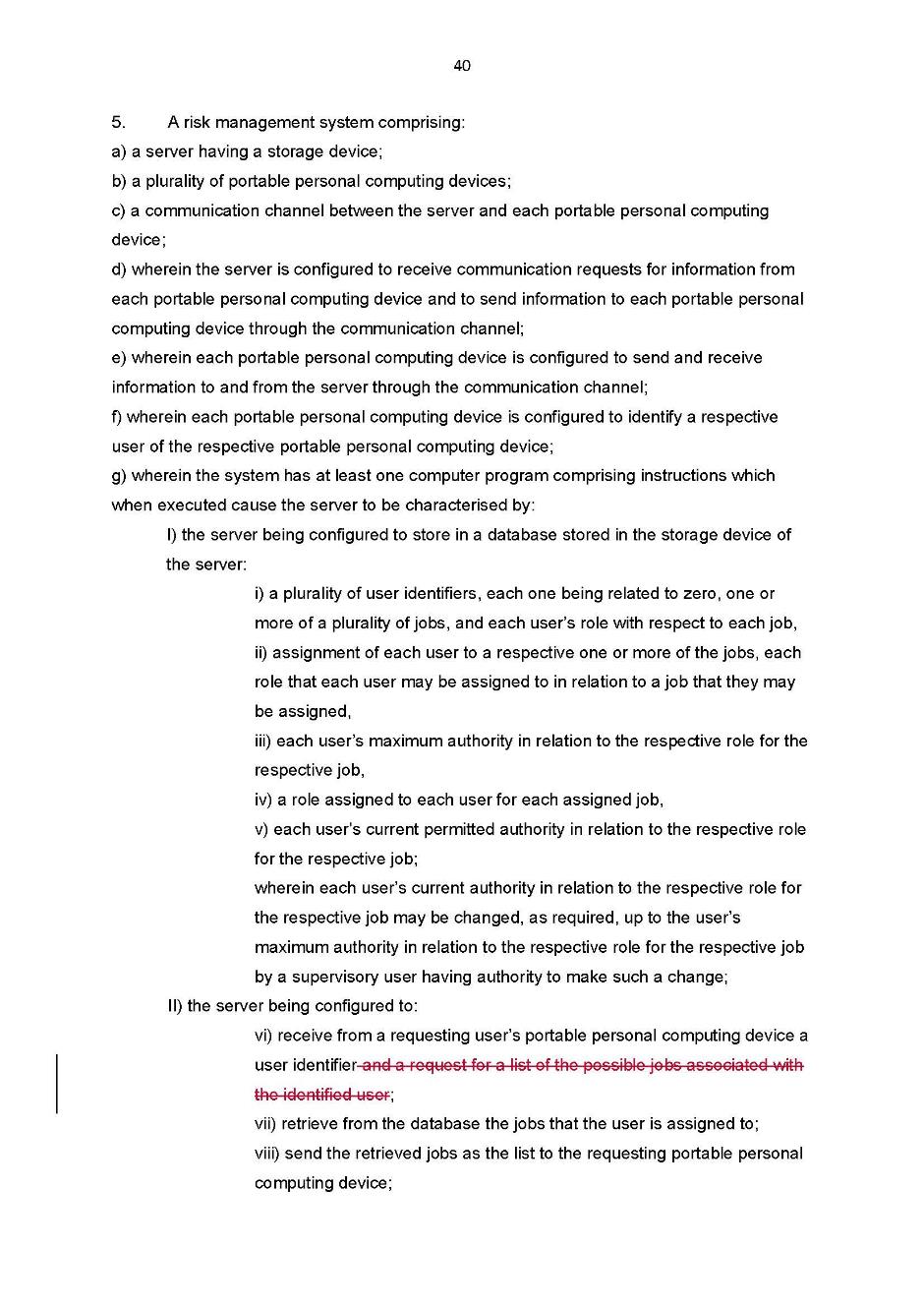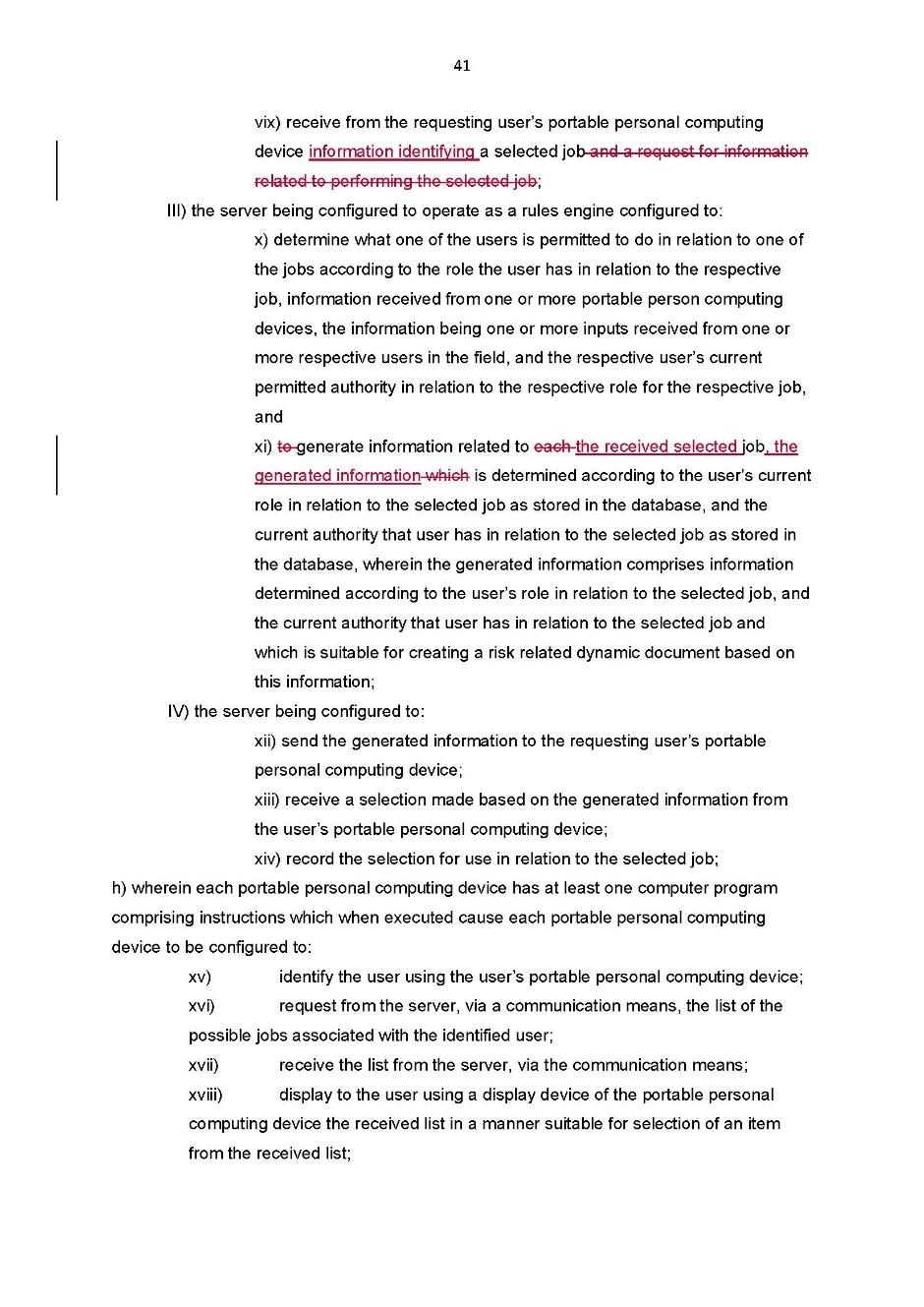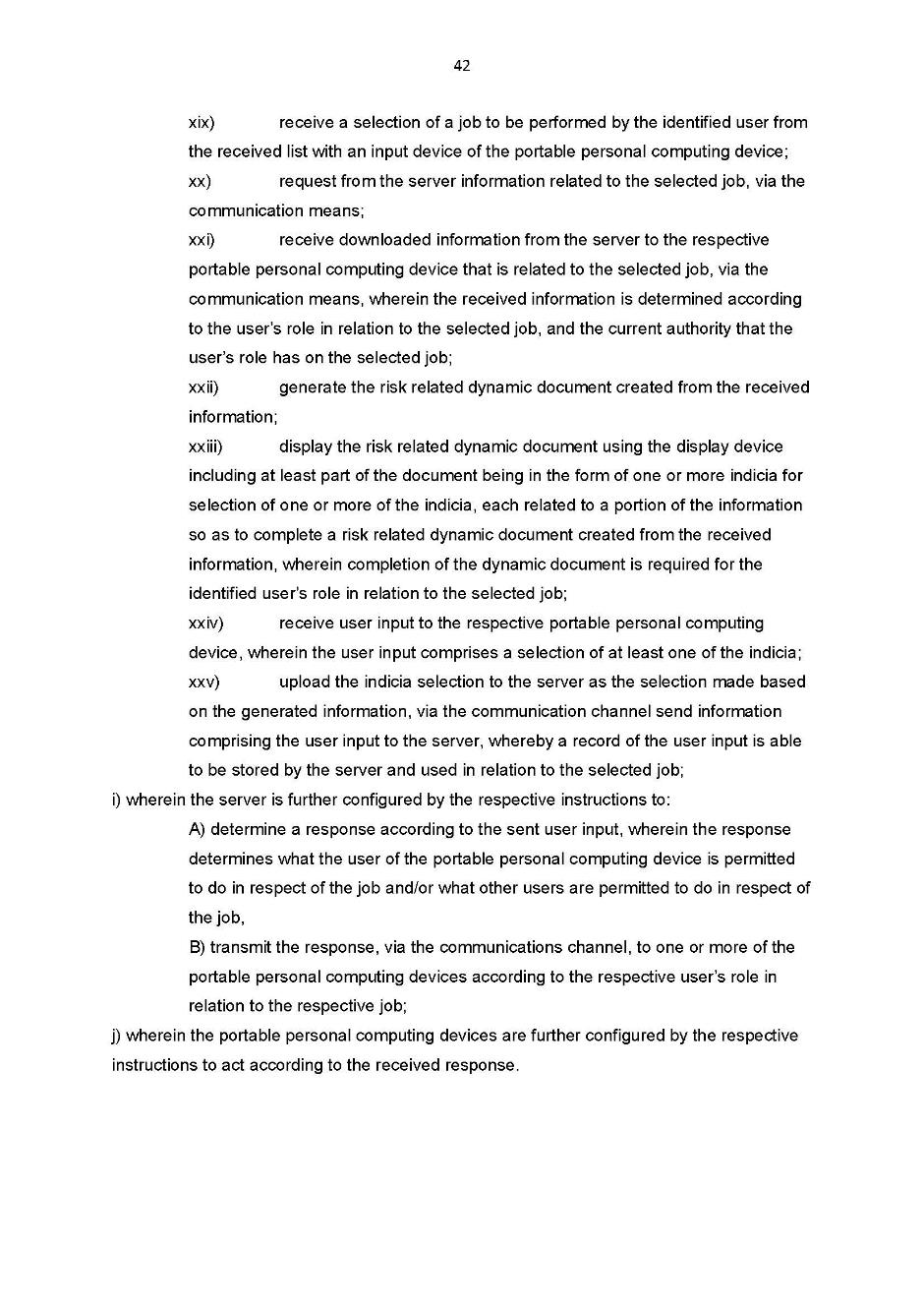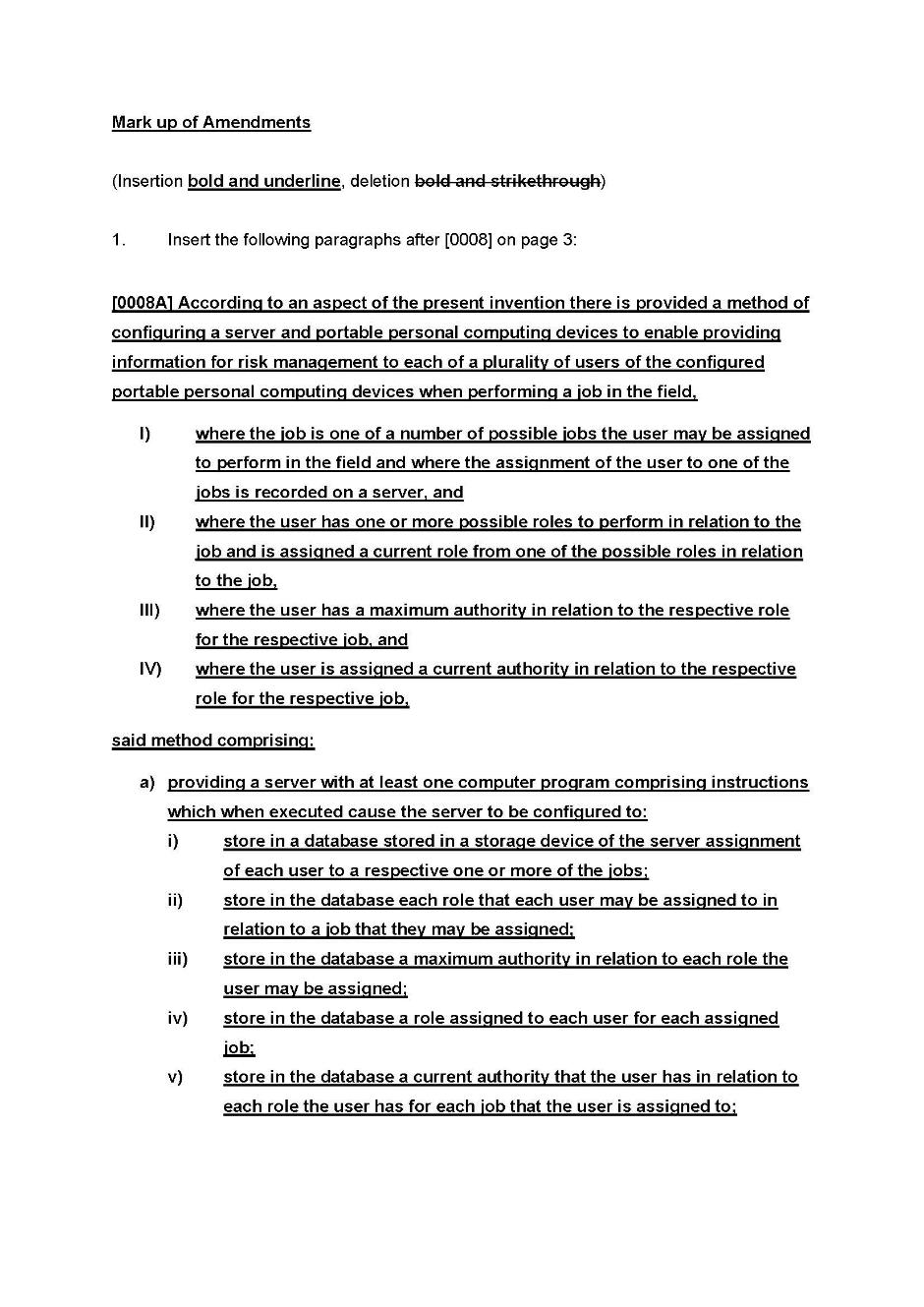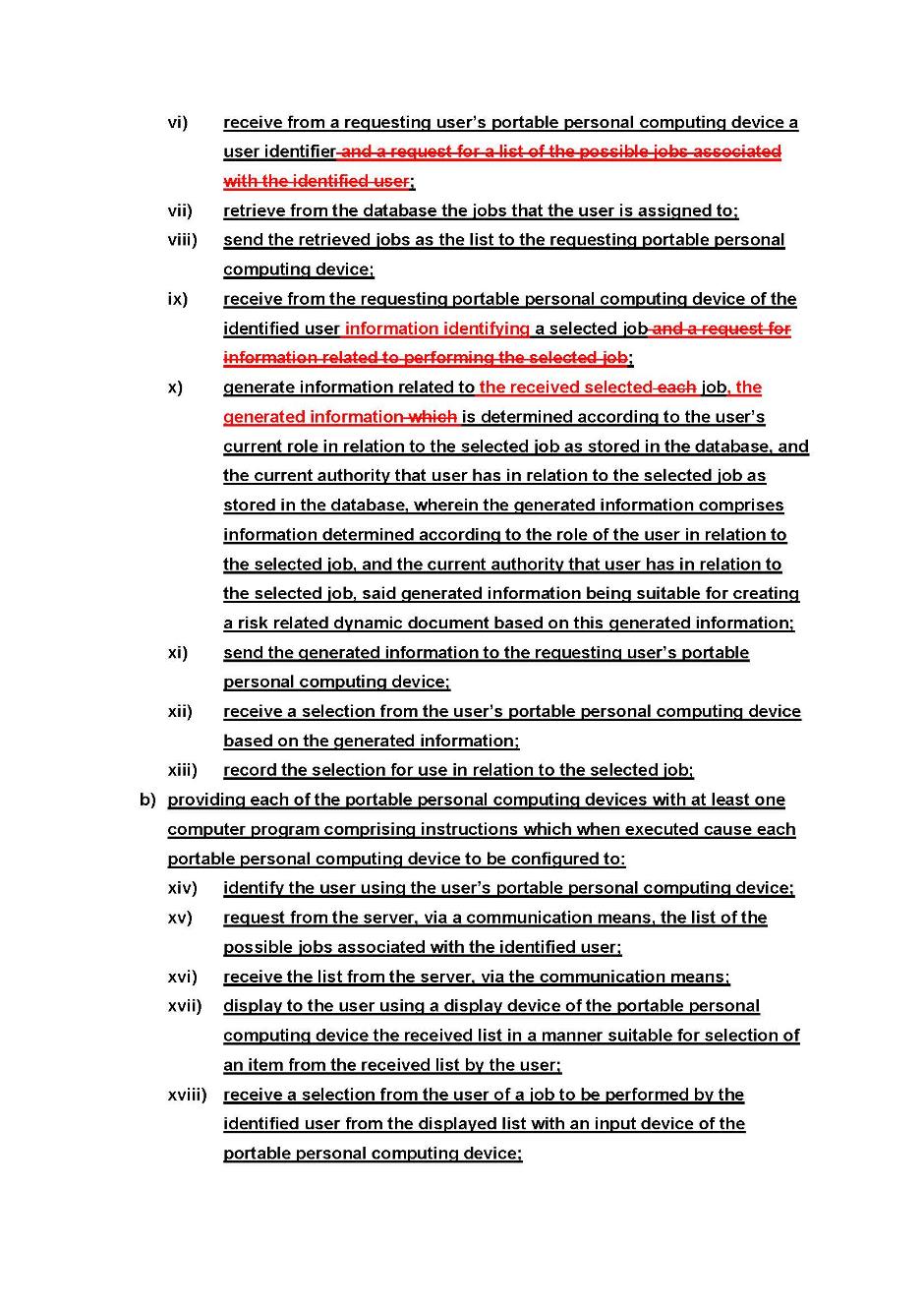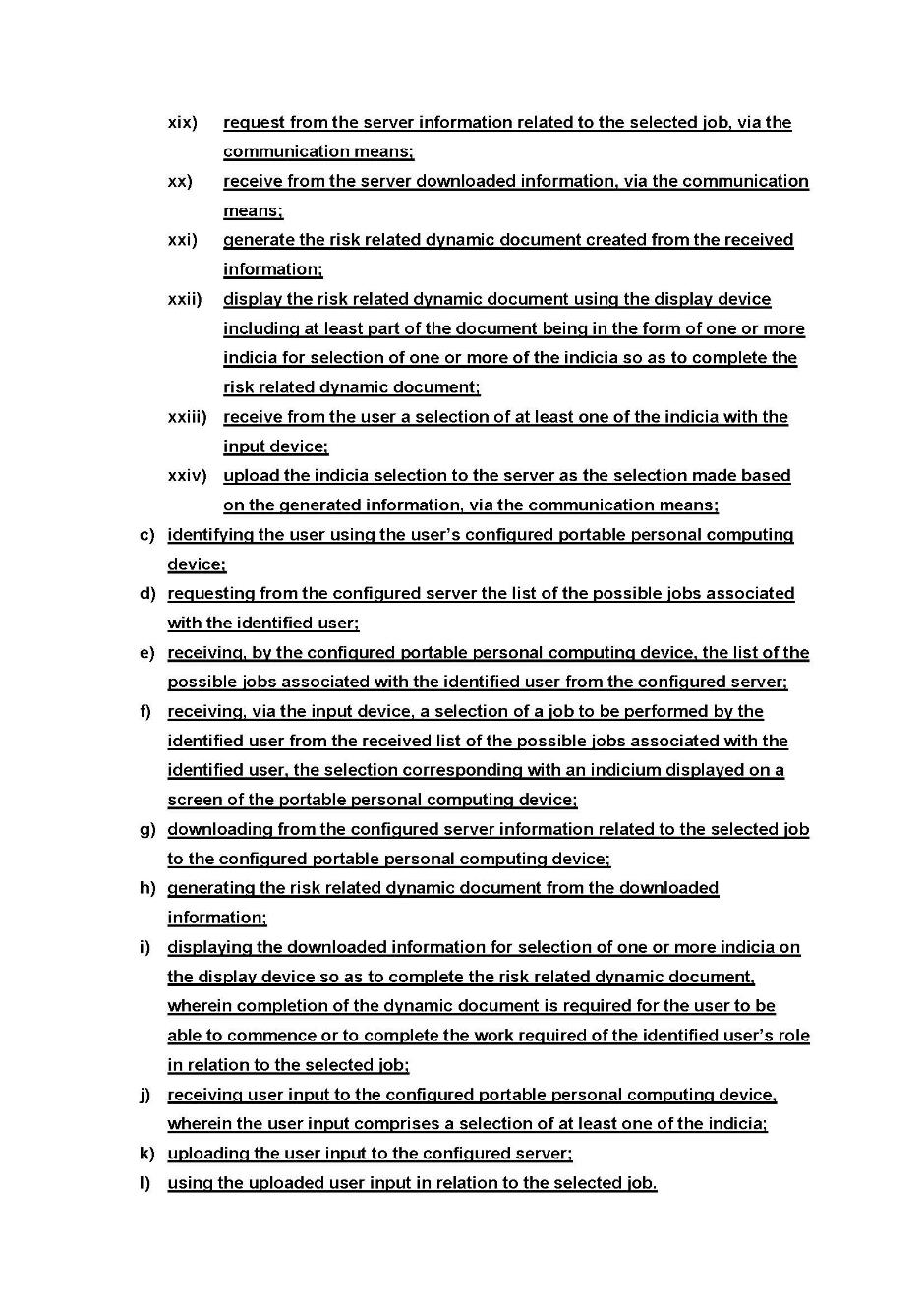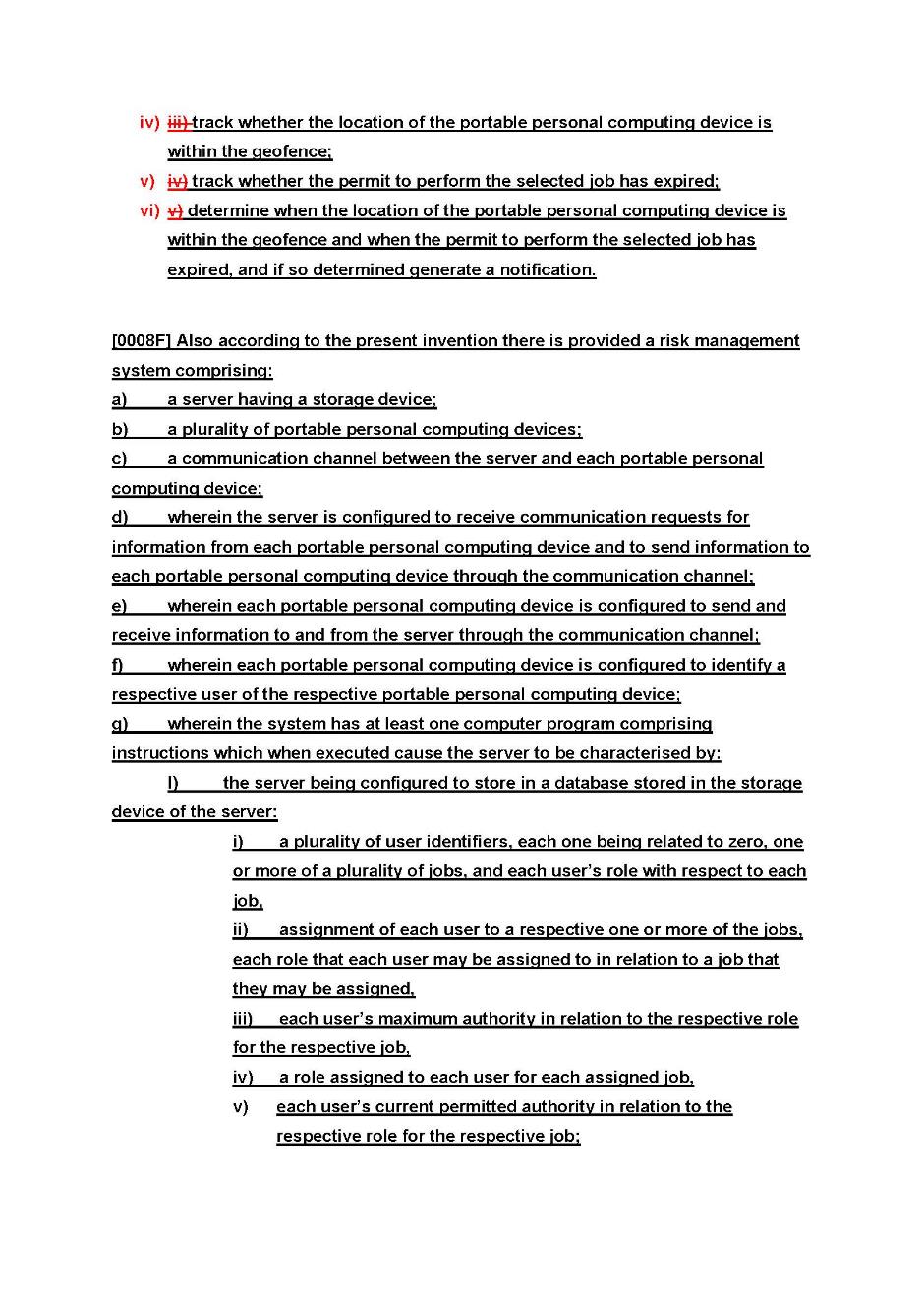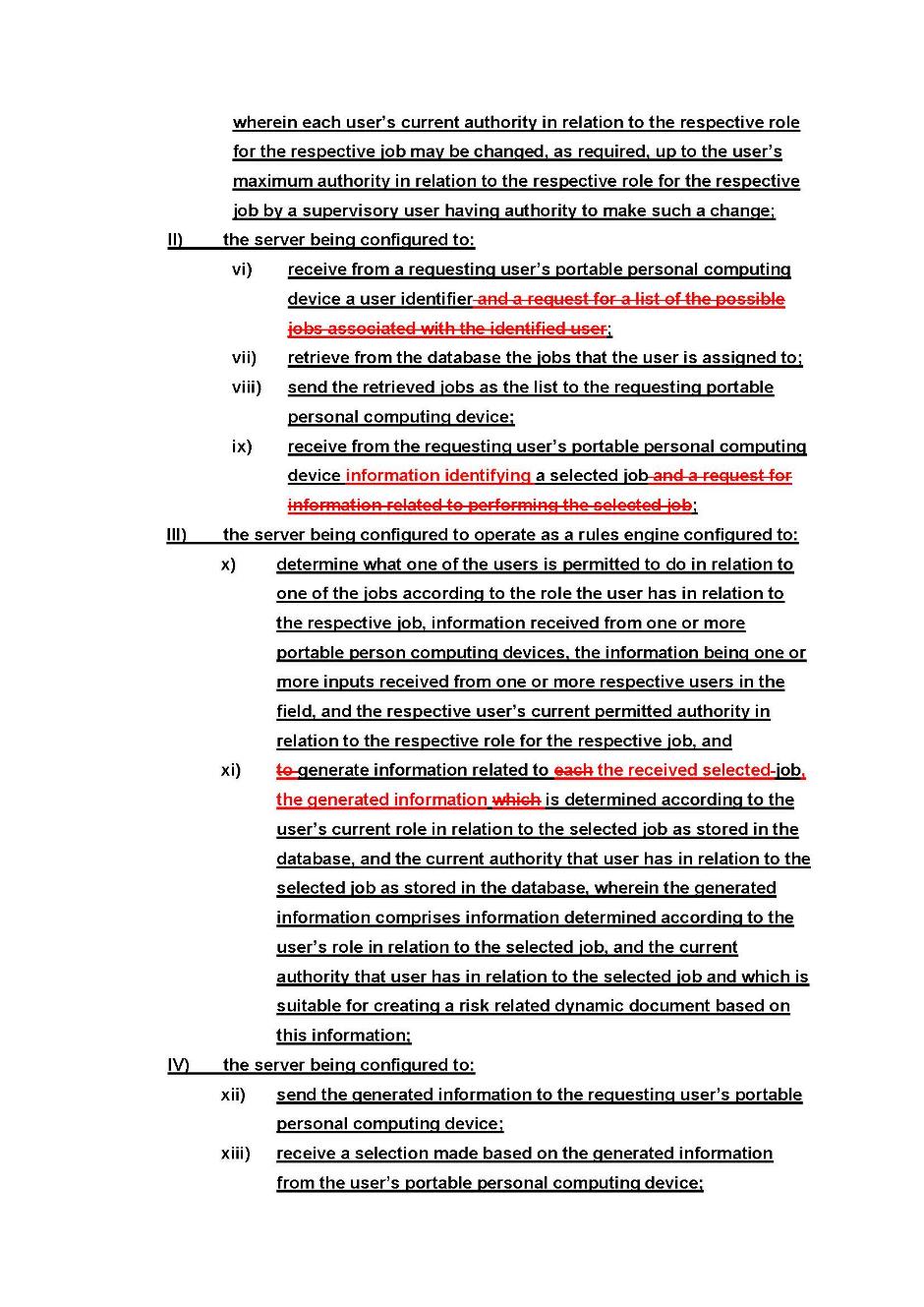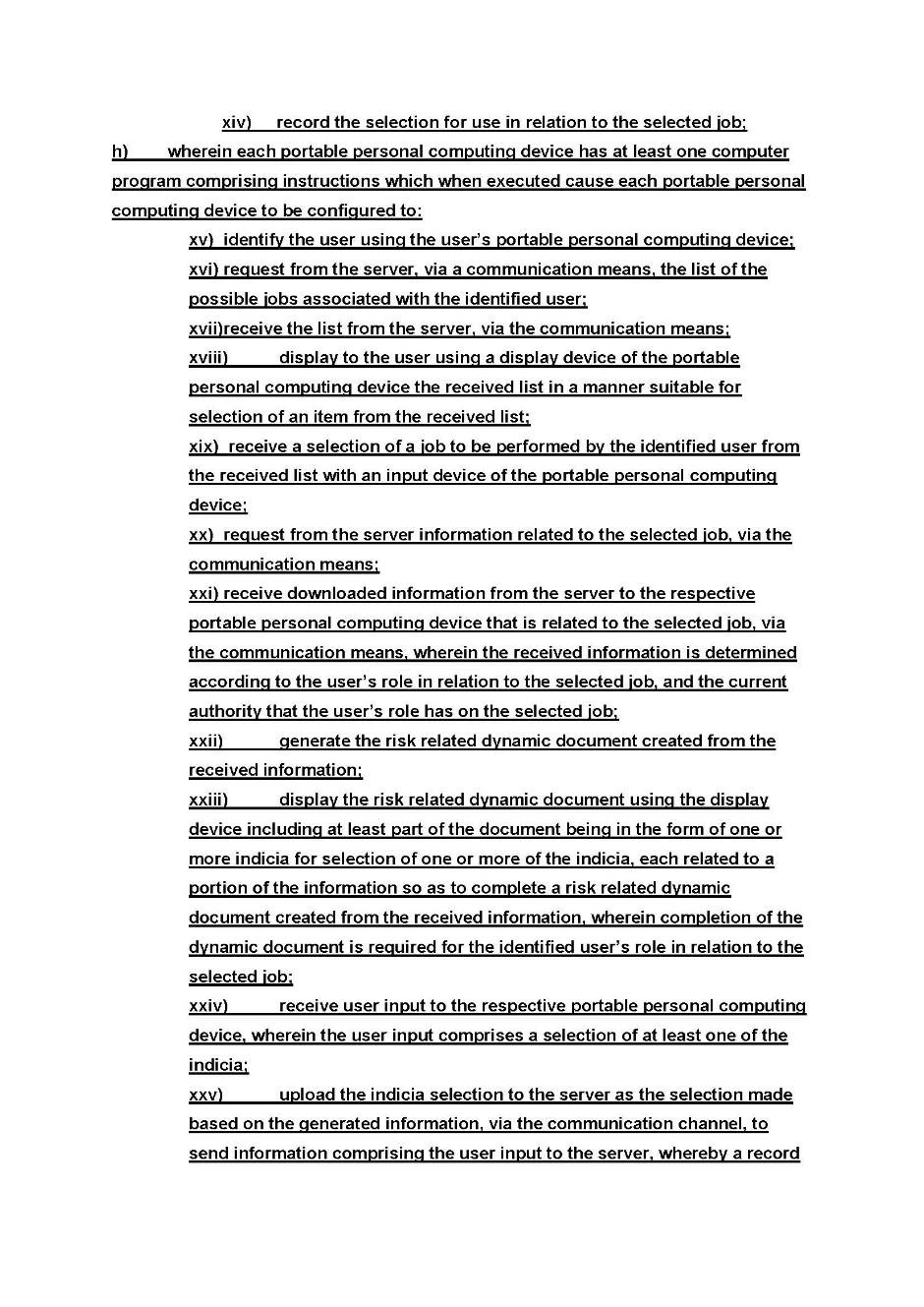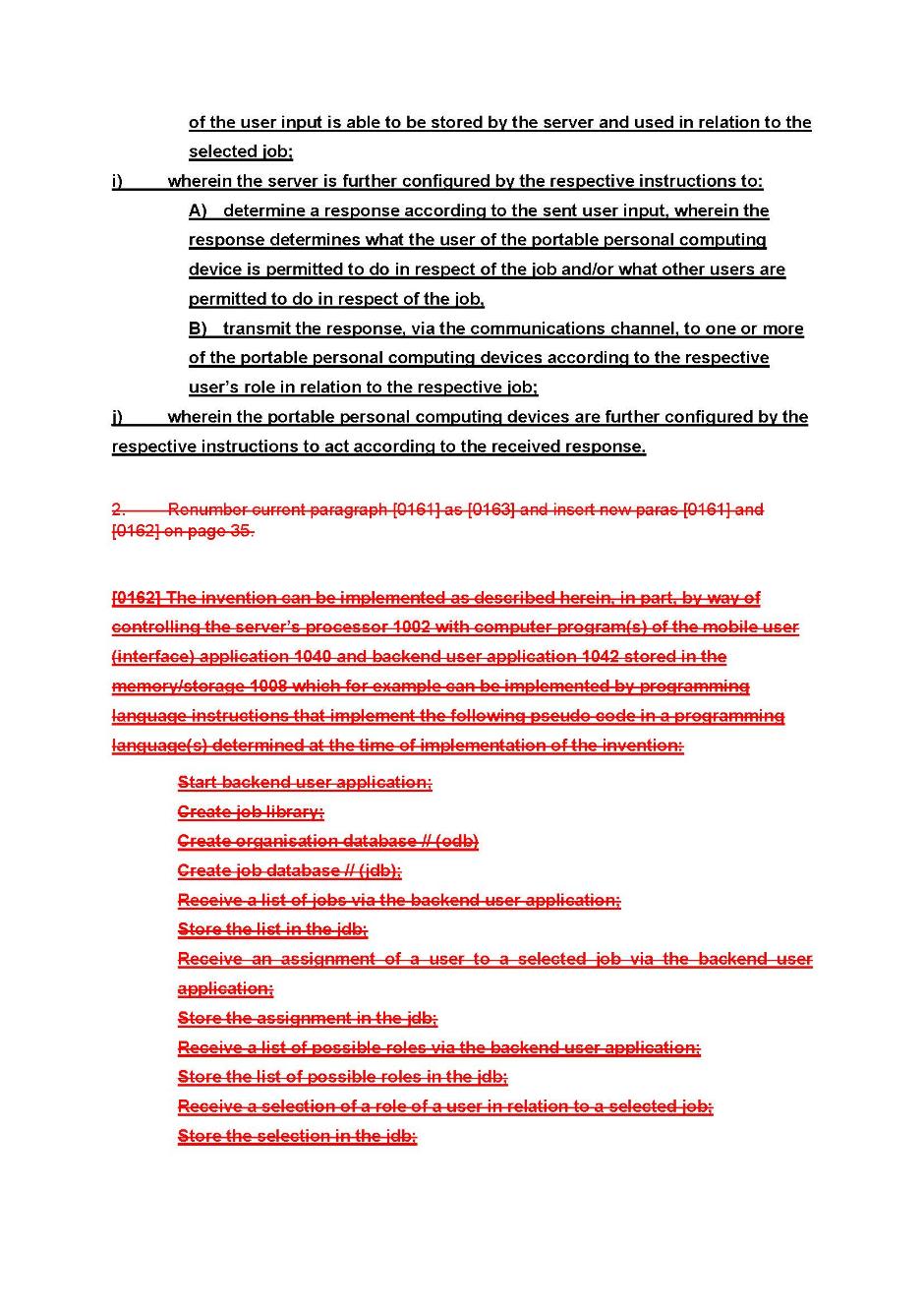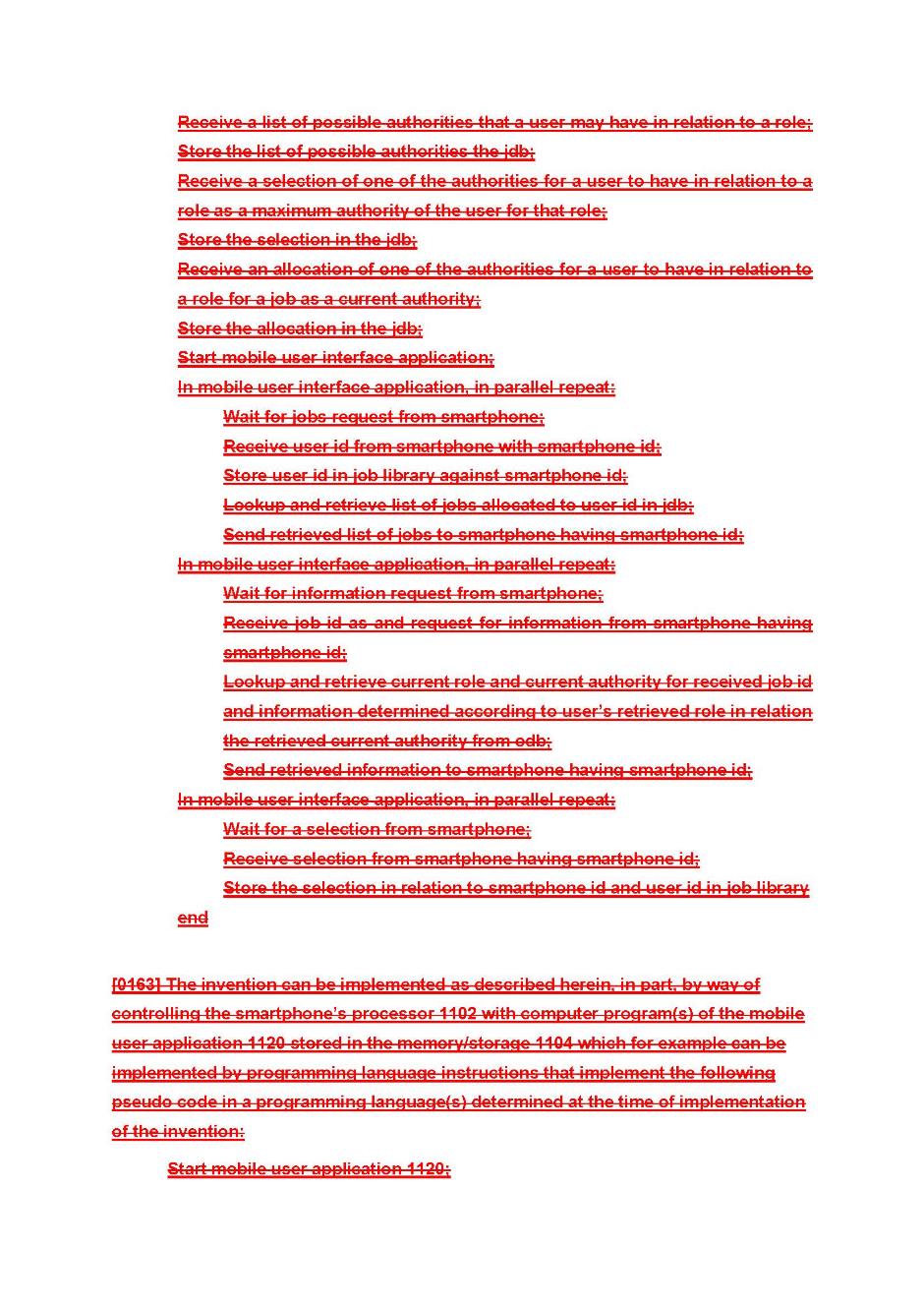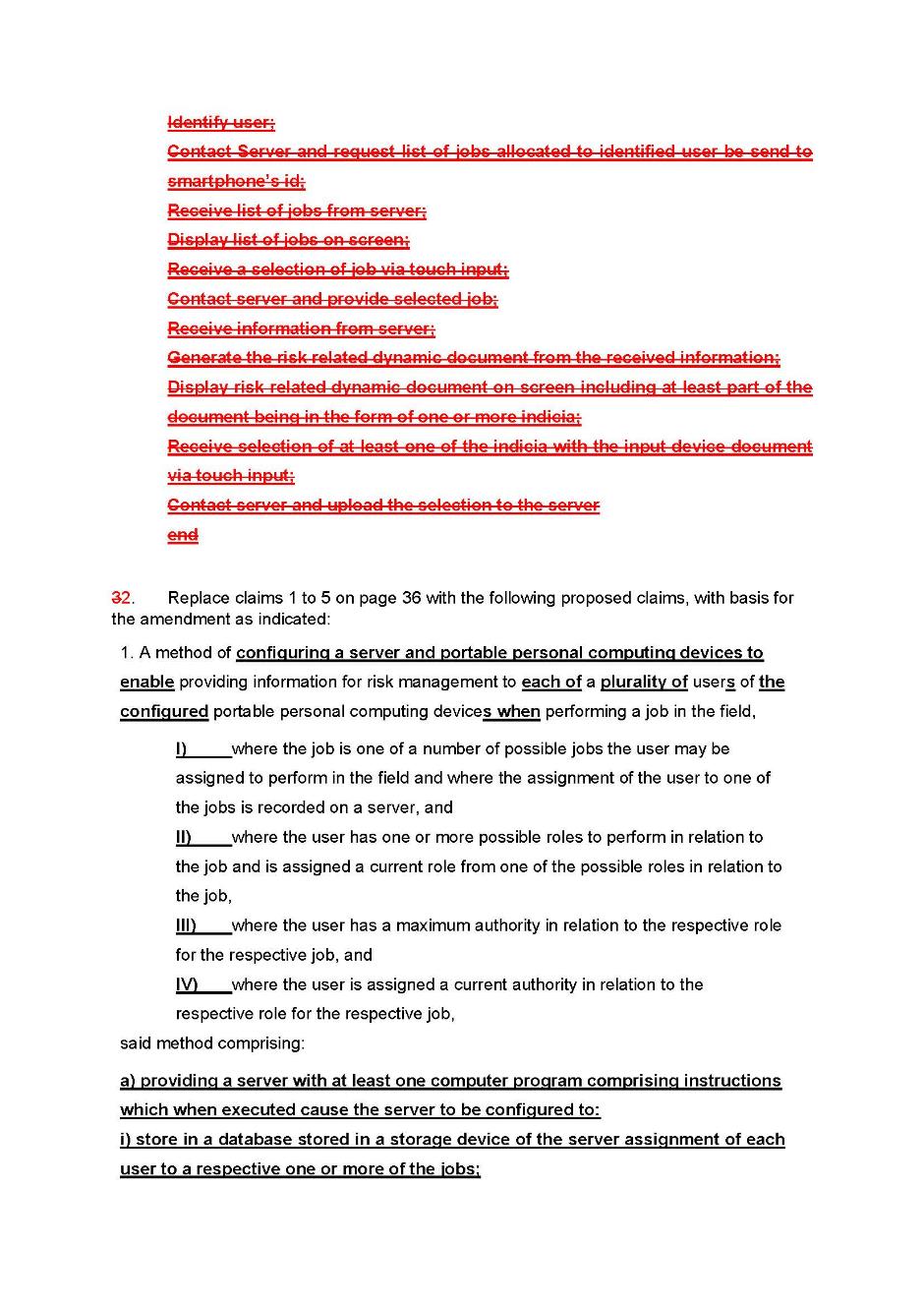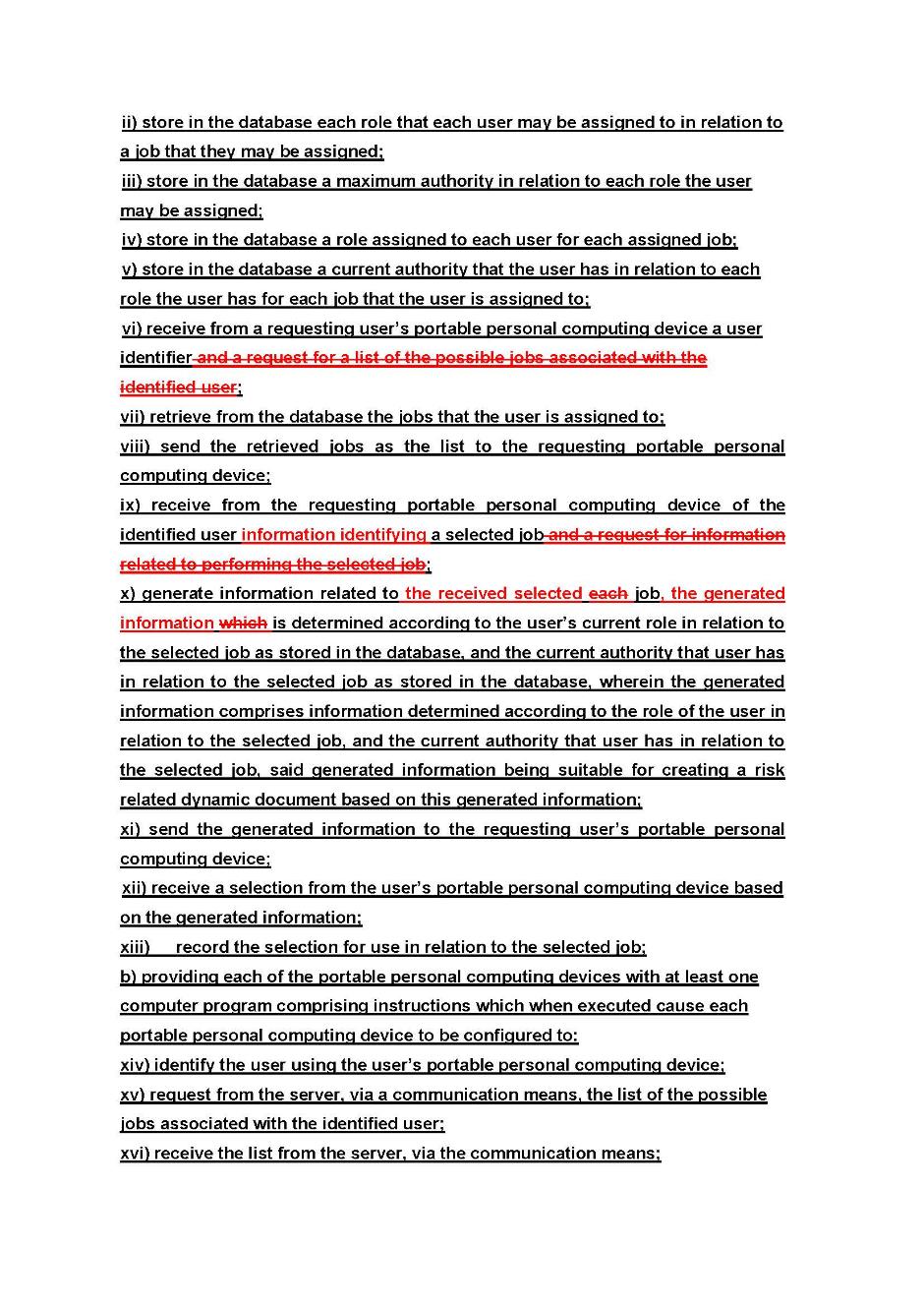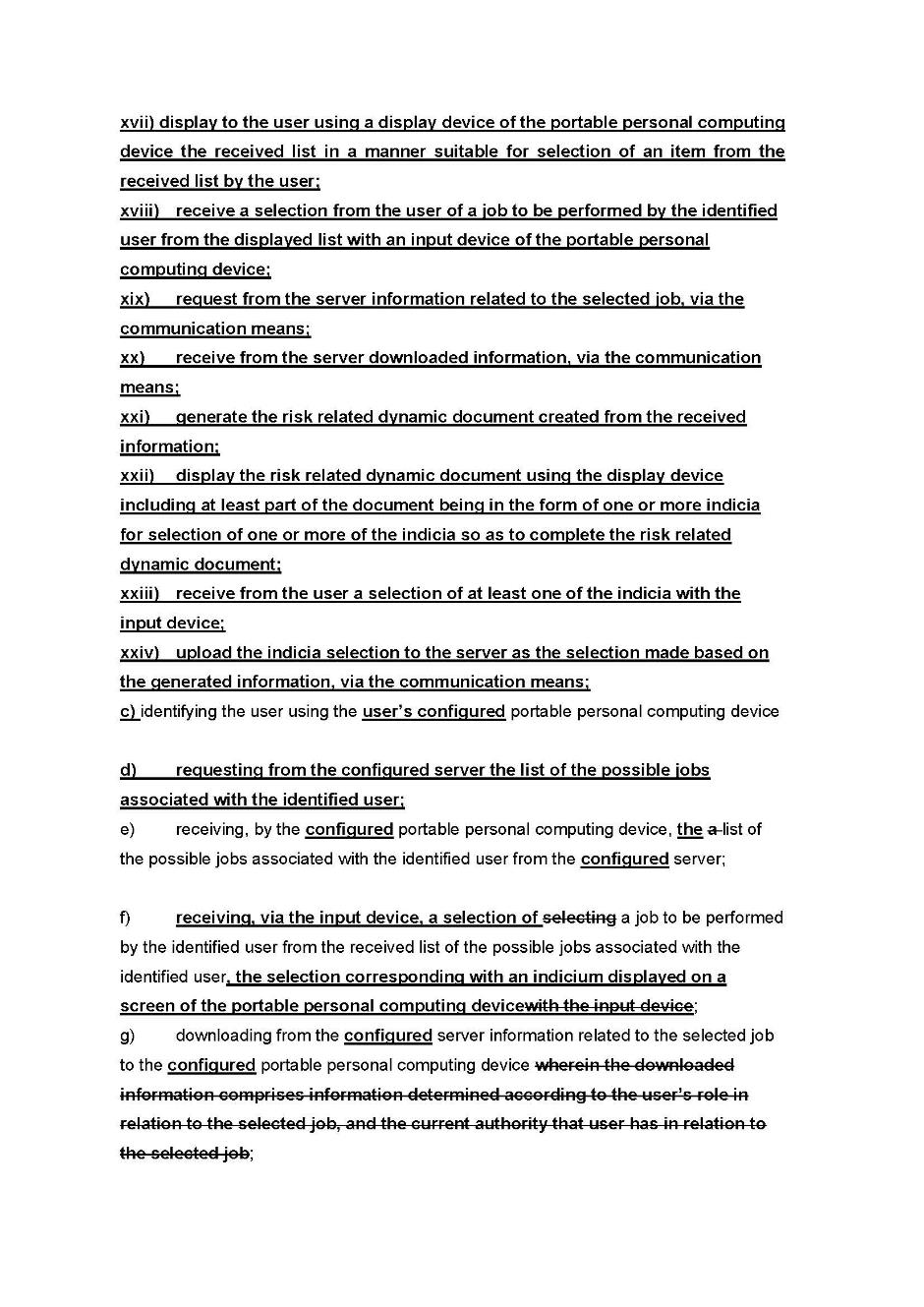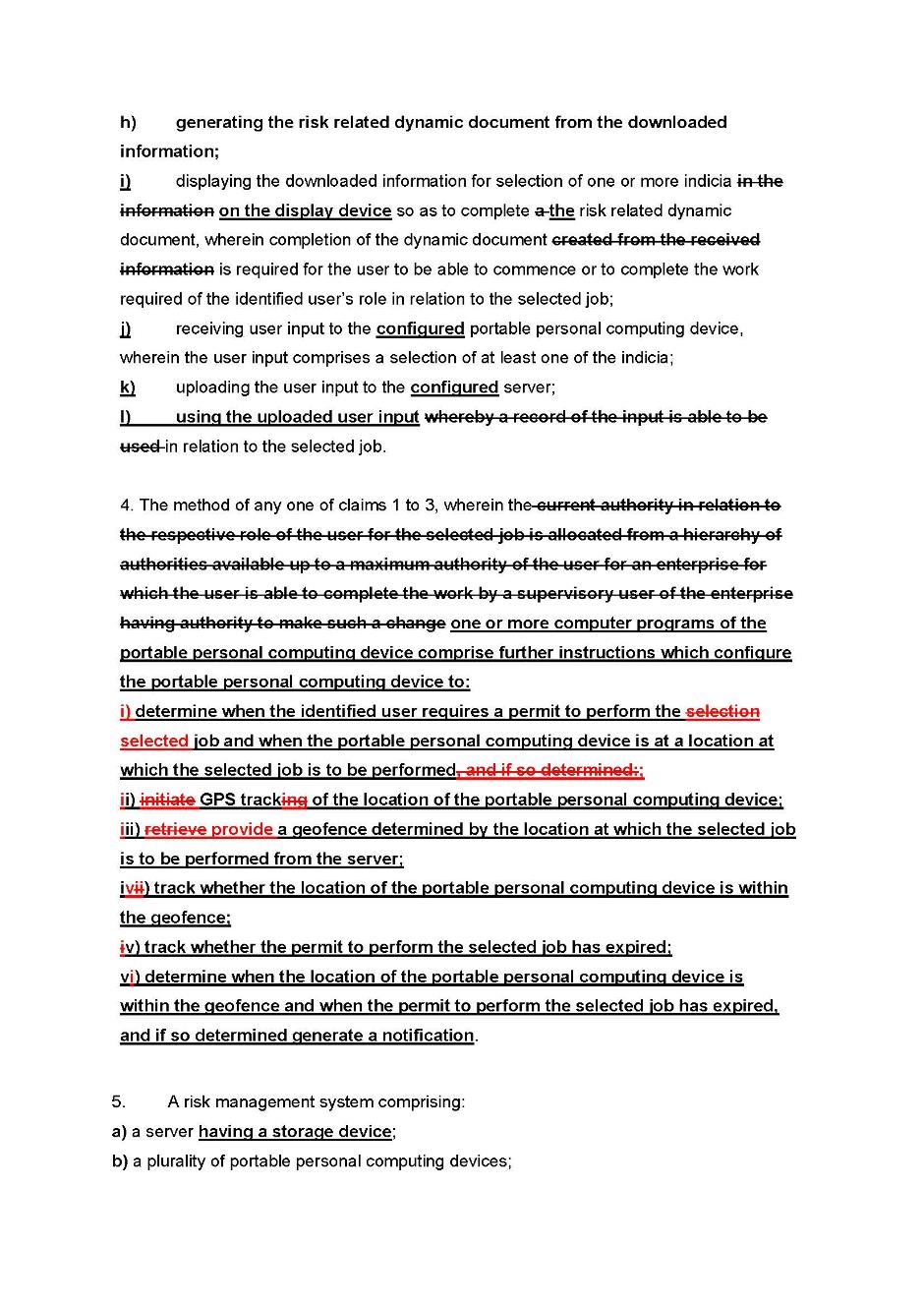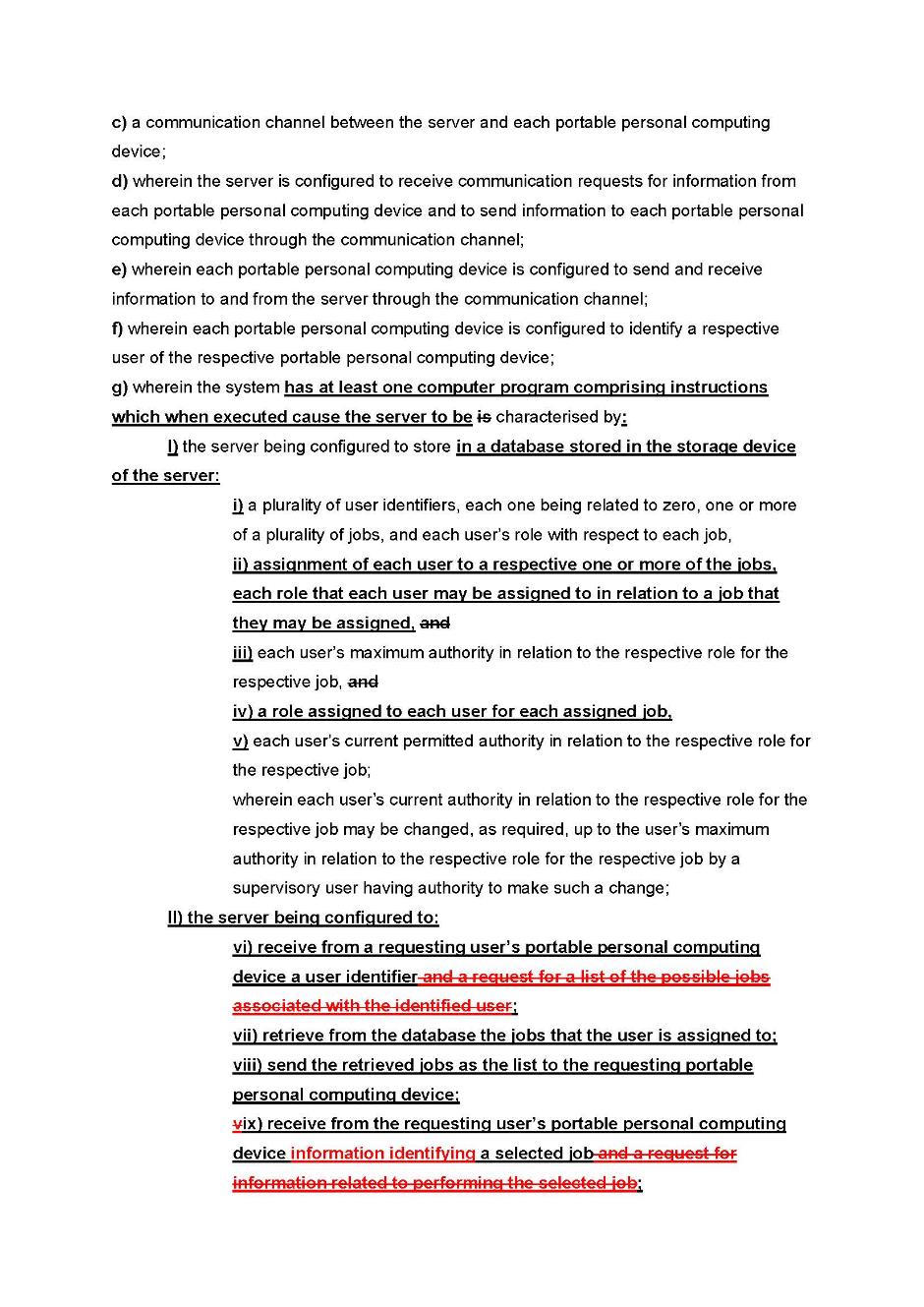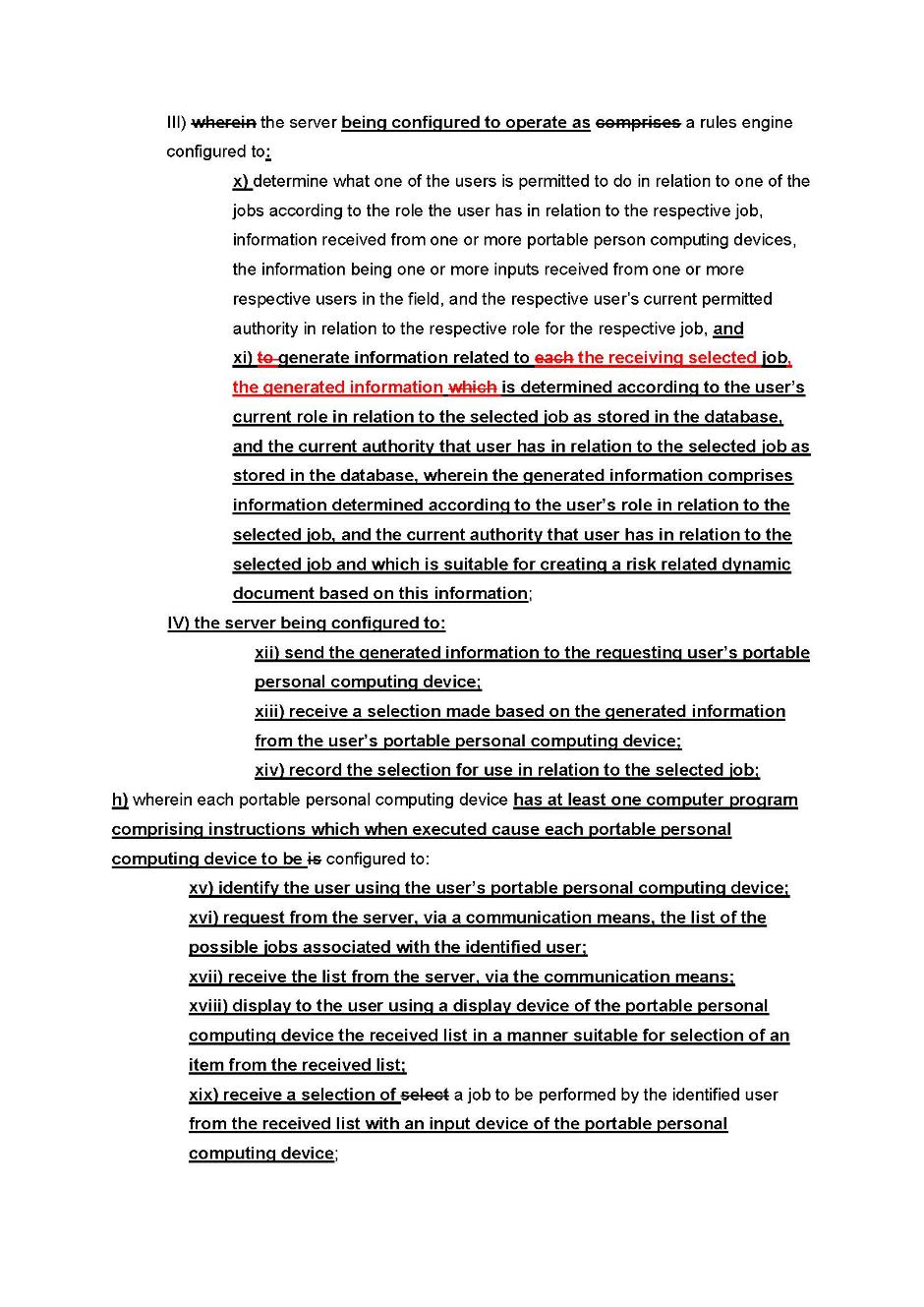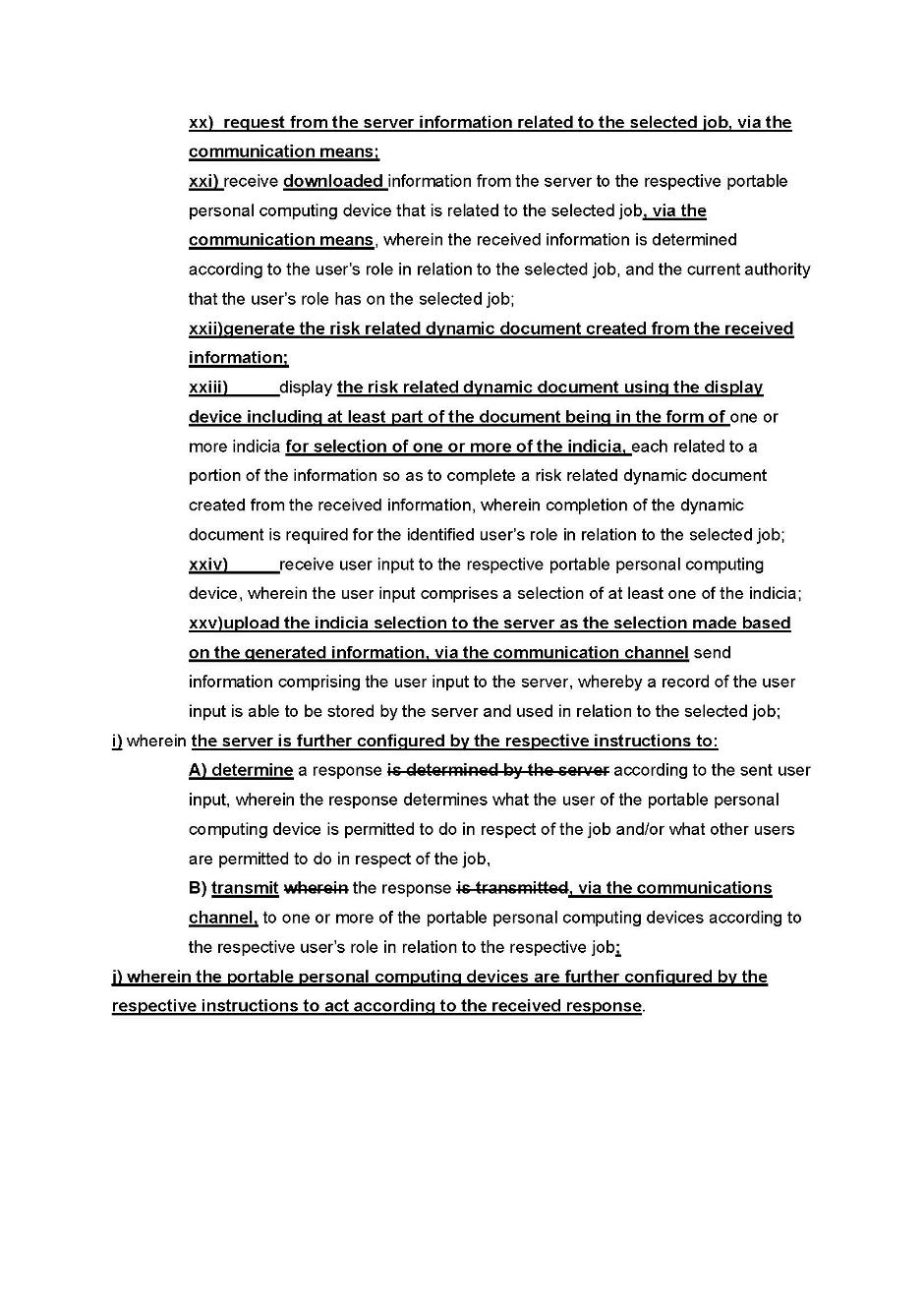FEDERAL COURT OF AUSTRALIA
Repipe Pty Ltd v Commissioner of Patents (No 3) [2021] FCA 31
ORDERS
Appellant | ||
AND: | Respondent | |
DATE OF ORDER: |
THE COURT ORDERS THAT:
1. Leave to file the appellant’s amended interlocutory application dated 17 June 2020 be refused.
2. The interlocutory application filed on 14 January 2020 be dismissed.
3. The appellant pay the respondent’s costs of the applications, to be assessed if not agreed.
Note: Entry of orders is dealt with in Rule 39.32 of the Federal Court Rules 2011.
MCKERRACHER J:
1 In Repipe Pty Ltd v Commissioner of Patents [2019] FCA 1956 (Repipe (No 1)), I dismissed the appellant’s appeal (Repipe) from the decision of the respondent (the Commissioner) to revoke certain Patents. I agreed with the Commissioner that Repipe’s patents revealed no ‘manner of manufacture’. I was persuaded, however, to permit Repipe a limited opportunity to amend the Patents so as to overcome the problems identified in Repipe (No 1). In these reasons, the same abbreviations are used as in Repipe (No 1).
2 The application to this Court to amend was made on 14 January 2020 (the First Amendment Application). Leave to amend was granted in Repipe Pty Ltd v Commissioner of Patents (No 2) [2019] FCA 2125 (Repipe (No 2)). In that decision, I expressed no view as to the likelihood, or possibility, that any amendment could overcome the defects identified in Repipe (No 1). I did form the view however that any prejudice to Repipe in not being permitted the opportunity would be far greater than any the Commissioner might have occasioned: Repipe (No 2) (at [17]).
3 In my view, the amendment applications have demonstrated that the Commissioner was right to say that if my findings in Repipe (No 1) were correct, the defects were incapable of cure by amendment. That is the conclusion I have reached in these reasons.
4 The First Amendment Application was supported by an affidavit of the Inventor, Ms Outram. She outlines the history of prosecution of the Patents, as well as the status of prosecutions of equivalent patents in foreign jurisdictions. Examinations have now occurred in Europe, Japan and the United States of America (USA). A patent eligibility objection has been made in the USA in relation to some claims, but not others. No objections have been raised in Europe or Japan.
5 In Australia, as noted, the Patents were met with manner of manufacture objections by the Commissioner. Though some minor amendments were made to address clarity issues, no amendments were made to address the manner of manufacture objections. This is said to be because the Inventor considered, on advice, that the claims were directed to inventions which are in fact a manner of manufacture, on the correct interpretation of the authorities. This position, it is argued, was not unreasonable given the difficulties attending the identification and application of the correct principles in the field at the relevant time as illustrated by the different results in CCOM Pty Ltd v Jiejing Pty Ltd (1994) 51 FCR 260 and Encompass Corporation Pty Ltd v InfoTrack Pty Ltd [2019] FCAFC 161, and what Repipe contends is the difficulty in identifying a clear principle accounting for what it says are those different results. There was, therefore, no reason to doubt the Inventor’s evidence that prior to the delivery of Repipe (No 1) on 22 November 2019, she at all times genuinely believed that the claims of each of the Patents and the form they took at the time of the hearing giving rise to the reasons in Repipe (No 1) were valid and directed to inventions that are a manner of manufacture.
6 Repipe’s 560 Patent and 943 Patent (together the Patents) claim an invention in the field of risk management for the sharing and completing of Workplace Health and Safety (WHS) documents using computer technology. The following passages from Repipe (No 1) are pertinent to an understanding of the claims:
5 Claim 1 of the 560 Patent claims:
A method of providing information for risk management to a user of a portable personal computing device performing a job in the field, said method comprising:
selecting a document to be completed by the user related to a job to be performed by the user;
downloading information to the portable personal computing device;
displaying the downloaded information for selection of items in the information so as to complete the selected document; wherein the downloaded information comprises information provided by one or more other users having an administrative role and information provided by one or more other users having a field worker role;
receiving input to the portable personal computing device, wherein the input comprises selection of one or more of the items in the information, and/or the input comprises providing new information;
uploading the input, whereby a record of the input is stored in relation to the selected document, and the new information is added to the information to be downloaded by other users.
…
7 Claim 1 of the 943 Patent claims:
A method of providing information for risk management to a user of a portable personal computing device performing a job in the field, where the job is one of a number of possible jobs the user may be assigned to perform in the field and where the assignment of the user to one of the jobs is recorded on a server, and where the user has one or more possible roles to perform in relation to the job and is assigned a current role from one of the possible roles in relation to the job, where the user has a maximum authority in relation to the respective role for the respective job, and where the user is assigned a current authority in relation to the respective role for the respective job, said method comprising:
identifying the user using the portable personal computing device;
receiving, by the portable personal computing device, a list of the possible jobs associated with the identified user from the server;
selecting a job to be performed by the identified user from the received list;
downloading from the server information related to the selected job to the portable personal computing device, wherein the downloaded information comprises information determined according to the user’s role in relation to the selected job, and the current authority that user has in relation to the selected job;
displaying the downloaded information for selection of one or more indicia in the information so as to complete a risk related dynamic document created from the received information, wherein completion of the dynamic document is required for the user to be able to commence or to complete the work required of the identified user’s role in relation to the selected job;
receiving user input to the portable personal computing device, wherein the user input comprises a selection of at least one of the indicia;
uploading the user input to the server, whereby a record of the input is able to be used in relation to the selected job.
…
9 The difference between the 560 Patent and the 943 Patent is that in the latter, the field worker has a level of authority in relation to the job as determined by a human supervisor. The downloaded information comprises information determined in relation to the selected job and the current authority that the user has in relation to the selected job and the documents required to be filled out before the worker can begin or complete the job. Thus, in claim 1 of the 943 Patent, the document is also described as a ‘dynamic document’. This means that the document is updated automatically in response to the field worker’s input.
…
12 The inventions can improve the timeliness and accuracy of risk information by:
(a) applying GPS tracking to the time and location of each access or upload;
(b) preventing frontline employees from commencing a task before controls are in place; and
(c) cross-referencing GPS and time-stamp data with other records such as incident investigations, compliance audits, and invoices.
The GPS tracking can also be used to process whether permits relating to jobs at the location of the computer have expired, with a consequent notification.
…
15 The Patents contemplate that the mobile device will be configured with searchable and expandable lists of information. The system can be configured to log data entered (for example, location records or time stamps) and then match completion of forms with commencement of, and completion of, tasks. Assignment to a job can trigger creation of a geofence (a virtual geographic perimeter) which the user should not exit or should not enter. The mobile device checks the user’s location against the geofence and creates an alert when the geofence is crossed.
…
18 The Patents contemplate that alerts can be provided to GPS-tracked field personnel when particular on-site events occur.
…
97 Repipe stresses that the claimed methods in this instance are far from abstract ideas or mere information, rather they prescribe detailed technological architecture and functional requirements for the technology and claimed technology driven solutions. However, in my view and following the Full Court’s analysis in Encompass, it must be concluded that the substance of the invention claimed in each Patent is an unpatentable business method or scheme in that:
(a) A scheme or method is claimed for sharing and completing WHS documents.
(b) The scheme or method is implemented by using computers which perform their ordinary functions.
(c) There is no invention as to the way that the computers carry out the scheme or method.
98 The problem that each Patent solves is a business problem in the field of WHS. More specifically:
(1) The problem the Patents identify is the ‘volume’ of WHS paperwork and its inefficiency. The 560 Patent, for example, records (at [0004]) that the ‘great majority of these checklists and risk assessments are paper-based – and the volume of paperwork generated is very large’. The 560 Patent also states (at [0005]):
Of course, front line employees have a natural aversion to paperwork, especially when they have done the same task or job hundreds of times. The key faults of the paperwork are:
It’s a lot like telling field employees to ‘write lines’ every day.
Field employees don’t respect the paperwork - so they arbitrage it.
It’s extremely inefficient. …
(2) The Patents do not refer to any technical problem in the field of computing.
(3) The parties’ experts identified the ‘problem’ as the inability of field workers using paper-based forms to:
(a) share new information (such as information about a newly arising hazard) with other field workers ‘in real time’, in the case of the 560 Patent; and
(b) create documents dynamically in the field, where multiple types of documents may be needed for different workers whose jobs, roles and authorities might change in the field ‘in real time’, in the case of the 943 Patent.
(4) The business problems are not problems in the field of computing.
The First Amendment Application
7 By the First Amendment Application filed on 14 January 2020, Repipe asked the Court to consider its proposed amendments on the papers. The Commissioner opposed a determination on the papers. Since then the paperwork has unexpectedly and significantly escalated, and a Second Amendment Application was filed on 17 June 2020 which is dealt with later in these reasons.
8 I have already addressed the power to amend in s 105 of the Patents Act 1990 (Cth) and the requirements of s 102 of the Act in Repipe (No 2) (at [6]-[10] and [15]-[17]). The s 102 requirements are directed to the question of whether the scope of the material in the amendments falls within the required boundaries. No steps are proposed to be deleted from the claims so Repipe argues that there will be no broadening of the claims by omission. Secondly, Repipe contends the amendments add significant detail to the configuration requirement of the server and smartphone device to enable performance of the steps which provide considerably more substance to the sequence of interactions involving the server and a smartphone device. Repipe says this is intended to make clear that the subject matter of the claims is, in substance, a new and innovative method of controlling a server and smartphone. It is also intended, Repipe says, to include certain features which were disclosed in the body of the specification, but not previously claimed.
9 Repipe contends that in both cases, the claims do not travel beyond the matter disclosed in the specification and so are not barred by s 102 of the Act. In this respect, the Court had the advantage, Repipe says, of the evidence adduced in the proceedings to date from persons skilled in the art, in particular, the uncontested evidence of Dr Aitken (see Repipe (No 1) at ([56]-[60], [74]-[76] and [84]) in order to construe what was implicitly disclosed in the unamended claims and specifications.
10 Repipe also says that insofar as the initial amendments have been made to the body of the specification, they are either consistory statements or, in a similar fashion, set out pseudo code. Pseudo code, Repipe explains, is human-understandable computer program instructions, which can be translated into machine level understandable computer program instructions by a skilled addressee. It defines what each of the server and smartphone must be programmed to do. Repipe relied on the same disclosures in support of these amendments as for the corresponding claims. As a result of exchanges since the filing of the First Amendment Application, the inclusion of pseudo code has been abandoned.
11 In relation to the s 105 discretion, Repipe relies upon the observations of Sundberg J in Wimmera Industrial Minerals Pty Ltd v RGC Mineral Sands Ltd (No 3) [1997] FCA 1063; (1997) AIPC 91-366 (at 363). His Honour said that if the s 102 requirements were met and there was no reason to refuse the amendments, they should be allowed. This observation is, with respect, no doubt correct, but in my view, does not greatly assist Repipe.
12 My findings (at [93] and [94]) in Repipe (No 1) were as follows:
93 … The substance of both inventions is a mere scheme that can be implemented using some unidentified software application to cause a server computer and smartphone to perform the steps identified in the claim. ...
94 … The language used by patent attorneys when drafting and amending claims cannot convert what is, in substance, an unpatentable business method or scheme into a patentable invention by merely asserting that the invention is in the field of computer technology or by using words in the claim or specification that refer to computer technology…
13 The amendments include, amongst other things, a geofencing feature, described at [0009], [0018], [0064], [0104], [0120] and [0140]. This utilises a combination of features including geofence determinations, GPS tracking, permission tracking and notification in order to notify a device when, by reason of its location outside an electronically determined boundary, its user was not permitted to perform a job. Repipe says it would be quite inapt to describe that feature as a ‘mere scheme’. By analogy with CCOM (at [294B]-[295A]), Repipe argues that it constitutes as part of the claimed combination, patentable subject matter.
14 It is unnecessary to dwell further at this stage on the initial amendments because, as will be seen, as a result of objections taken by the Commissioner, further amendments have been proposed.
The Commissioner’s objections to the First Amendment Application
15 The Commissioner contended that Repipe’s First Amendment Application was fundamentally misconceived as, although framed as an application to amend the specifications, it was in substance an application to reopen and rehear a case in circumstances that would not be permitted on the application of the usual principles regarding the finality of litigation: see for example, Aristocrat Technologies Australia Pty Ltd v IGT (Australia) Pty Ltd [2007] FCA 1529 per Allsop J (as the Chief Justice then was) (at [7]-[11]). The Commissioner observed that Repipe was accorded a full opportunity to bring forward a case and a claim set that encapsulated its invention and there was no missed opportunity or misapprehension of a kind that might justify reopening. The Commissioner says the First Amendment Application as filed could not be characterised as being an application to ‘address’ the Court’s decision in Repipe (No 1). This was not a case in which the Court had accepted, for example, that patentable subject matter was disclosed and that the deficiency might be addressed by making amendments to the claims, in contrast to Meat & Livestock Australia Ltd v Cargill, Inc (2018) 129 IPR 278; [2018] FCA 51 per Beach J (at [944]-[945]).
16 To the contrary, the Commissioner says the Court found, in substance, that no patentable subject matter was disclosed or claimed in the specifications of the Patents. In this context, it is said that the limited grant of leave to amend the Patents did not extend to seeking to sidestep the decision in Repipe (No 1) by asking for a fresh determination. As a matter of form, the Commissioner argues, what Repipe has sought to do is to add detail into the claims which it contends are properly drawn from the body of each specification and common general knowledge. The Commissioner says there are several difficulties with this, but at a general level, either the detail is in fact properly drawn from the specification in which it cannot transform the substance of the invention into a manner of manufacture given the Court’s findings in Repipe (No 1) or, it is not so drawn, in which case the amendments cannot be allowable under s 102 of the Act. It is said that Repipe’s approach generally ignores the principle that the claims are to be considered as a matter of substance, not form, and that a computer-implemented scheme that requires merely generic computer implementation will not be patentable. Again, the Commissioner says the addition of generic detail cannot assist Repipe in this regard. Detail that is not truly generic cannot be added by amendment.
17 The Commissioner further argues that Repipe’s First Amendment Application should be refused because:
(a) the amendments do not overcome the findings in Repipe (No 1) that the substance of the invention is merely a scheme, such that the claimed invention is not a manner of manufacture. Therefore, it would be futile to allow the amendments and the Court should not exercise its discretion to do so;
(b) the amendments are not allowable under s 102 of the Act. Indeed, if the amendments did alter the substance of the invention such that it were now capable of being characterised as a manner of manufacture, this would be even more plainly so; and
(c) the principle of finality of litigation strongly reinforces the conclusion that Repipe’s First Amendment Application should be refused.
18 The Commissioner emphasizes that the key findings in Repipe (No 1) concerning the Patents include the following:
(a) each Patent solves a business problem in the field of WHS: (at [98]);
(b) the substance of the invention in each Patent is merely a business method or scheme, requiring generic computer implementation: (at [93], [95]-[97]);
(c) there is no meaningful technical content in either the description in the body of the specification or the claims: (at [94] and [99]); and
(d) to the extent that ‘specific application software’ is needed to implement the invention, this is not disclosed or claimed, and it is not the substance of the invention: (at [100]).
19 At [101] of Repipe (No 1) the conclusion reached was that:
The claimed inventions are as to a business method. Even if construction of the specifications alone were to produce a different characterisation, that would be to elevate form over substance. The Patents may well contain a good idea, but they are not a manner of manufacture and are not patentable subject matters.
(Emphasis added.)
20 The first category of amendment is the addition to the claims of each Patent of so-called ‘configuration requirements of the server and smartphone devices to enable performance of the steps’ of the scheme. The claims that are the subject of the configuration amendments are: 560 Patent claims 1, 2 and 5, and 943 Patent claims 1, 4 and 5. For example, the amendments to claim 1 of the 560 Patent add two categories of amendments. The first category is the addition of ‘configuration’ steps that are underlined below. For the words in italics, the Commissioner contends that the form is altered by adding words that merely reference generic hardware that is configured to perform generic (ordinary) computer functions:
A method of configuring a server and portable personal computing devices to enable providing information to be provided for risk management to each of a plurality of users of the configured a portable personal computing devices when performing a job in the field, said method comprising:
a) providing a server with at least one computer program comprising instructions which when executed cause the server to be configured to:
i) store in a storage device of the server information associated with a document for users in the field to complete when making a risk assessment of the job, where some of the information is obtained from the field by users having a field worker role and some of the information is obtained from users with an administrative role;
ii) receive an identity of a user of a requesting portable personal computing device along with a request for the download of information associated with a selected document from the requesting one of the plurality of portable personal computing devices remotely located in the field;
iii) retrieve the information from the storage device in response to the request;
iv) send the retrieved requested information to the requesting portable personal computing device;
v) receive an uploaded input from the requesting portable personal computing device;
vi) store the uploaded input in relation to the selected document and the identity of the user of the requesting portable personal computing device;
vii) determine whether the uploaded input is already in the stored information; and
viii) when the uploaded input is not already in the stored information then update the stored information to include the uploaded input so that the uploaded input is included in the retrieved requested information that is sent when there is a subsequent request so that the new uploaded input is provided to other users;
b) providing each of the portable personal computing devices with at least one computer program comprising instructions which when executed cause each portable personal computing device to be configured to:
ix) display to the user of the portable personal computing device on a display device of the portable personal computing device a plurality of documents from which a selection of one of the documents can be made by the user;
x) receive a selection of a document from the user via an input device of the portable personal computing device;
xi) request information from the server associated with the selected document, via a communication means, and with the request provide to the server the identity of the user;
xii) receive the requested information from the server, via the communications means;
xiii) display the information received from the server on the display device in a manner that allows for selection of items from the displayed information;
xiv) receive from the user, via the input device, an input as a selection of one or more of the displayed items;
xv) receive from the user an input of new information, via the input device, the new information being of a type that is suitable to send to other users in the field; and
xvi) send the input to the server, via the communication means;
c) when the user is in the field, selecting a document to be completed by the user related to a job to be performed by the user in the field from documents displayed to the user by the user’s configured portable personal computing device;
d) communicating the identity of the user and the document selected from the configured portable personal computing device to the configured server;
e) retrieving stored information from the storage device of the configured server based on the communicated document selected;
f) downloading retrieved information from the configured server to the user’s configured portable personal computing device;
g) displaying the downloaded information on the display device of the user’s configured portable personal computing device for selection of items in the information so as to complete the selected document; wherein the downloaded information comprises information provided by one or more other users having an administrative role and information provided by one or more other users having a field worker role;
h) receiving input from the user to the input device of the user’s configured portable personal computing device, wherein the input comprises selection of one or more of the items in the information, and/, or instead, the input comprises providing new information;
i) uploading the input to the configured server;
j) whereby storing a record of the input is stored in relation to the selected document and the identity of the user; and
k) adding the new information is added to the information to be downloaded by the configured portable personal computing devices of other users when there is new information.
(Underline indicates amendment.)
21 The Commissioner argues that the amendments set out above have not altered the substance of the invention, and cannot alter the conclusion that the invention disclosed and claimed is not a manner of manufacture. Applying the principle at [94] of Repipe (No 1), the language used by Repipe’s patent attorneys in drafting the ‘configuration’ amendments is incapable of overcoming the Court’s decision that there is no manner of manufacture. The Commissioner says the amendments do nothing more than alter the form of the claim. They do not alter its substance.
22 The Commissioner points out that the computing devices configured to implement the scheme remain a standard (generic) server and smartphone/tablet, communicating via a generic network: see Repipe (No 1) (at [99]). Further, the computer functions being performed to implement the scheme remain entirely generic, eg, ‘storing’ information on a server; ‘receiving’ information or requests from a generic portable computing device; ‘retrieving’ information from a generic storage device; and ‘sending’ information to the requesting portable personal computer device: Repipe (No 1) (at [97]). Further still, the position remains that the claims do not disclose the ‘specific application software’ that a skilled person will have to write in order to program the generic hardware to perform the generic computer functions: Repipe (No 1) (at [100]).
23 The second category of amendment involves the addition to certain claims of features that concern GPS tracking. The claims affected by these amendments are claim 5 of the 560 Patent and claim 4 of the 943 Patent. Proposed amended claim 5 of the 560 Patent reads (with the additions underlined):
The method of claim 1, wherein the instructions of the portable personal computer devices further configure the portable personal computing device to:
xxvi access a GPS unit of the portable personal computing device to determine its current location when the input is uploaded to the server and to also upload to the server the current location and current time;
wherein the instructions of the server further configure the server to:
xxvii) receive the uploaded current location and current time; and
xxviii) store the current location and current time in the record in association with the uploaded input;
wherein the method further comprises:
xxix) determining the current location of the portable personal computing device and current time; including the current location and current time in the upload to the server; and
xxx) storing the current location and current time in the record in association with the uploaded input.
(Italics added.)
24 Proposed claim 4 of the 943 Patent reads:
The method of any one of claims 1 to 3, wherein the current authority in relation to the respective role of the user for the selected job is allocated from a hierarchy of authorities available up to a maximum authority of the user for an enterprise for which the user is able to complete the work by a supervisory user of the enterprise having authority to make such a change one or more computer programs of the portable personal computing device comprise further instructions which configure the portable personal computing device to:
determine when the identified user requires a permit to perform the selection job and when the portable personal computing device is at a location at which the selected job is to be performed, and if so determined:
i) initiate GPS tracking of the location of the portable personal computing device;
ii) retrieve a geofence determined by the location at which the selected job is to be performed from the server;
iii) track whether the location of the portable personal computing device is within the geofence;
iv) track whether the permit to perform the selected job has expired;
v) determine when the location of the portable personal computing device is within the geofence and when the permit to perform the selected job has expired, and if so determined generate a notification.
25 Again, the Commissioner says these amendments cannot overcome the Court’s conclusion that the substance of the invention disclosed and claimed is merely a scheme. As with the first category of amendment discussed above, the Commissioner argues that the italicised phrases in the passage above do nothing more than describe the generic features and processes of computer technology. When finding that the invention of each patent was merely a scheme, I was conscious that the specification already disclosed the use of GPS tracking, cross-referencing, and geo-fencing as an optional feature of the scheme: Repipe (No 1) (at [12] and [15]). This did not alter my conclusion that the invention was an unpatentable business method or scheme.
26 The third category of initial amendments was the additions to the description in each Patent, which include consistory statements for the amended claims and (according to Repipe) ‘pseudo-code’. The consistory statements appear at [0008A] to [0008E] of the 560 Patent, and [0008A] to [0008F] of the 943 Patent. The ‘pseudo-code’ amendments appear at [0154] to [0155] of the 560 Patent and [0162] to [0163] of the 943 Patent. These have now been abandoned.
27 As a second major issue the Commissioner has raised s 102 of the Act. Section 102(1) of the Act, as applicable to the Patents, provides that an amendment to the complete specification of a patent is not allowable ‘if, as a result of the amendment, the specification would claim or disclose matter that extends beyond that disclosed’ in, relevantly, the complete specification as filed. This invites consideration of whether the subject matter Repipe wishes to add to the description and claims by amendment was disclosed in the specification of each Patent as filed. If it was not, then the amendments are not allowable under s 102(1), and cannot be permitted by the Court: see s 105(4) and Commonwealth Scientific and Industrial Research Organisation v BASF Plant Science GmbH [2020] FCA 328 per Beach J (at [169]-[222]).
28 The Commissioner contended that that there are numerous aspects of the initial amendments that involved the addition of features or details not disclosed anywhere in the specifications of the Patents as filed. For present purposes, this may be assessed by reference to the specifications in their current form, prior to the proposed amendments. Although the pseudo code amendments have now been abandoned, other examples were:
(a) in relation to claim 1 of the 560 Patent extracted above (at [20]), at least the following items of the claim are, or include features, not disclosed in the specification as filed: (a)(ii) to (viii) inclusive; (b)(xi) and (xii); (d) and (e); and
(b) in relation to claim 4 of the 943 Patent extracted above (at [24]), at least the following items of the claim are, or include features, not disclosed in the specification as filed: the second part of the preamble (beginning ‘determine …’); and (i) to (v) inclusive.
29 Repipe argues that the amendments it proposes are not barred by s 102 and that there is no other reason to refuse the amendments, such that they should be allowed. In light of the Court’s concern that the unamended claims constitute a ‘mere scheme’, the amended claims reflect, Repipe argues, a level of specificity of the interactions involving the server and the smartphone device in the invention which is indistinguishable from the claims in CCOM, found by the Full Court to be a manner of manufacture and affirmed in Encompass. Repipe says it is apparent from CCOM that patent claims do not have to specify a software application or program code to constitute a manner of manufacture. Thus, ‘specificity’ of that level is not required. It is sufficient that the invention may be defined simply by reference to the desired function, similarly to claims in other fields of technology. Thus, Repipe contends the amendments to the claims respond directly to the Court’s concern.
30 The proceeding to deal with the First Amendment Application was listed for hearing on 17 June 2020. On the morning of the hearing, Repipe served a proposed Second Amendment Application on the Commissioner to deal with objections the Commissioner had raised. The Commissioner opposed proceeding with the matter on that date due to the short notice. The hearing was then adjourned until 1 September 2020 to enable the Commissioner to respond to the Second Amendment Application and the amendments to the amendments proposed therein.
Further amendments in the Second Amendment Application
31 It is convenient now to deal with the Second Amendment Application. It contemplates ‘amendments to the amendments’ that Repipe seeks to make to both Patents and more specifically:
(a) withdraws the amendments that seek to add ‘pseudo code’ to the specification of each Patent; and
(b) proposes further amended claims and corresponding claim consistory statements to try to overcome the Commissioner’s position that the amendments set out in the First Amendment Application were not allowable under s 102 of the Act.
32 Apart from the deletion of the pseudo code amendments, the Commissioner opposed the grant of leave to file the Second Amendment Application. She also opposed the making of the amendments set out in the Second Amendment Application under s 105(1A) of the Act for various reasons. She said that, as with the First Amendment Application, the three essential difficulties with the proposed amendments are, first, that they do not overcome the Court’s decision that the substance of the invention is merely a scheme, such that the claimed invention was not a manner of manufacture. Consequently, the amendments in the Second Amendment Application are futile. Further, the proposed amendments in the Second Amendment Application are also barred by s 102 of the Act. Additionally the Commissioner says, the principles concerning the finality of litigation strongly favour refusing to allow Repipe to propose further amendments to the Patents by the Second Amendment Application.
33 The Second Amendment Application alters the proposed amended claim wording for claim 1 of the 560 Patent; claims 1, 4 and 5 of the 943 Patent; and the corresponding consistory statements at 560 Patent [0008A] and 943 Patent [0008A], [0008E] and [0008F]. By way of illustrative example, in the case of claim 1 of the 560 Patent, the Second Amendment Application:
(a) alters proposed amended integer 1(a)(viii) in the First Amendment Application as follows: ‘when the uploaded input includes new is not already in the stored information then update the stored information to include the uploaded input new information so that the uploaded input is included in the retrieved requested information that is sent to other users when there is a subsequent request for the download of information from the so that the new uploaded input is provided to other users’;
(b) alters the proposed amended integer 1(b)(xi) in the First Amendment Application as follows: ‘request information from the server associated with the selected document, via a communication means, and with the request provide to the server the identity of the user’;
(c) alters the proposed amended integer 1(d) in the First Amendment Application as follows: ‘communicating the identity of the user and the identity of the selected document selected from the configured portable personal computing device to the configured server’; and
(d) alters the proposed amended integer 1(e) in the First Amendment Application as follows: ‘retrieving stored information from the storage device of the configured server based on the identity of the communicated document selected’.
34 With one qualification addressed below, the Commissioner’s submissions on the First Amendment Application are said to apply in the same manner to the amendments proposed in the Second Amendment Application. For those reasons, it is said that the amendments proposed by the Second Amendment Application do not overcome the Court’s decision that the substance of the invention is merely a scheme, such that the invention claimed is not a manner of manufacture. Accordingly, it would be futile to allow the amendments proposed in the Second Amendment Application, and the Court should not exercise its discretion to do so in the event that Repipe is allowed to file the Second Amendment Application.
35 The Commissioner maintains the position that the amendments proposed in the Second Amendment Application are not allowable under s 102(1). In the somewhat iterative process that has ensued between the parties, the Commissioner has provided both a Schedule and a Revised Schedule outlining the reasons why each proposed amendment in both Amendment Applications is not allowable under s 102.
36 The Commissioner argues that the Second Amendment Application suffers the same threshold problem as the amendments proposed in the First Amendment Application in that either the detail of the proposed amended claims is, in fact, properly drawn from the specification, in which case it cannot transform the substance of the invention into a manner of manufacture given the findings in Repipe (No 1) or it is not, in which case the amendments are not allowable under s 102(1) of the Act. If, contrary to the Commissioner’s position, the amendments in the Second Amendment Application alter the substance of the invention by transforming the invention from a mere scheme into a manner of manufacture, it must follow, she says, that the amendments are adding substantive subject matter that was not previously in the specification. In that case, the amendments could not be allowable under s 102(1) of the Act.
37 Repipe’s Patents are subject to s 102(1) of the Act in its current form, that is, as it has been amended by the Intellectual Property Laws Amendment (Raising the Bar) Act 2002 (Cth). The amended version of the provision which imposes a ‘strict’ test on allowability and prevents the addition of subject matter which is not ‘clearly and unambiguously disclosed in the application as filed’: BASF (at [215]-[216]). As further noted in BASF (at [189]), an amendment that discloses new information that is ‘material to the implementation of the invention’ is likely to involve impermissible added matter, even if that added material is obvious.
38 As the Commissioner notes, the claim set that Repipe placed before the Court in the appeal from the Commissioner’s decisions was itself an amended set of claims: see Repipe (No 1) (at [3]). By its appeal, the Commissioner argues, Repipe asked the Court to make a final determination about whether the invention, as claimed in that claim set, was a manner of manufacture. Repipe was afforded a full opportunity to bring forward the case and claims that encapsulated its invention at the appeal hearing, and it did so. The Court concluded that the invention was not a manner of manufacture. That conclusion followed a three day hearing, with concurrent expert evidence.
39 At Repipe’s request, following Repipe (No 1), the Court granted Repipe a ‘limited opportunity’ to ‘attempt a suitable amendment’ within ‘a short timeframe’: Repipe (No 2) (at [17]). This was embodied in the Court’s order made on 19 December 2019 stating: ‘By 15 January 2020, the appellant file any application to amend Australian innovation patents numbers 2017100560 and 2017100943’. On 14 January 2020, Repipe filed the First Amendment Application, which set out its attempt at a ‘suitable amendment’. When framing the amendments in the First Amendment Application the Commissioner points out correctly that it was a matter for Repipe to ensure that the amendments complied with s 102(1) of the Act. There is no suggestion that Repipe was unaware of the requirements of s 102(1) when it framed the proposed amendments in the First Amendment Application. Repipe plainly was aware of the s 102 requirements.
40 The Commissioner contends that despite this, Repipe filed a set of amendments in the First Amendment Application that clearly are not allowable under s 102(1). She says the failure of the amendments in the First Amendment Application to comply with s 102(1) was effectively acknowledged by Repipe’s deletion of the pseudo-code, and its further alterations to the claim wording in the Second Amendment Application.
41 The Commissioner correctly argues that amongst other things, the Court’s orders never contemplated an iterative process of Repipe proposing amendments to the Commissioner, obtaining the Commissioner’s opinion as to the allowability of those amendments, and then proposing further amendments to try and address the Commissioner’s views. Rather, the Court’s orders provided Repipe with a single and limited opportunity to attempt suitable amendments, within a short timeframe. The Commissioner submits that appeals against decisions under s 101F(4) of the Act are not a game of ‘cat and mouse’ where the patentee has free licence, following a final determination by the Court, to iteratively propose different sets of patent claim amendments to try and address the Commissioner’s submissions on allowability under s 102. Like any other proceeding in the Court, the principles of case management and finality in litigation apply. If the position were otherwise, the litigation would risk becoming endless; Repipe could theoretically be entitled to propose still further claim amendments to try and address the Revised Schedule that the Commissioner provided in response to the Second Amendment Application; the Commissioner would then be entitled to file yet another s 102 schedule explaining why those further amendments did not comply with s 102; and so on. The fact that the proceeding arises under the Act, which makes particular provision for the amendment of patent specifications, does not diminish the effect of the general principles associated with the finality of litigation. In any proceeding before the Court, powers of amendment exist. For instance, the Court’s power to permit amendments to pleadings, even after judgment; or the Court’s power to permit re-opening. The Commissioner stresses that established principles have been developed to guide the exercise of those powers, which operate to preclude a party from making use of them simply to ‘have another go’ following the delivery of reasons for judgment after a final hearing of its claim. The Commissioner says Repipe has not even attempted to address the requirements applicable in such cases which on any view, are not met here.
42 Having regard to the principle of finality in litigation and the case management principles in s 37M and s 37N of the Federal Court of Australia Act 1976 (Cth) (the FCA), the Commissioner contends that the appropriate course is to refuse Repipe leave to file the Second Amendment Application.
43 On the substantive issue of manner of manufacture and Repipe’s contention that the law as now understood favours its position, the Commissioner contends to the contrary. The Commissioner argues that the Full Court decision in Commissioner of Patents v Rokt Pte Ltd [2020] FCAFC 86 lends further weight to the Commissioner’s contention that the amendments proposed in the First and Second Amendment Applications are incapable of overcoming the Court’s decision that the invention in each of Repipe’s Patents is not a manner of manufacture. Specifically, Rokt affirms and applies the same approach to assessing computer-implemented business methods and schemes that was adopted by the Full Court in Encompass, Research Affıliates LLC v Commissioner of Patents (2014) 227 FCR 378 and Commissioner of Patents v RPL Central Pty Ltd (2015) 238 FCR 27. This involves asking whether the computer is a mere tool in which the invention is performed (unpatentable), or whether the invention lies in the computerisation (potentially patentable): Rokt (at [108]).
44 In assessing whether the computers used to implement the marketing scheme in Rokt were merely a tool in which the invention was performed, the Full Court stated (at [115]):
In the present case, the claim amounts to an instruction to carry out the marketing scheme. The level of abstraction at which it is expressed demonstrates that it does no more than provide a list of steps to be implemented using computer technology for its well-known and understood functions. Nothing in the specification suggests otherwise. This may be seen from the instructions explained as steps S1a to S10a in the specification (see [26] above). They comprise a list of general instructions to write software. Even if the scheme is new and ingenious, it is not made patentable merely because it can or must be implemented using computer technology. Rather, the language of the specification and the broad statements of steps required to be taken in claim 1 do no more than locate the scheme in computer technology using its well-known and understood functions. The position is not distinguishable from Encompass. In our respectful view, the learned primary judge erred in finding otherwise.
(Emphasis added.)
45 The Commissioner contends that consistently with the above reasoning, in Repipe (No 1) I held that the substance of the claimed invention was a business method or scheme for sharing and completing WHS documents; which scheme was implemented by using computers performing their ordinary function: (at [97]-[100]). She submits that none of the proposed amendments in the First and Second Amendment Applications overcome these findings, and the position remains indistinguishable from Encompass. Repipe’s claim amendments merely provide a further example of ‘the Emperor’s new clothes’: Rokt (at [74]).
46 Unlike Rokt, the recent first instance decision in Aristocrat Technologies Australia Pty Limited v Commissioner of Patents [2020] FCA 778, Burley J held that the invention was patentable, because it was not merely a scheme or business method. The Commissioner notes that the invention in Aristocrat v Commissioner of Patents was a gaming machine that was characterised by particular features, including the physical construction of the machine which Burley J characterised as a ‘device of a specific character’ (at [98]) – see claim 1 (at [69], [96]-[99] and [102]-[105]). In reaching this conclusion, his Honour stated that the manner of manufacture inquiry presents (at [91]):
an initial question of whether the claimed invention is for a mere scheme or business method of the type that is not the proper subject matter of a grant of letters patent. Once that question is answered in the affirmative, the subsequent inquiry becomes whether the computer-implemented method is one where invention lay in the computerisation of the method, or whether the language of the claim involves (to use the language employed in Rokt at [84]) ‘merely plugging an unpatentable scheme into a computer.
47 The Commissioner also argues that Aristocrat v Commissioner of Patents is plainly distinguishable from the present case. The determinative holding in that case was that the invention, when properly construed, involved a different class of subject matter (a gaming machine, being a ‘device of a specific character’) to the subject matter of the inventions in each of Research Affiliates, RPL Central, Encompass, Rokt and Repipe (No 1) (computer-implemented business methods or schemes). The Commissioner submits that nothing in Aristocrat v Commissioner of Patents casts doubt upon the correctness of the conclusion that the invention disclosed and claimed in each of the Patents in suit in this case, including the proposed claim amendments, is merely a business method or scheme for sharing and completing work place health and safety documents.
Repipe’s further arguments in support of the Second Amendment Application
48 The amendments Repipe proposes by its Second Amendment Application are annexed to these reasons. Repipe has also responded to the Commissioner’s Revised Schedule on the s 102 contentions. It argues that these are essentially matters of linguistic debate, to which the Commissioner appears to have taken a somewhat strained approach. For reasons which will become apparent, I have not attached Repipe’s responses to the Revised Schedule.
49 As to the Commissioner’s proposition that one may not ‘add’ subject matter, even if it is obvious, Repipe submits that the s 102 prohibition is not applicable here as the amendments are not ‘adding’ subject matter; rather they do not travel beyond what was disclosed expressly or implicitly in the specification as filed.
50 The further revisions to the proposed amendments do not affect the question whether the amended claims are to a manner of manufacture. Repipe submits that it is clear from Aristocrat v Commissioner of Patents (at [91]) that there is a two stage test:
(a) an initial question whether the claimed invention is for a mere scheme or business method of the type that is not the proper subject matter of a grant of letters patent; and
(b) only if the first question is answered in the affirmative, a second question whether the computer implemented method is one in which invention lies in the computerisation of the method, in particular whether the claim requires “generic” computer implementation.
51 Repipe notes that in Rokt, the first question was answered in the affirmative (at [102]-[108]) and the second in the negative (at [109]-[115]). In Aristocrat v Commissioner of Patents the first question was answered in the negative and accordingly the second question did not arise. It contends that in answering the first question, these decisions stand for the following propositions:
(a) do not denude the invention of patentability by prematurely discounting elements of the claim, as any claim can be stripped back to remove all specific limitations (Aristocrat v Commissioner of Patents at [101]);
(b) do not first identify the ‘inventive concept’ and then utilise that concept to conclude that the invention is a mere scheme (Aristocrat v Commissioner of Patents at [99]);
(c) a claim may be characterised as more than a mere scheme by reason of software or hardware elements of the claim even where those elements are not novel, and even not novel in combination (such as a display, reels, credit input mechanism, gameplay mechanism and game controller), where those elements indicate that the claim is to a machine, or a method of configuration or operation of a machine (Aristocrat v Commissioner of Patents at [98]); and
(d) by contrast, a claim might be characterised as a mere scheme where the specification acknowledges that the computer implemented functionality forms part of the background and not part of the invention, and that the invention is a marketing technique (Rokt at [102]-[108]).
52 Applying this approach to the present case, Repipe submits that its amended claims are distinguishable from, and the opposite of the claims in Rokt. The background of the amended claims discloses no computer implemented functionality, but rather a paper-based system. The whole purpose of the invention, it says, is to configure and operate systems for the provision of alerts and information to field workers, providing useful advantages over a paper-based approach. This background is consistent with the specific features of the amended claims which emphasise the configuration and operation of the devices forming the system. This can be seen in:
(a) 943 Patent claim 4: configuration and operation of device to provide an alert (e.g. tone or vibration) to a user when a permit within a geographical location defined by an electronic geofence relevant to the permit expires; and
(b) 943 Patent claim 1; 560 Patent claim 1: configuration and operation of devices in order to create a system for providing dynamically updated or context dependent information to field workers.
53 For these reasons, Repipe says that the first question should be answered in the negative and the second question does not arise. It submits that the Commissioner errs in her approach by inappropriately stripping the claims of features and incorrectly treating the question of ‘generic’ computer implementation as arising on the first question; it does not.
54 Repipe argues that it is not contrary to the principle of finality of litigation to permit a party to adjust its position so as to seek to remove issues in dispute. Rather, it says, it is incumbent upon a party under s 37M of the FCA to do so; it is consistent with good practice in many contexts, and it is particularly important in this context, where a party’s substantive right to obtain a granted and certified patent is at stake. It is the Commissioner’s stance in making belated contentions and refusing Repipe an opportunity to respond to them which is said to be both contrary to the obligation in s 37M and contrary to the obligation not to treat an amendment application in a ‘hostile’ fashion: Wimmera (No 3).
55 The following passages from Repipe (No 1) are particularly pertinent to the present analysis:
31 The Court in National Research also cautioned that any attempt to state the ambit of s 6 of the Statute of Monopolies by precisely defining ‘manufacture’ is likely to fail and, further, ‘to attempt to place upon the idea the fetters of an exact verbal formula…would be unsound to the point of folly’ (at 277).
32 Fifty-five years later, in D’Arcy v Myriad Genetics Inc (2015) 258 CLR 334, Gageler and Nettle JJ emphasised that the way in which a claim is drafted cannot transcend the reality of what is in suit. Monopolies are granted for inventions, not for the inventiveness of the drafting with which patent applicants choose to describe them. The matter must be looked at as a question of substance. Effect must be given to the true nature of the claim: Myriad per Gageler and Nettle JJ (at [144]); see also French CJ, Kiefel, Bell and Keane JJ (at [6], [87]-[88] and [94]) and Gordon J (at [255], in passing). An invention is to be understood as a matter of substance and not merely as a matter of form.
…
36 In Rokt Pte Ltd v Commissioner of Patents [2018] FCA 1988 (presently under appeal), Robertson J said (at [201]):
For example, both sides agreed that the matter had to be addressed as a matter of substance. I agree. I also accept that there is no formula to be mechanically applied, and that it is necessary to understand where the inventiveness or ingenuity is said to lie. A mere business innovation is insufficient and a business method or scheme is not, per se, a proper subject for letters patent. Nor are abstract ideas. The issue is whether there is a technological innovation. Where, as here, the claimed invention is to a computerised business method, the invention must lie in the computerisation and it is not enough simply to put a business method into a computer. The search is for an improvement in computer technology ...
…
51 Repipe argues that both Patents are not merely business methods or schemes implemented using a computer. The computer is not merely an intermediary or a tool. Rather, the Patents claim technological inventions where the computer technology is integral to, and is the most significant feature of, the claims.
…
66 The description is in broad and general terms, describing the performance of various methods of sharing and completing documents using computers. Nowhere is there any disclosure of the technical means that the computers must use to perform the ordinary identified processes of document or information storage, selecting documents, downloading information, displaying the downloaded information, receiving input and uploading the input.
…
93 I am not persuaded the Patents in this case are readily distinguishable. No specific application software has been claimed or even identified in any claim of the Patents. No computing programming logic or code is disclosed anywhere in the Patents. The substance of both inventions is a mere scheme that can be implemented using some unidentified software application to cause a server computer and smartphone to perform the steps identified in the claim. To implement the scheme, a reader must use his/her own skill and knowledge to write an appropriate software application. No such application is disclosed in the Patents.
94 It is not sufficient to rely on the form of the claims rather than their substance. This is clear from the authorities. It is not appropriate for Repipe to simply rely upon the field on which ingenuity is claimed to exist, being the field of computer technology. The language used by patent attorneys when drafting and amending claims cannot convert what is, in substance, an unpatentable business method or scheme into a patentable invention by merely asserting that the invention is in the field of computer technology or by using words in the claim or specification that refer to computer technology: Myriad (at [144]). The issue must be addressed as a matter of substance. As a matter of substance, there is no meaningful technical content in the description in the body of the claims or specification. There is only a scheme. The fact that the scheme may be quicker using a computer than using a paper system is a function of computers not the Patents: see, for example, RPL (at [85] and [104]).
…
99 The claimed inventions do not rise above a scheme simply because, as Assoc Prof Hussain described, they are ‘a technology driven solution to be able to – for any organisation to be able to comply with work health and safety procedures’. The sense in which the inventions are ‘technology driven’ is that the schemes use computers to implement a solution to a business problem. The claims use the ‘standard’ computing functions to provide a non-standard solution. The ‘architecture’ shown in the figures is nothing more than a standard (generic) server, network and a smartphone or similar, for example, a tablet.
100 It may well be that specific software needs to be designed to achieve the ‘invention’, but even so, that is not the substance of the claimed inventions. As to the ‘specific application software’:
(a) No software application or program code for carrying out the identified steps in the computer is defined by the claims or made the subject of the claims.
(b) No software application or program code for carrying out the identified steps in the computer is disclosed anywhere in the complete specifications.
(c) The specifications admit that the claimed inventions may be implemented using any software application, that uses any technical means, that causes a generic server and smartphone to perform the claimed steps.
(d) The ‘specific application software’ referred to by Dr Aitken is something that must be developed and written by a programmer in order to implement the claimed inventions.
CONCLUSION
101 The claimed inventions are as to a business method. Even if construction of the specifications alone were to produce a different characterisation, that would be to elevate form over substance. The Patents may well contain a good idea, but they are not a manner of manufacture and are not patentable subject matters.
56 In my view, the principle of finality in litigation does require the refusal of leave to file the Second Amendment Application. For the reasons that follow, I also accept the Commissioner’s arguments and consider that the First Amendment Application should also be dismissed.
57 Repipe’s initial appeal was determined on 22 November 2019. The Commissioner is right to observe that both Amendment Applications are in many respects applications to reopen the primary appeal. There are no circumstances which would justify a reopening as such, nor has Repipe contended that it is a reopening. In substance however, it is. Repipe has made it clear that it intends to appeal my decision in Repipe (No 1). Perhaps that was always the better course to take. The Amendment Applications pay little regard to the reasons in Repipe (No 1). There is no doubt that Repipe was ably represented throughout this proceeding by senior and junior counsel. There was no suggestion at the hearing of the initial appeal of a possible alternative claim set, nor of any application to amend, nor even a reservation of rights which might have attempted to preserve Repipe’s ability to do so.
58 It is important to recognise that my reasons in Repipe (No 1) (rightly or wrongly) held that the Patents neither claimed, nor disclosed, patentable subject matter when considered as a matter of substance. What was afforded to Repipe was a strictly limited opportunity only to propose a suitable amendment notwithstanding the view I expressed that I was not convinced that it would be possible to achieve such amendment: Repipe (No 2) (at [17]).
59 Since that time, there has been many pages of proposed amendments in successive versions seeking to recast the form of both the claims and the specification of the Patents. There has been no adequate explanation in this process as to how those claims would overcome the initial difficulties expressed in my findings in Repipe (No 1). The process has unfolded in a responsive way. The Commissioner’s objections, in substance, were accepted because Repipe abandoned large parts of the amendments it proposed in the First Amendment Application. This, in turn, has occasioned clearly a substantial amount of work for all involved in the exercise. Ultimately there have been amendments; amendments to the amendments; and then amendments to the amendments to the amendments.
60 In relation to the finality principle, in Autodesk Inc v Dyason (No 2) (1993) 176 CLR 300 it was made clear (at 301-302) that the exercise of the jurisdiction to reopen a judgment and to grant a rehearing is not confined to circumstances in which the applicant can show that, by accident and without fault on the applicant’s part, he or she has not been heard. But the jurisdiction is to be exercised with great caution, having regard to the importance of the public interest in the finality of litigation: Wentworth v Woollahra Municipal Council (No 2) (1982) 149 CLR 672 (at 684). In Autodesk, although Mason CJ held in dissent that the case should be reopened, as a matter of general principle the Chief Justice held (at 303) that:
… it must be emphasized that the jurisdiction is not to be exercised for the purpose of re-agitating arguments already considered by the Court; nor is it to be exercised simply because the party seeking a rehearing has failed to present the argument in all its aspects or as well as it might have been put. What must emerge, in order to enliven the exercise of the jurisdiction, is that the Court has apparently proceeded according to some misapprehension of the facts or the relevant law and that this misapprehension cannot be attributed solely to the neglect or default of the party seeking the rehearing. The purpose of the jurisdiction is not to provide a backdoor method by which unsuccessful litigants can seek to reargue their cases.
61 As the Commissioner contends, an application to amend a pleading or any other document does not provide a basis for avoiding the need to confront the principles relating to reopening where the application is made after the delivery of reasons for judgment: see also Aristocrat v IGT per Allsop J (as the Chief Justice then was) and Nutrasweet Australia Pty Ltd v Ajinomoto Co Inc (No 3) [2007] FCA 966 per Finkelstein J (at [20]-[25]) where it was said, albeit in the context of validity:
20 …. According to the cases, a patentee is not entitled, following a trial on validity, to bring an application to amend the invalid claims, except in very limited circumstances and this is not one of them.
21 Windsurfing International Inc. v Tabur Marine (Great Britain) Ltd [1985] RPC 59 was an infringed action. The defendant successfully contested the validity of the patent in suit on several grounds, including obviousness. After judgment against the plaintiff was given, counsel asked for the order revoking the patent to be suspended pending consideration of an amendment to the specification. The application was refused. Oliver J said (at 81):
“[I]t was for the plaintiffs, if they wished to support their claim to monopoly on some alternative basis, to raise the point and adduce the appropriate evidence for that purpose at the trial. In fact, however, no-one, from first to last, advanced or considered the specialised qualities of a surfboard as an inventive concept and the suggestion that there should be an adjournment for this now to be raised and investigated as a basis for the claim to monopoly involves, in effect, a fresh trial, the recalling of most, if not all, of the most important witnesses, and a considerable degree of recapitulation of the evidence as well as the calling of fresh evidence on an issue never previously suggested either in the specification or in the pleadings. We would require considerable persuasion that the imposition upon a successful defendant of such a manifestly inconvenient and oppressive course would be a proper exercise of discretion even in an otherwise strong case.”
22 A similar situation arose in Lubrizol Corp. and Another v Esso Petroleum Co. Limited and Others [1998] RPC 727. In that case Aldous LJ (with whom Brooke and Roch LJJ agreed) refused an application for leave to amend a patent after trial. He said “(at 790) “[I]t is a fundamental principle of patent litigation that a party must bring before the court the issues that he seeks to have resolved, so as to enable the court to conclude the litigation between the parties.”
23 So also in Sara Lee Household & Body Care U.K. Ltd v Johnson Wax Ltd (2001) 17 FSR 261. There David Young QC, sitting as a Deputy Judge of the High Court, refused an application to add new claims to a patent found to be invalid. He said that what the patentees wanted was “to have their cake and eat it”. He referred to Raleigh Cycle Co. Ltd v Miller H. & Co. Ltd (1950) 67 RPC 226, 230 where Lord Normand said that having been put on notice that there was an attack on the validity of their patent, the patentees were “put to an election between amending these claims and continuing their action without amending while maintaining that the claims were valid” and having chosen the second alternative, they were disentitled from pursuing the first except in “very special circumstances”. Mr Young QC also referred to Lubrizol Corp. v Esso Petroleum Co. Ltd.
24 In Ancare New Zealand Ltd’s Patent [2001] 20 RPC 335, Gault J (with whom Henry and Thomas JJ agreed) suggested there may be “special circumstances” in which an amendment could be entertained after judgment. He instanced by way of example a patent held to be invalid in part where the amendment is required to excise the invalid part. For example in Nikken Kosakusho Works v Pioneer Trading Co. [2006] FSR 4 the English Court of Appeal (per Jacob LJ) said that it might also be possible to permit an amendment the effect of which would be to rewrite claims so as to exclude invalid claims (or dependencies). Reference was made to Hallen Co v Brabantia (UK) Ltd [1990] FSR 134 where it was said that “a proposed claim which was not under attack and could not have been under attack prior to trial” would not be allowed after trial.
25 These cases (most of which were followed by the Full Court in Woolworths Limited v BP plc (No 3) [2006] FCAFC 160) show that the course Ajinomoto was attempting to take was simply not available to it.
62 Although an amendment after judgment was permitted in the Merial Inc v Intervet International BV (No 4) [2017] FCA 223, Moshinsky J pointed out two kinds of cases that might arise (at [34]-[35]):
34 This is not a situation, for example, where grounds of opposition have succeeded in establishing that the specification as it stands is deficient, but the decision-maker (whether it be the Commissioner of Patents or the Court on appeal) decides that the deficiency can be cured by amendments to the specification. That would likely have been the case had the only ground of opposition here been lack of inventive step. That ground of opposition was successful in respect of some claims but not others. It would likely have been the case that, had that been the only ground of opposition, the deficiencies in the specification could have been “cured” by amendment.
35 The situation here is very different. First, the issue of lack of entitlement goes to the heart of the Patent Application. The outcome on this issue (namely that Intervet is not entitled to the invention) cannot be overcome without a wholesale change to the basis of entitlement. Such an amendment is a fundamentally different proposition from those categories of amendment which have been accepted in the cases. Secondly, the ground of lack of entitlement was dealt with fully at the hearing of the appeal and in the Reasons. In my view, the Reasons dealt with and decided the issue of lack of entitlement generally, not merely the issue of lack of entitlement as presented by the parties on the basis of the facts as they stood at the time of the hearing. In these circumstances, it would be inappropriate, in my view, to allow Intervet to apply to amend the Patent Application or notice of entitlement to claim entitlement on a new and different basis. Among other things, this could lead to a situation where the issue of lack of entitlement would need to be re-agitated on this new and different basis. This should not be permitted to occur in circumstances where there has already been a hearing and determination of this issue.
63 In any event, and as a separate but fundamental reason, the amendments in any of their forms would be futile. Repipe has attempted to add detail to the claims of the two Patents in order to create a manner of manufacture, but in a way which it contends is properly drawn from the body of the specification of each of the claims. The difficulty is that the detail in the amendments, if it is properly drawn from the specifications, cannot transform the substance of the invention into a manner of manufacture because findings have already been made in relation to the disclosure in the specification of the Patents and the conclusion reached that no patentable subject matter was disclosed.
64 The alternative possibility is that the detail in the amendments is not properly drawn from the specification and goes beyond what is disclosed in some way. That, of course, gives rise to the s 102 issues which the Commissioner has raised.
65 Either way the amendments would fail to comply with the Act due to the findings in Repipe (No 1). The addition of generic detail to the claims, or elaboration on detail disclosed in the specification, cannot elevate a non-existing manner of manufacture to a manner of manufacture. Detail that is not generic or not disclosed cannot be added by way of amendment because of s 102 of the Act.
66 In any event, the basic difficulty at the heart of these applications is that the amendments do not change the substance of the invention. They do not confer any manner of manufacture where there was none previously. Nothing in the proposed amendments changes the fact that each Patent is directed to solving a business problem in the field of work place health and safety and does not present a technical solution to a technical problem. The substance of the invention in each case is merely a business method or scheme requiring generic computer implementation.
67 There is a category of amendments which relates to the addition of two claims or features concerning GPS tracking, for example, claim 4 in the 943 Patent. But the hardware sought to be added is entirely generic and the functions to be performed are functions of computer technology as it presently exists. All that is disclosed is a scheme. For example, the amended claims disclose the use of GPS technology to gather location data to be used for cross-referencing and geofencing. The fact that the existing GPS technology may be put to use in a new scheme is not sufficient to constitute patentable subject matter. The generic technology is used in the same way it is normally used, albeit that it is applied in a new scheme. In this regard, the decision of the Court (Rares, Nicholas and Burley JJ) in Rokt (at [85]) is apposite:
85 The reference to using the computer for its “well-known and understood functions” involved consideration of computers having regard to their basic and well-known functions. This did not require, and should not be taken to encourage, a review of the common general knowledge beyond the use of the common general knowledge, to the extent necessary, to construe the specification.
68 Repipe contends that if it is reasonably arguable that the amendments will overcome the manner of manufacture absence, then they should be permitted. Repipe has stressed that it will appeal my decision in Repipe (No 1) if these amendments are disallowed. The prospect of there being an appeal does not provide a proper basis for allowing the amendments. It is necessary to determine at this stage whether the amendments do in fact overcome the absence of manner of manufacture findings. For reasons stated, they do not.
69 Repipe particularly relies upon the decision of the Full Court in Rokt and the decision of Burley J in Aristocrat v Commissioner of Patents. I am not persuaded that either of these decisions impact adversely upon the analysis in Repipe (No 1). But if I am wrong about that, it is a matter for appeal. The decision in Rokt is of particular relevance and directly pertinent. The Full Court affirmed and defined the approach of assessing computer or business method schemes that was adopted by the Full Court in Encompass and discussed in Repipe (No 1) (at [40]-[46] and [95]-[96]). It also applied and upheld Research Affiliates which I followed in Repipe (No 1) (at [37]-[39]). The Full Court in Rokt said the following (at [108] and [115]):
108 There is no doubt that so understood, the invention is a scheme or, more accurately, a marketing scheme. The question that arises is whether it can broadly be described as an improvement in computer technology; whether the computer is a mere tool in which the invention is performed or whether the invention lies in the computerisation: RPL Central at [96].
…
115 In the present case, the claim amounts to an instruction to carry out the marketing scheme. The level of abstraction at which it is expressed demonstrates that it does no more than provide a list of steps to be implemented using computer technology for its well-known and understood functions. Nothing in the specification suggests otherwise. This may be seen from the instructions explained as steps S1a to S10a in the specification (see [26] above). They comprise a list of general instructions to write software. Even if the scheme is new and ingenious, it is not made patentable merely because it can or must be implemented using computer technology. Rather, the language of the specification and the broad statements of steps required to be taken in claim 1 do no more than locate the scheme in computer technology, using its well-known and understood functions. The position is not distinguishable from that in Encompass. In our respectful view, the learned primary judge erred in finding otherwise.
70 The conclusion in Rokt by the Full Court was that the claim amounted to nothing more than instruction to carry out the business scheme, which in that case, was a marketing scheme. The claims in this instance are nothing more than an instruction to carry out a work place health and safety document scheme using generic computer technology.
71 The decision of Burley J in Aristocrat v Commissioner of Patents, in my view, is quite distinguishable. It did not, on his Honour’s findings, involve the use of generic computer technology such as a smartphone and a server. Rather, the findings were that the claim was directed to a device, namely, an electronic gaming machine, which his Honour held by reference to regulatory and other considerations specific to the context of gaming machines, was a device of a specific character. His Honour said (at [98]):
The result is that to the person skilled in the art, the invention may be characterised as a machine of a particular construction which implements a gaming function. It yields a practical and useful result. Simply put, the machine that is the subject of the claims is built to allow people to play games on it. That is its only purpose In this regard, the physical and virtual features of the display, reels, credit input mechanism, gameplay mechanism and game controller combine to produce the invention. It is a device of a specific character.
Repipe have also contended there is a two-stage test following Aristocrat v Commissioner of Patents which the Commissioner does not accept. I note that an appeal from Burley J’s decision was heard by the Full Court (Middleton, Perram and Nicholas JJ) on 11 November 2020 in proceeding NSD 787 of 2020 and the Court has reserved its decision. In either event, it appears to me to be distinguishable. It will be recalled that Burley J stated in Aristocrat v Commissioner of Patents that the correct approach to a dispute of this nature involved two steps, stating (at [91]) that there was:
(a) an initial question whether the claimed invention is for a mere scheme or business method of the type that is not the proper subject matter of a grant of letters patent; and
(b) only if the first question is answered in the affirmative, a second question whether the computer implemented method is one in which invention lies in the computerisation of the method, in particular whether the claim requires ‘generic’ computer implementation.
72 Aristocrat v Commissioner of Patents post-dates Repipe (No 1) and while the Commissioner says that she does not agree with the two-stage test, it seems to me that in this case, application of such an approach for all the reasons now stated on numerous occasions in this litigation would yield precisely the same conclusion. It does not assist Repipe in overcoming the core problem.
73 Finally my remarks on the s 102 point can be brief as it is clear that the other reasons I have relied upon require rejection of the amendments in any form proffered. Generally I agree with the submissions for the Commissioner on this issue and in light of my other expressed reasons for rejecting the Amendment Applications, it is unnecessary to overly complicate and further delay production of these reasons by dealing with each of the arguments point by point.
74 Leave to amend the Second Amendment Application will be refused and the First Amendment Application will be dismissed. Repipe is to pay the costs of both applications.
I certify that the preceding seventy-four (74) numbered paragraphs are a true copy of the reasons for Judgment of the Honourable Justice McKerracher. |
Associate:
ANNEXURE A














